What Is Automated Content and Why Does It Matter?
Content automation is using software to perform tasks like content creation, distribution, and management more efficiently and accurately. Which allows teams to focus on tasks that impact their business’s bottom line more.
But content automation isn’t designed to replace writers and marketers. Think of your automation tool as an extension of your team. More specifically, it can help you:
- Minimize errors in content creation and publishing
- Personalize content to your target audience
- Gather more data to make data-driven decisions
- Scale operations with fewer resources
So, let’s dig into how you can use AI to power up your marketing.
How to Automate 7 Content Marketing Processes
You can use automation in every part of content marketing, from the initial spark of an idea to execution.
1. Keyword Research
Keyword research is all about finding out what words and phrases your target audience uses to find your products.
Which means if you created a new, durable dog bone—and want to sell that toy—you probably want to rank for the search results for “durable dog bones.”
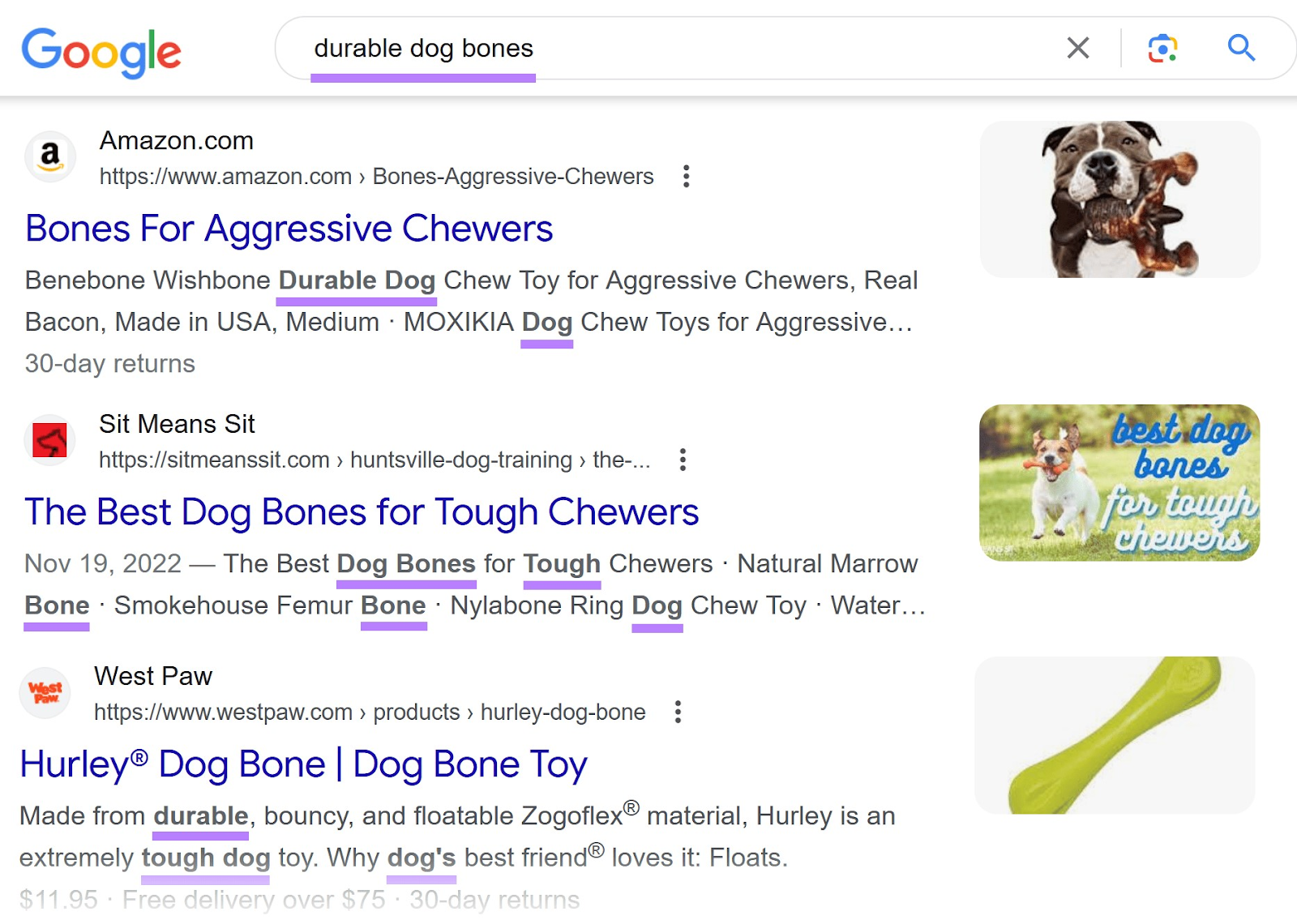
Because your competitors are on there, and, based on the search results, searchers are looking for dog toys that last a long time.
On the other hand, you don’t need to be too fussed about ranking for “dog chews.”
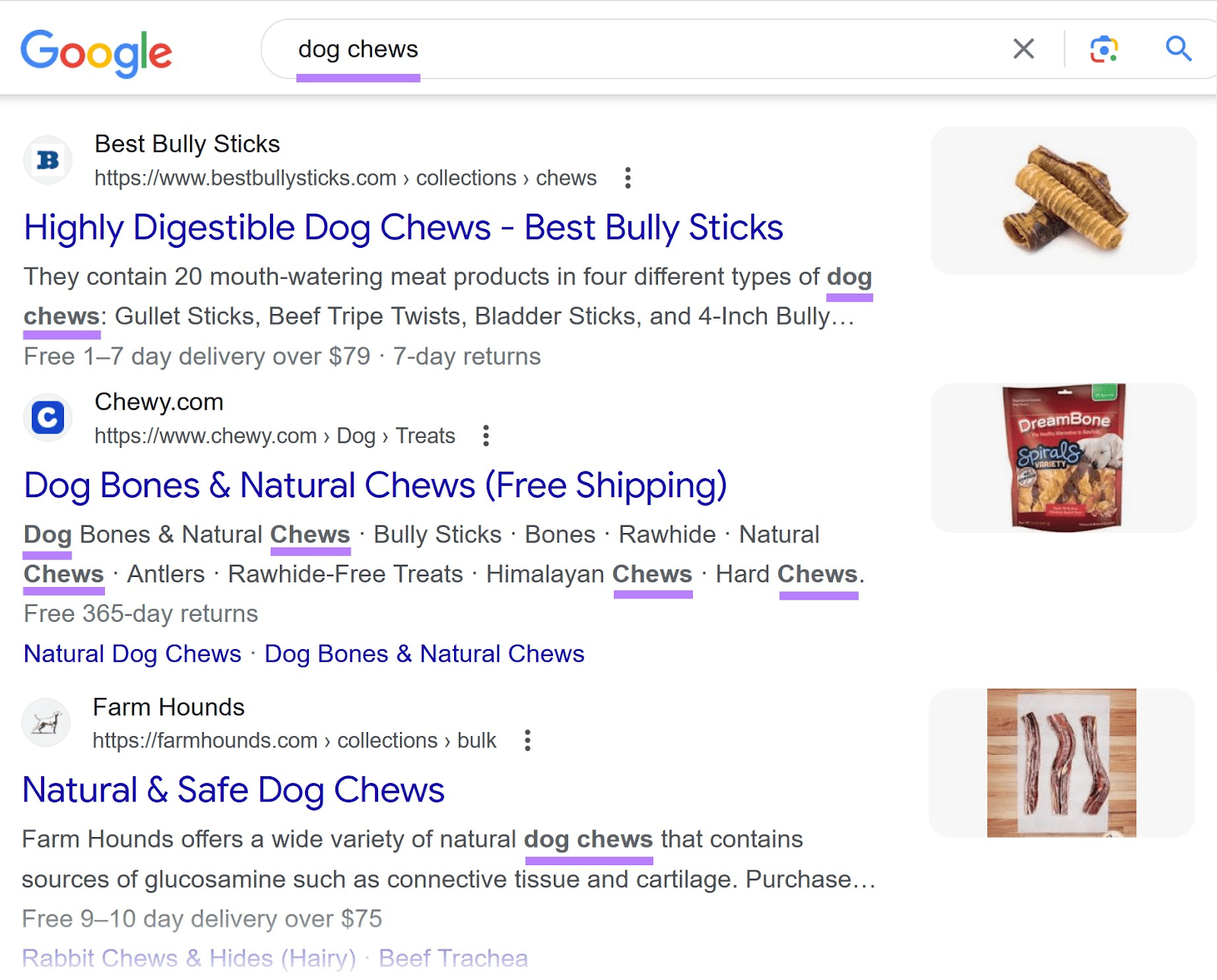
Because the results show dog treats, not toys. Which you don’t offer.
In other words, you want to target keywords that:
- Your target audience actually searches for
- Contribute to your content and business goals
- Get enough searches per month
- Aren’t too hard to rank for
Instead of manually looking for that data (which is very difficult, if not impossible), you can use tools to get that data in one click. And in a single dashboard.
Here’s how that works.
Let’s say you own a pet shop. And want to get the word out about your new durable dog bones.
Enter your product, “dog bone,” into the Keyword Overview tool. And hit “Search.”
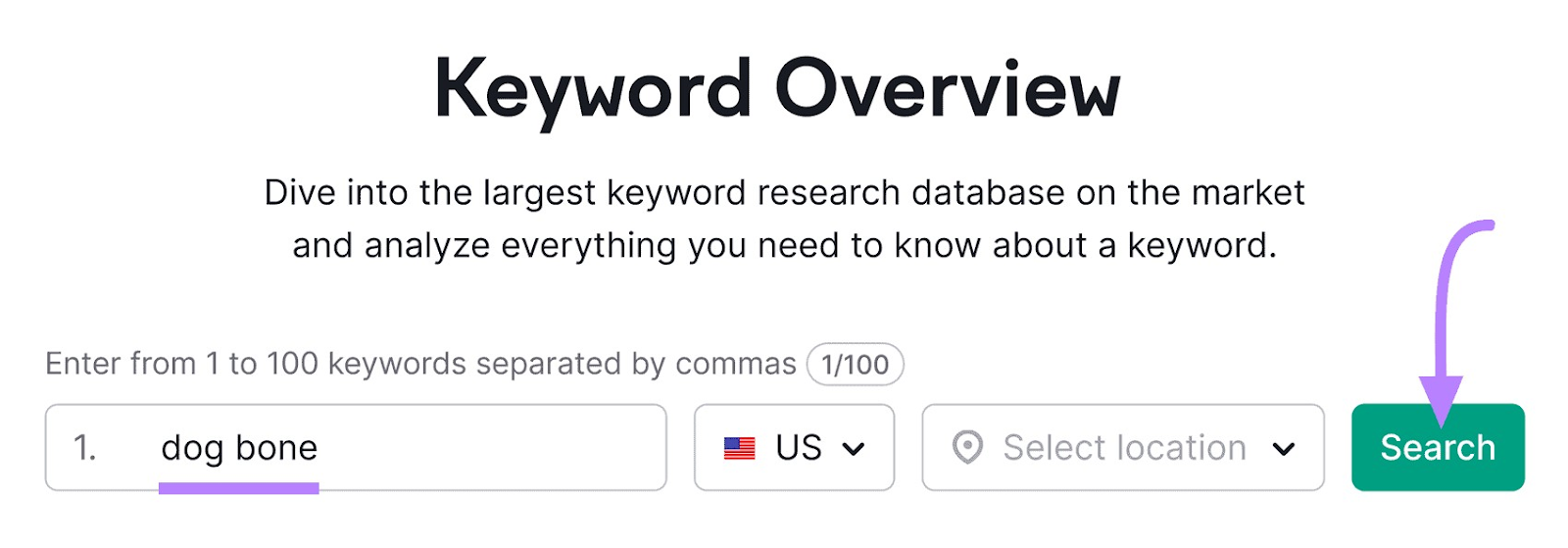
The tool will pull up all the information you need to know about your keyword. Including more keyword ideas and related questions.
And a link to the Keyword Manager tool where you can find keyword clusters.
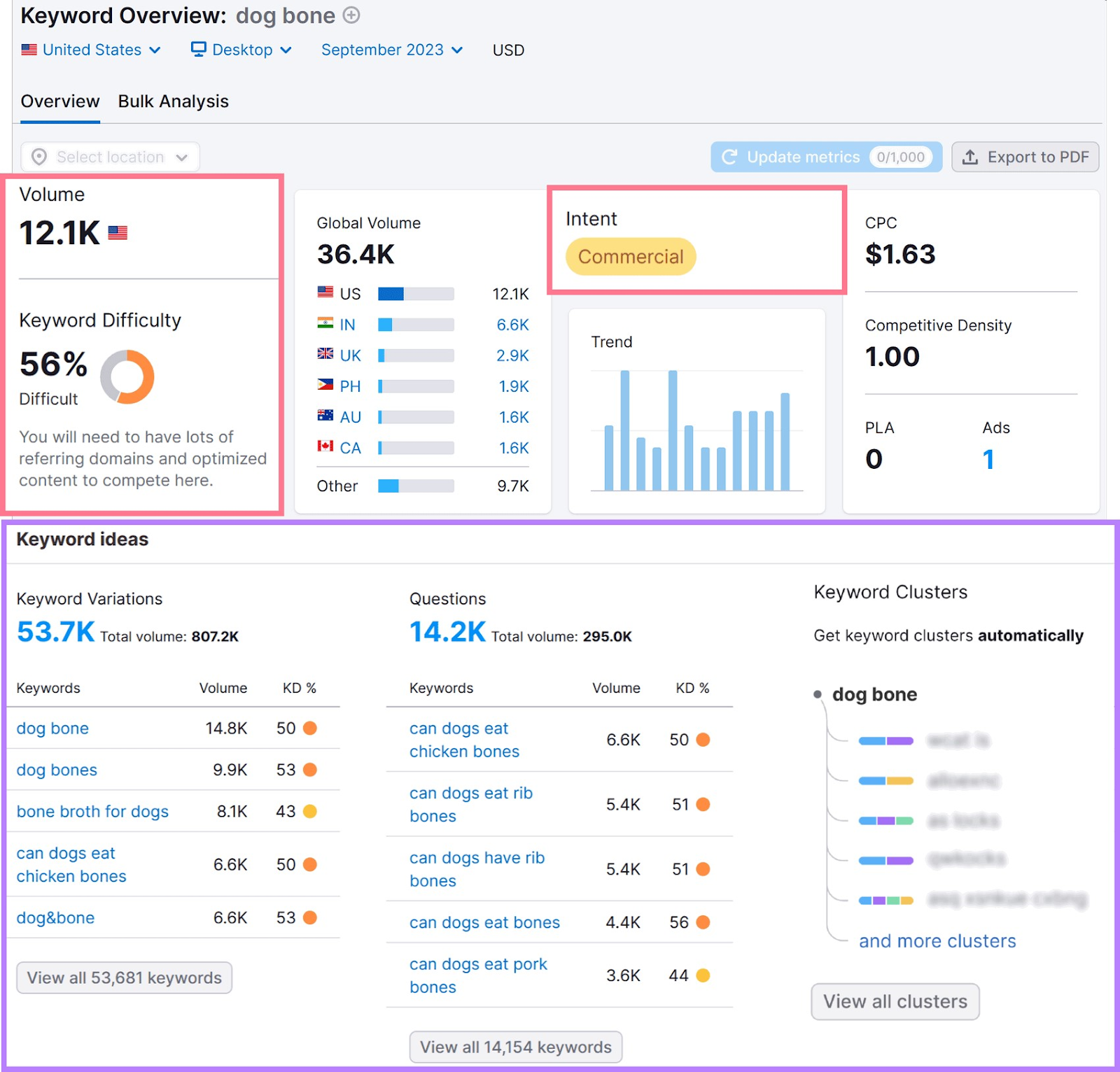
Here are key pieces of information to take note of in this dashboard:
- Search volume is the estimated number of searches a keyword gets per month on Google
- Keyword difficulty is a gauge of how easy or difficult it is to organically rank for a keyword
- Intent is the motivation behind why a searcher uses a specific keyword
- Keyword variations and Questions give you more options for keywords to target
From this dashboard, we can tell immediately that “dog bone” is a potential good fit. But with keyword difficulty of 56%, it will be quite hard to rank for.
So, let’s look at the keyword variations. Click on “View all # keywords” under the “Keyword Variations” section to get redirected to the Keyword Magic Tool.
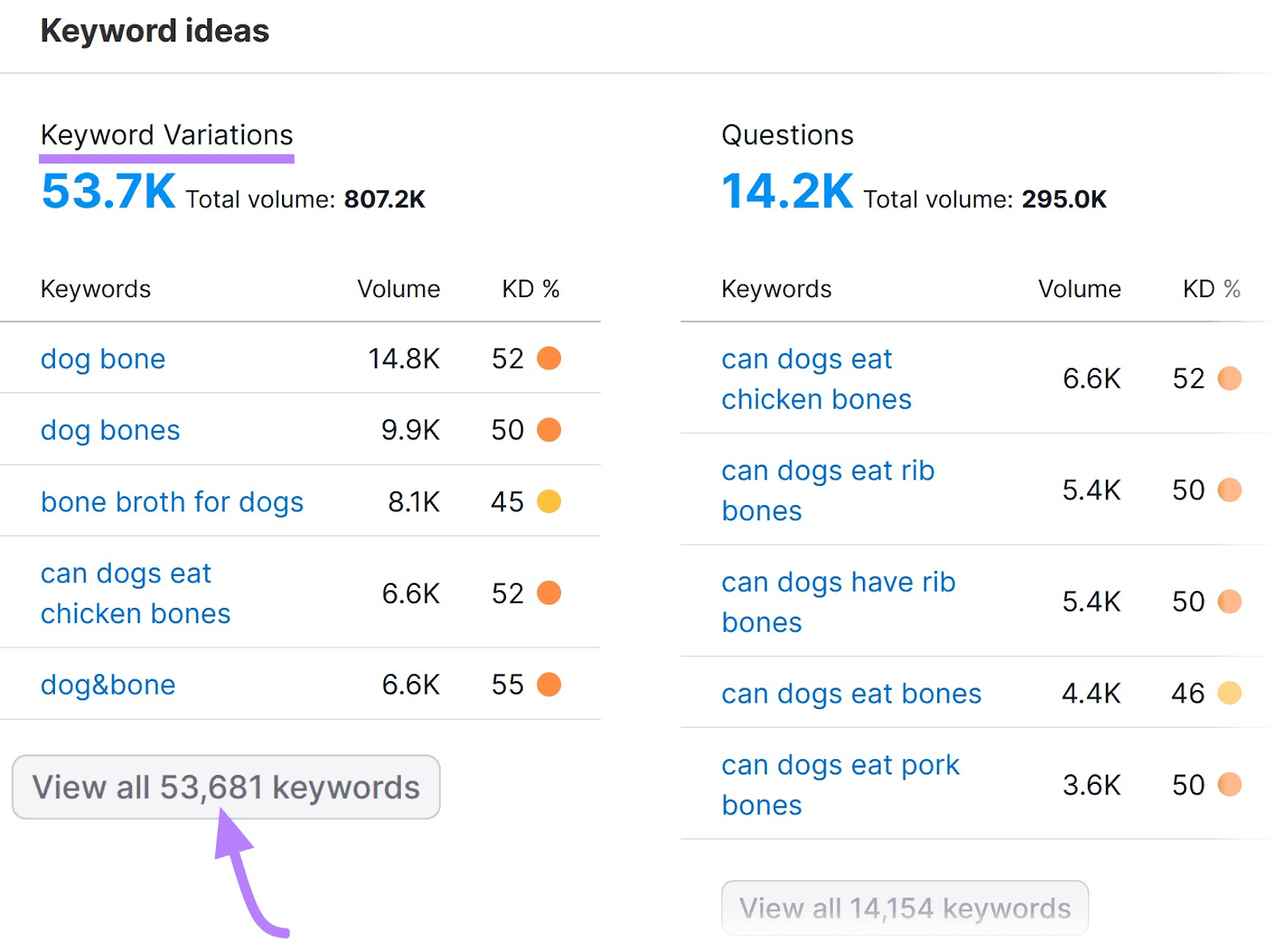
Then, use filters to narrow down your list of keywords. Here are the specific settings you need:
- Set the “from” field in the Volume filter to 100
- Set the “to” field in the KD% filter to 49%
- Set the intent filter to “Commercial” since your goal is to sell your product
Now, you have a list of keywords to choose from that you can create content for.
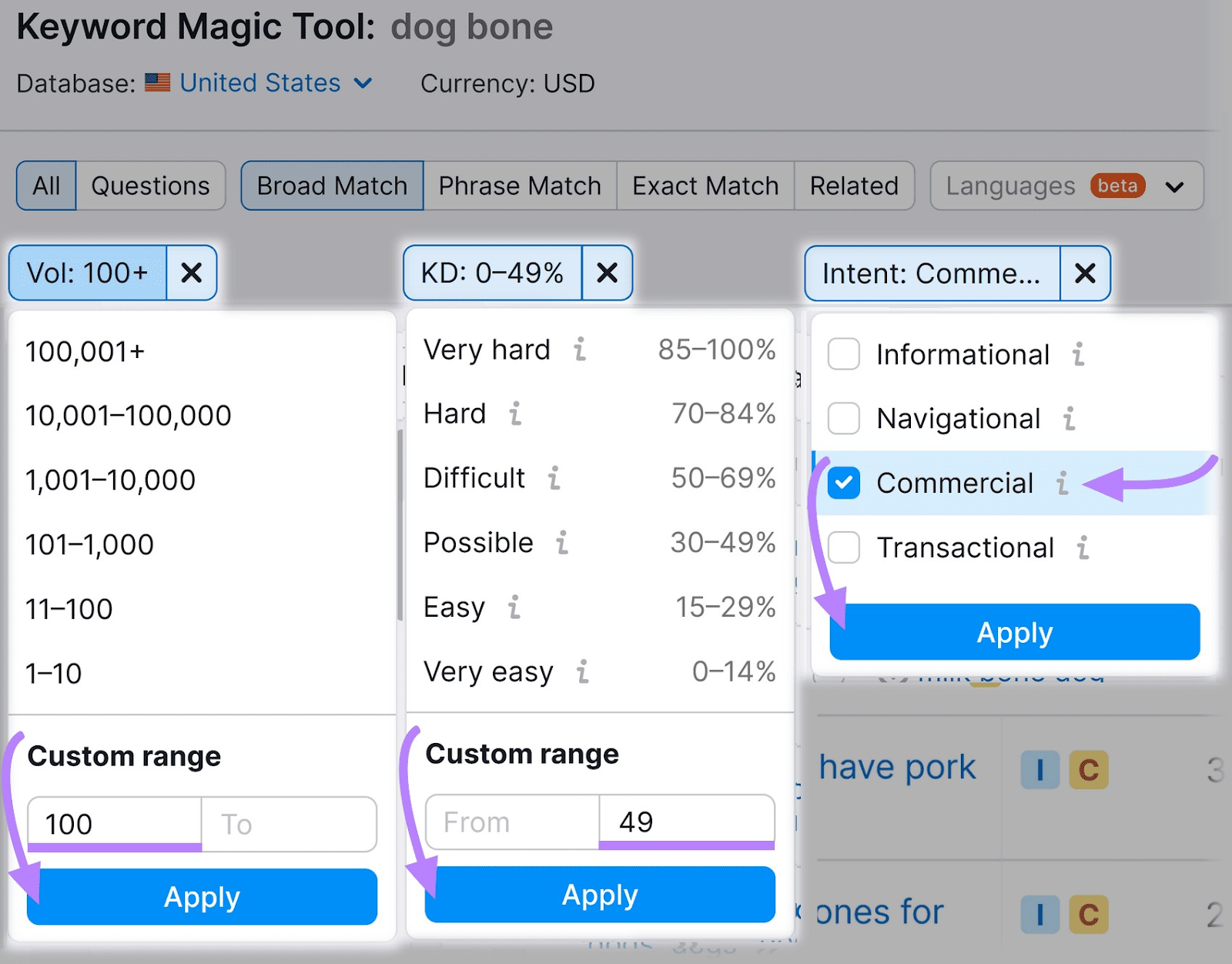
A quick look at the list shows you that “best dog bones” might be a keyword worth considering.
It has a search volume of 1,300, and it’s easy to rank for since it only has a 26% keyword difficulty.
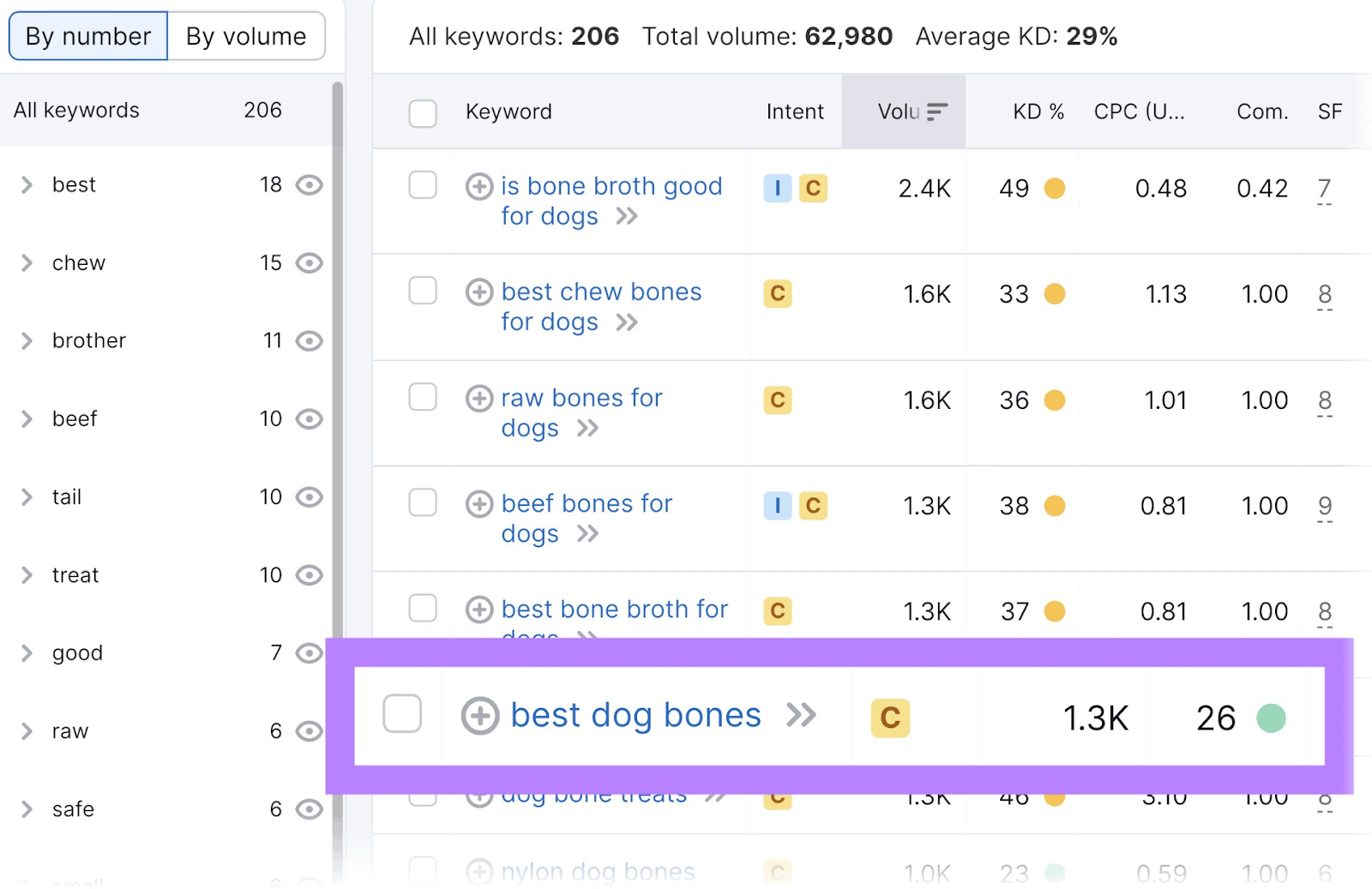
Semrush periodically updates its keyword database. So, check on your keywords regularly with the Keyword Magic Tool to continue getting more ideas.
2. Idea Generation & Topic Clustering
Now that you have your keyword, you can find content ideas easily. You can do it manually by plugging your chosen keyword/s into Google and looking at what other people are doing.
But again, that takes time and effort. And search results change on a regular basis. So they’re not always the best compass when it comes to finding trending ideas.
Instead, let’s use the Keyword Manager tool to automate your idea generation in a few clicks. And go one step further by generating topic clusters to build your authority around your target keyword.
Go to the tool and click on “Create list.”
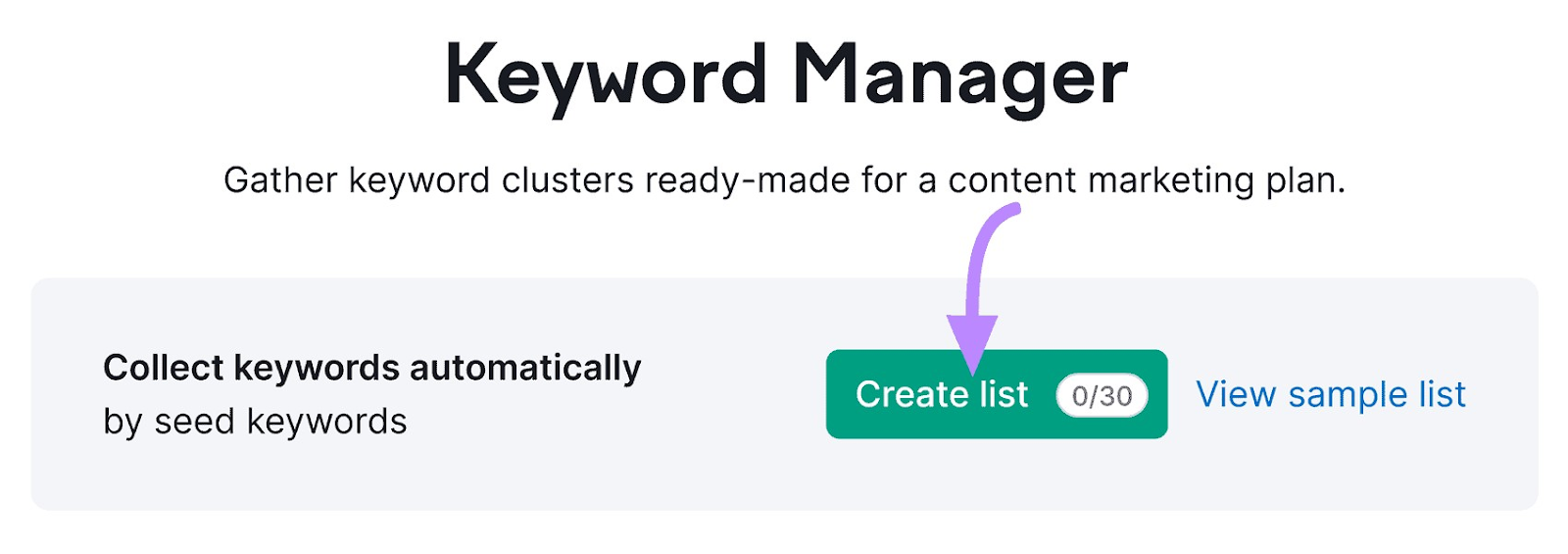
Then, enter five related keywords from the list you created in step one. Choose your location or database and enter your domain.
And click “Create list.” The tool will take a few minutes to serve up the best ideas for topic clusters.
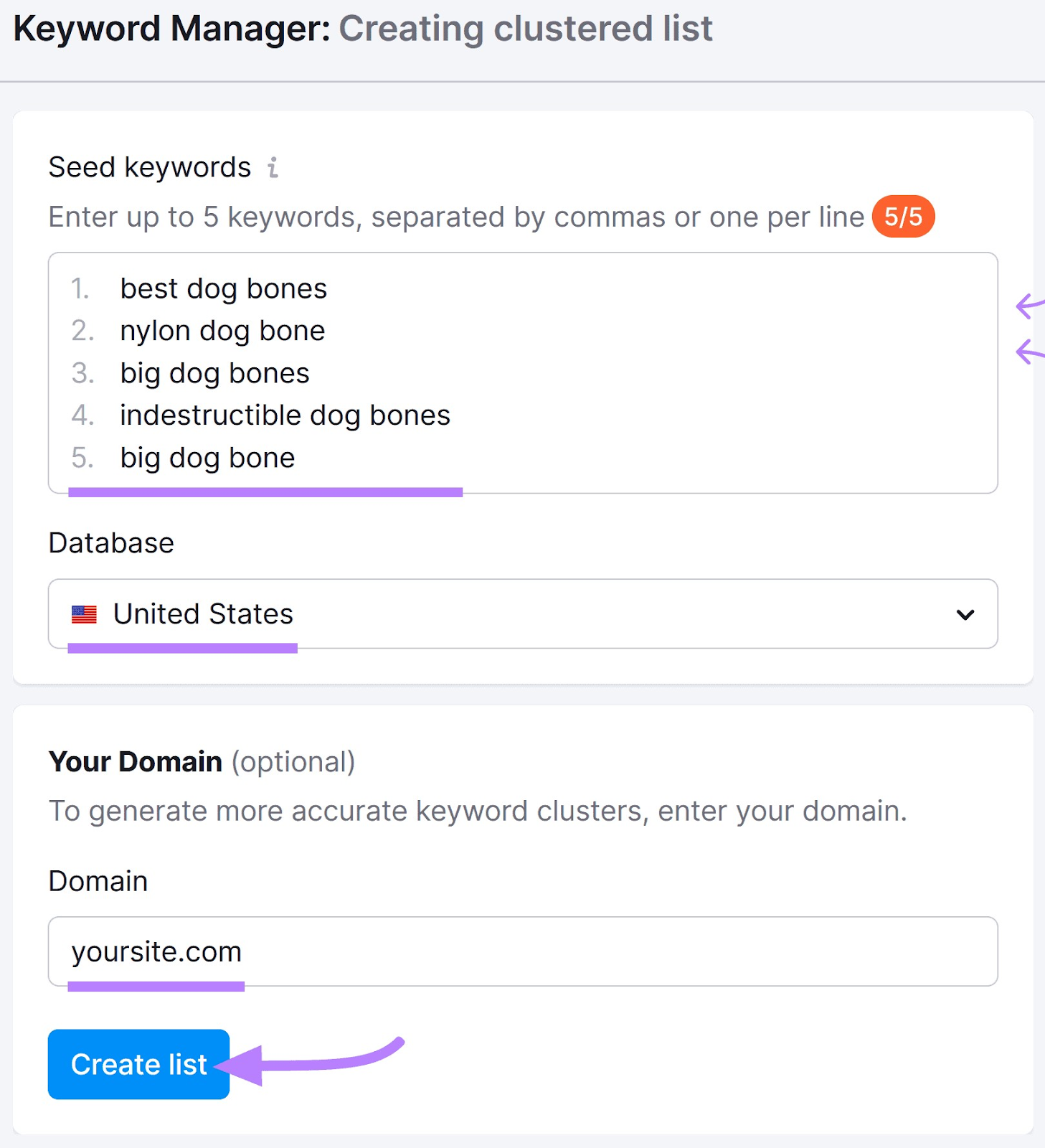
And now, you have a list of ideas to choose from. With three topics with the highest ranking potential at the top.
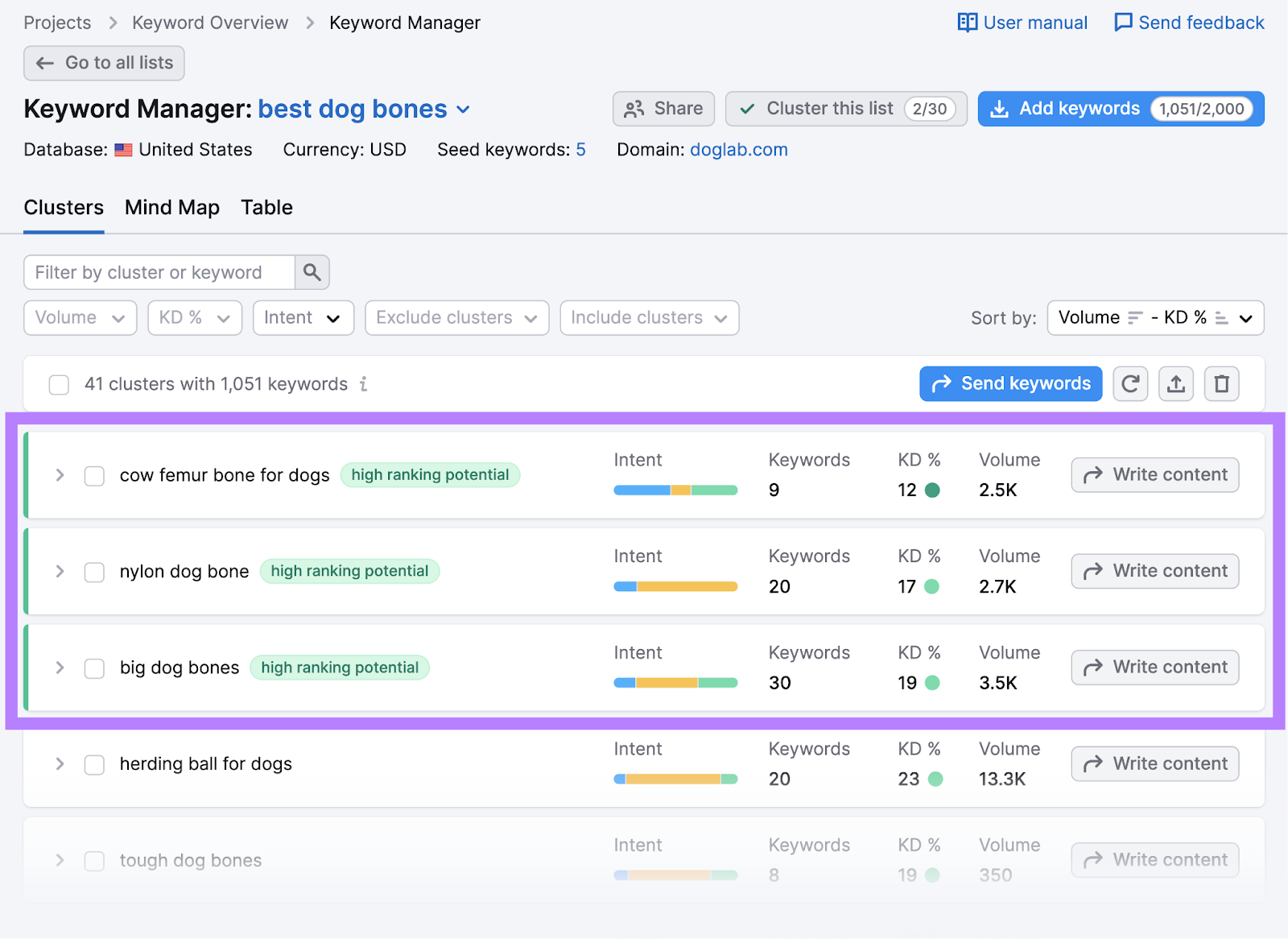
Click on one of the ideas to get more keyword information, content references, and secondary keywords.
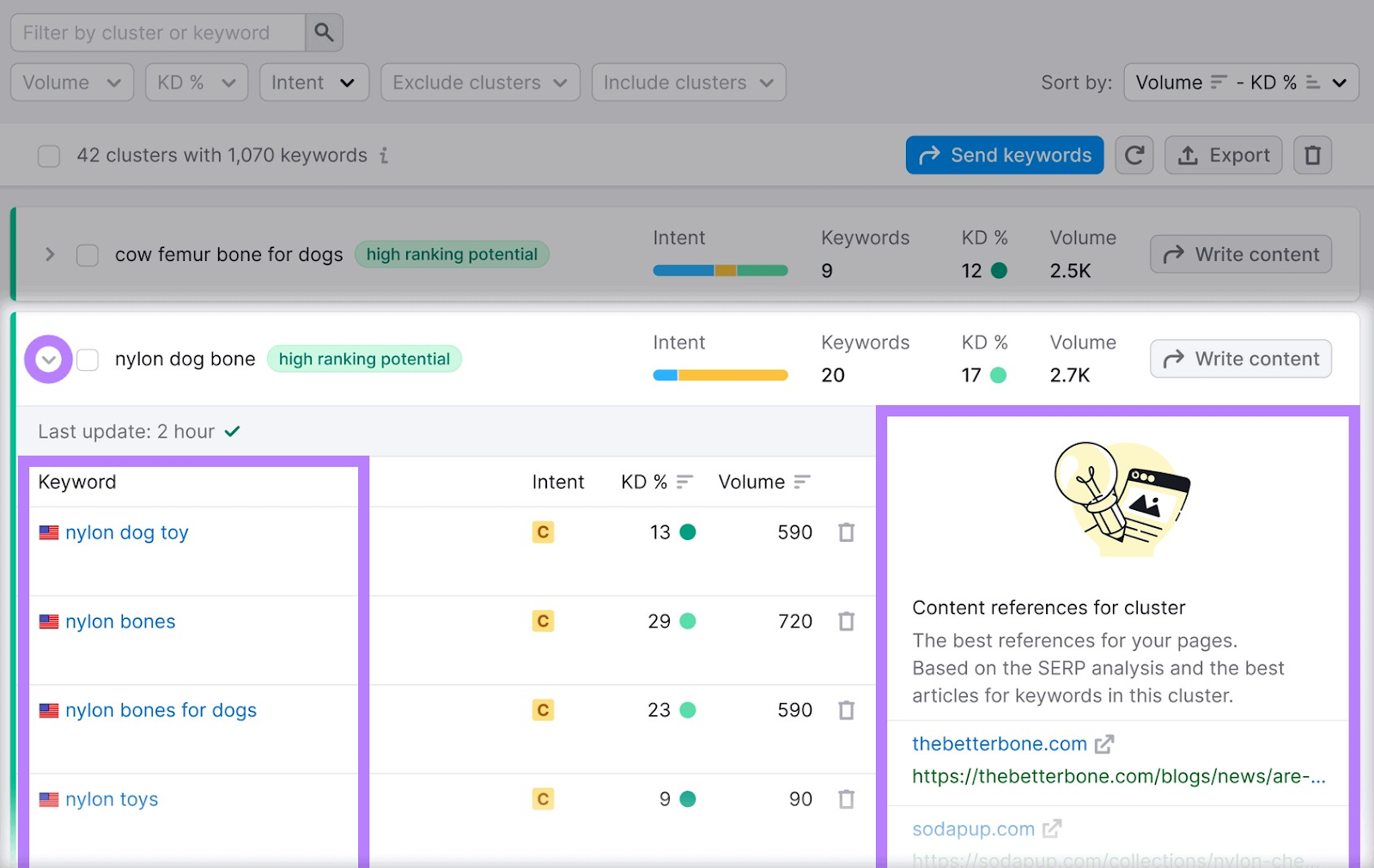
When you’ve chosen a topic you want to write about, click on the “Write content” button to the right of the row.
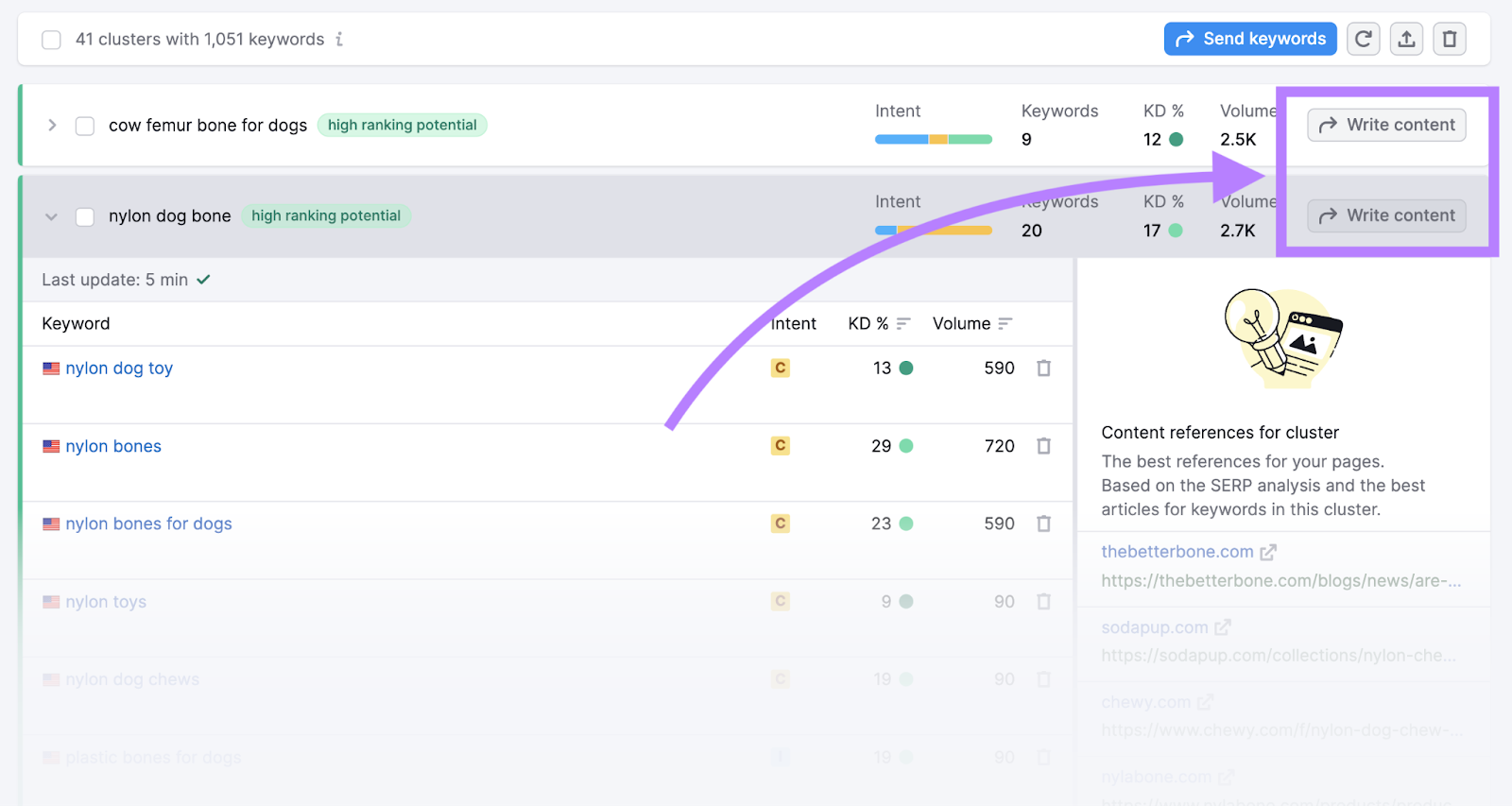
And check out the “Mind Map” tab to see how you can gain authority for your target keyword.
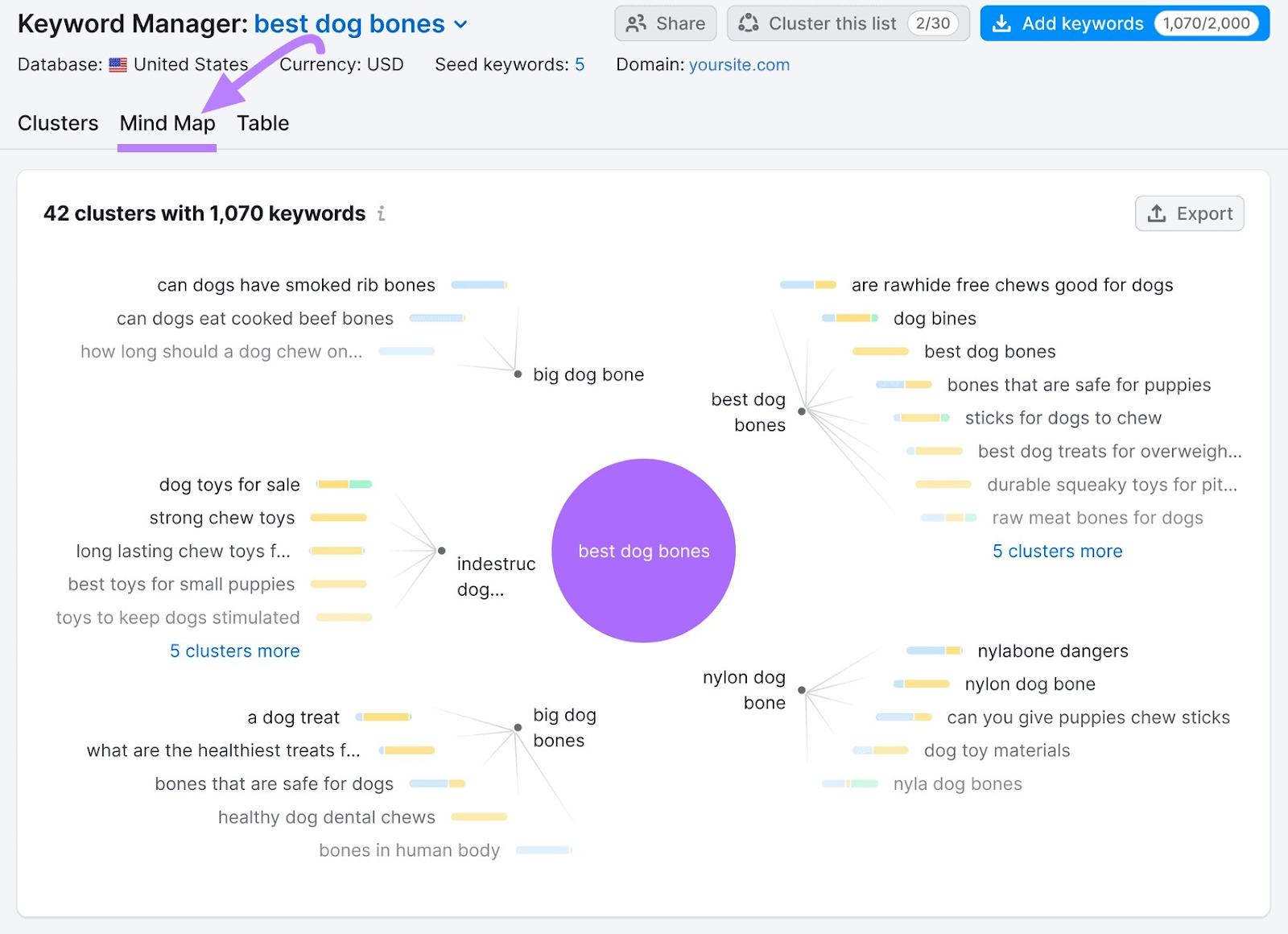
Now that you have your ideas, it’s time to create content.
3. Content Creation
Content creation is brain-intensive work. Because your content needs to be interesting, engaging, and relevant to your target audience. While also maintaining a high level of accuracy.
If you did the first two steps, then you already have a ton of content ideas. Now, all that’s left is to write.
Luckily, automation can help in two ways.
First, it can check out content you’ve written manually.
When you click on “Write content” within the Keyword Manager tool, you’ll get redirected to the SEO Writing Assistant.
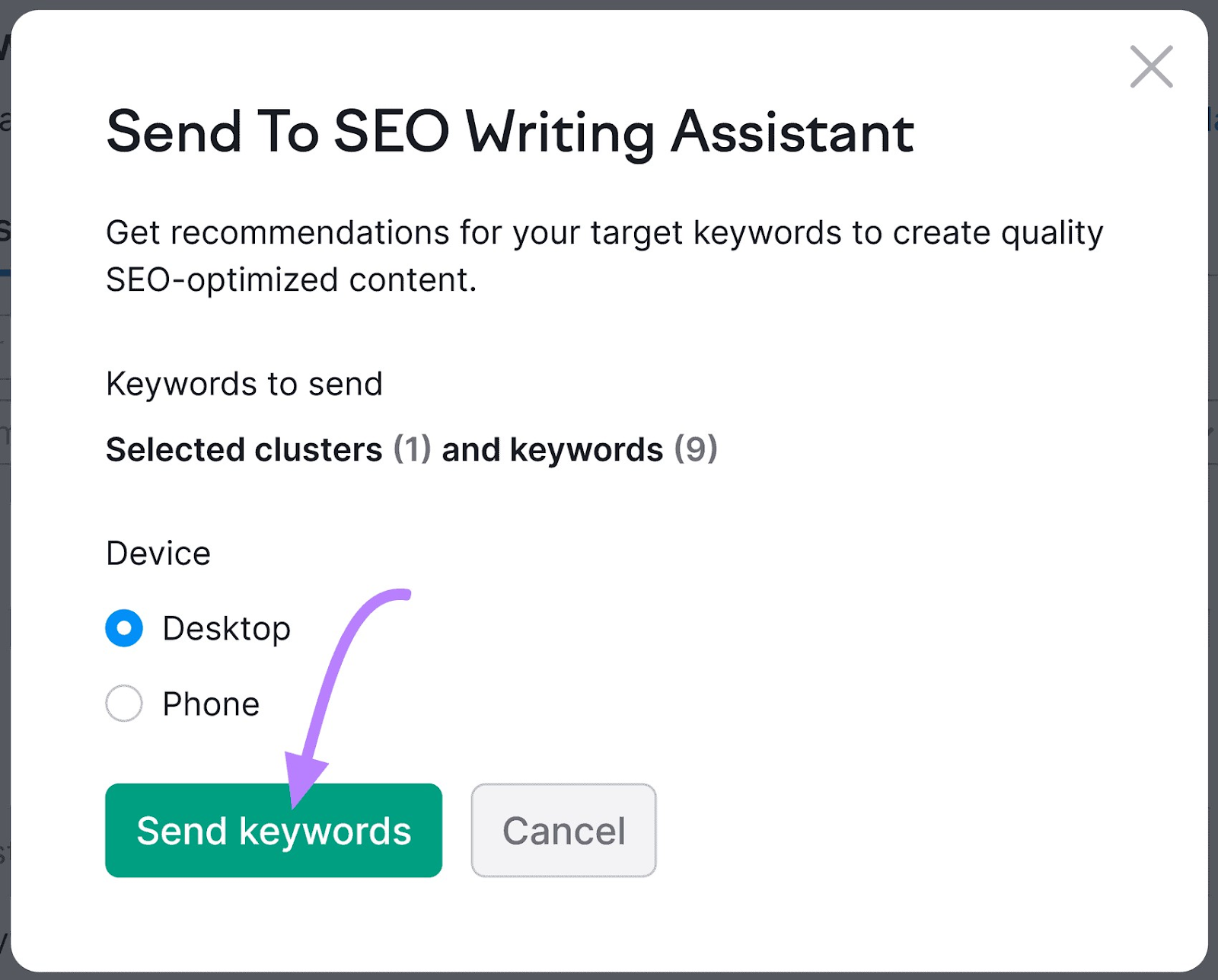
From there, you can paste your text into the space provided. And the tool will check your content for readability, SEO, originality, and tone of voice.
For example, the tool highlighted a hard-to-read sentence in our article about nylon dog toys.
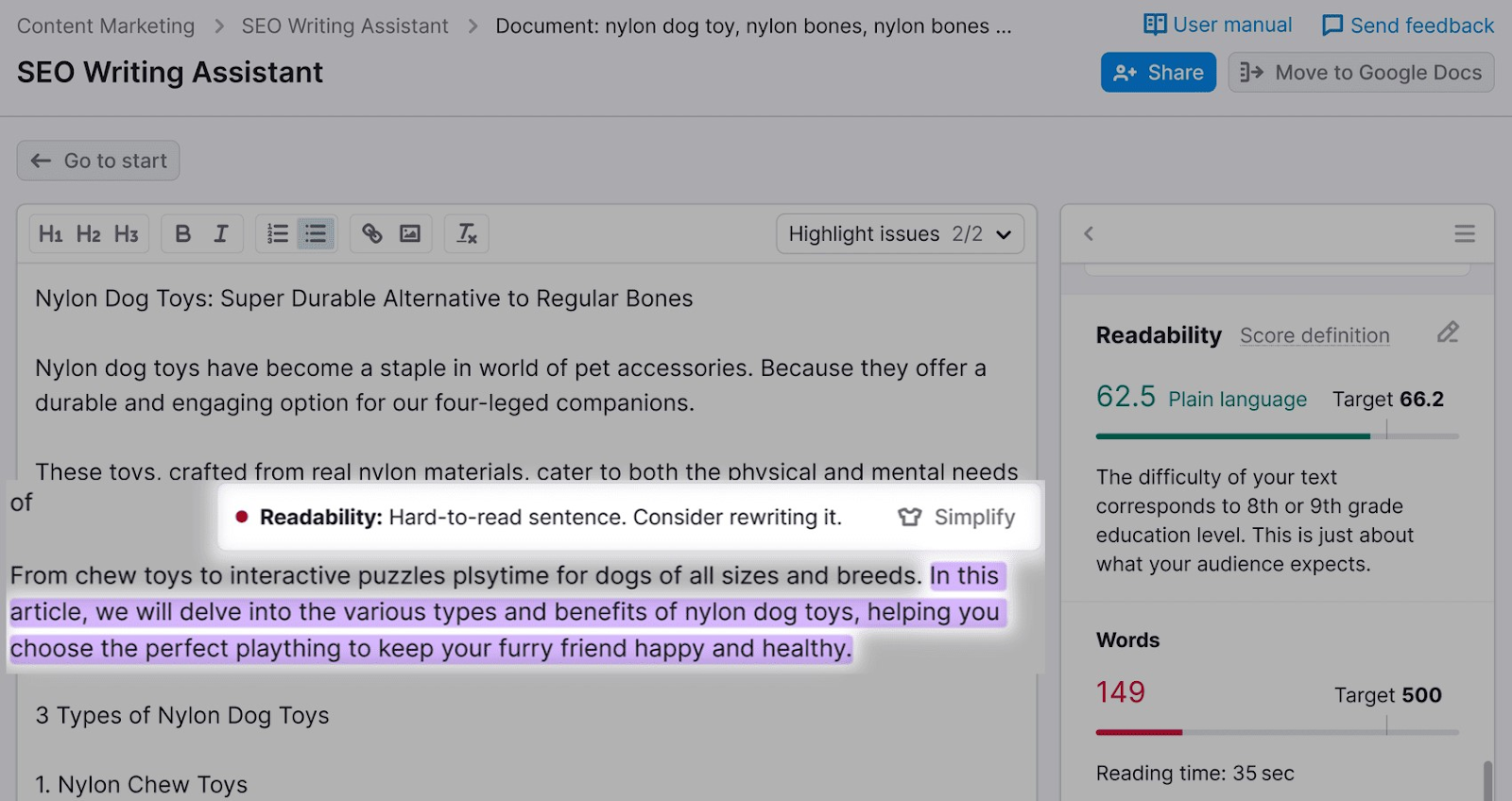
Second, it can generate content for you.
Simply type in your title or H2, and the tool will figure out what your topic is. And do the writing for you.
Simply click on the “Compose” button in the sidebar at the right of your screen.
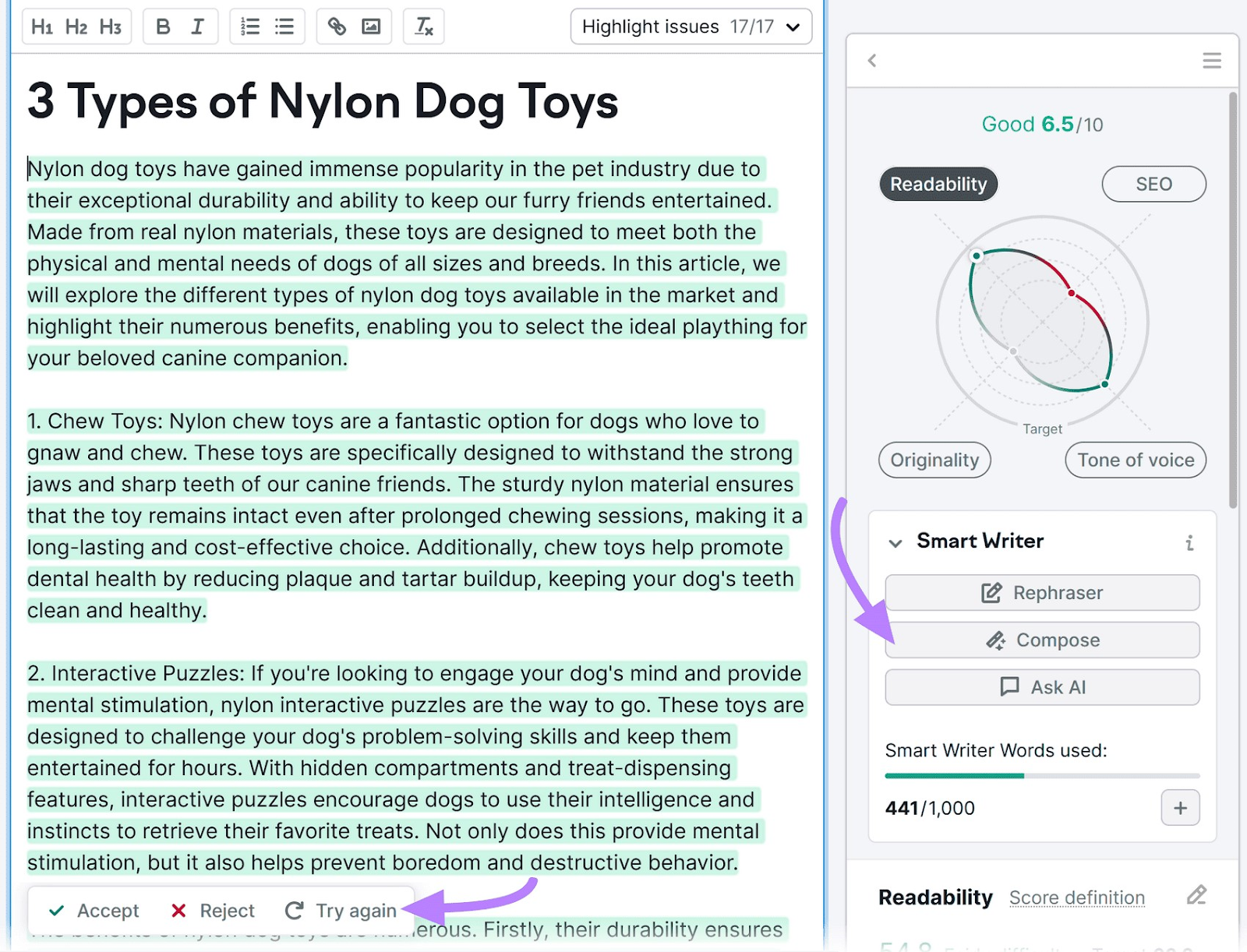
You can then accept the generated text, reject it, or ask the AI to try again.
Are the results perfect? No.
The software only serves up what it knows (based on existing data), so you won’t ever get fully original ideas.
But you do get a nice starting point. Which saves you time on content, SEO research, and SEO brief creation.
Be sure to edit the text for accuracy and tone of voice. And personalize it to your readers and target audience.
Pro tip: Check out full-suite content generation tools like ContentShake AI. That can generate your whole article.
This is what ContentShake AI generated for an article on “pet toys”:
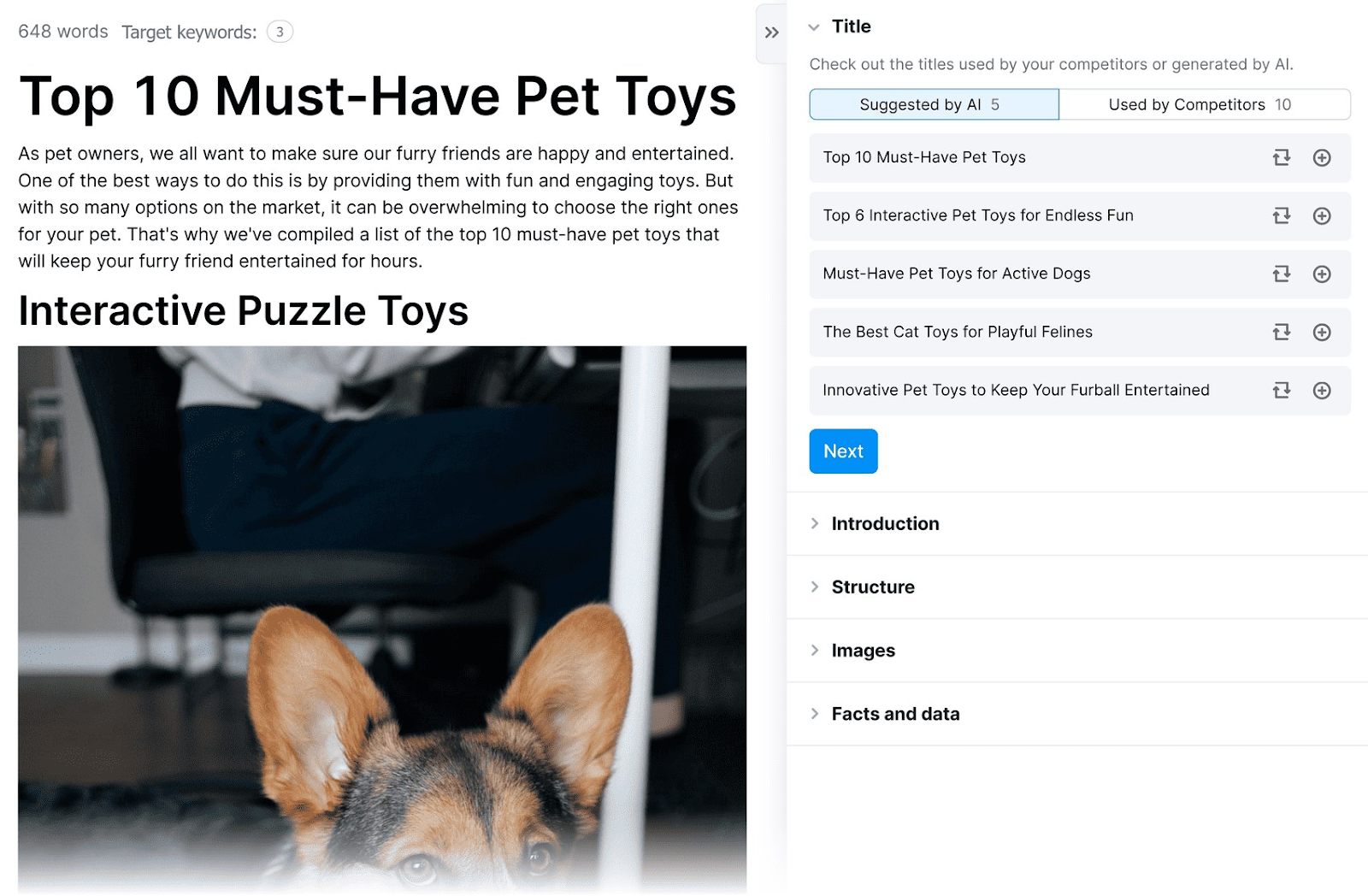
The tool generates content based on the top results for your target keywords.
So you get search-optimized content. And in a shorter amount of time compared to if you wrote everything from scratch.
4. Editing and Proofreading
Automation tools like Grammarly and Hemingway scan text for grammatical errors and misused words. They then suggest changes:
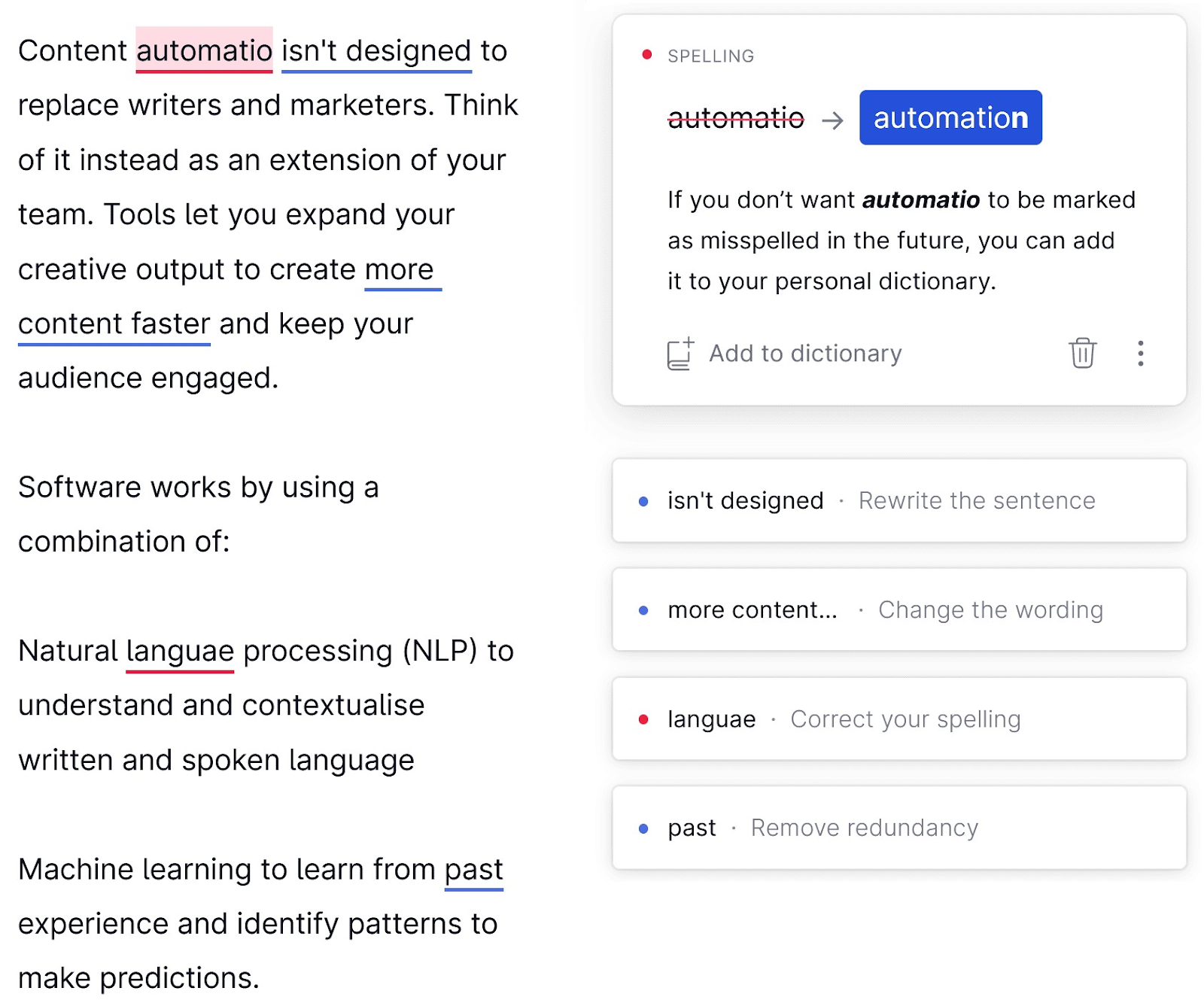
Hemingway takes things a step further by showing how to fix hard-to-read sentences. For example, it showed us how to simplify the text of this section (which we did):

There’s also a new version of Hemingway in beta where AI fixes the issues for you.
That helps cut down on the time you spend editing and proofreading. It also helps you spot errors you might otherwise miss.
5. Content Optimization
Content optimization ensures your content has the best possible chance of achieving its goal (e.g., to rank in search engines or convert leads).
Here’s a quick checklist that you can use to make sure that you’re following all the best practices:

But if you don’t want to optimize your content manually, you can definitely use a tool. Like the SEO Writing Assistant.
The tool looks at the top ten search results. And then checks out how your article compares in terms of SEO.
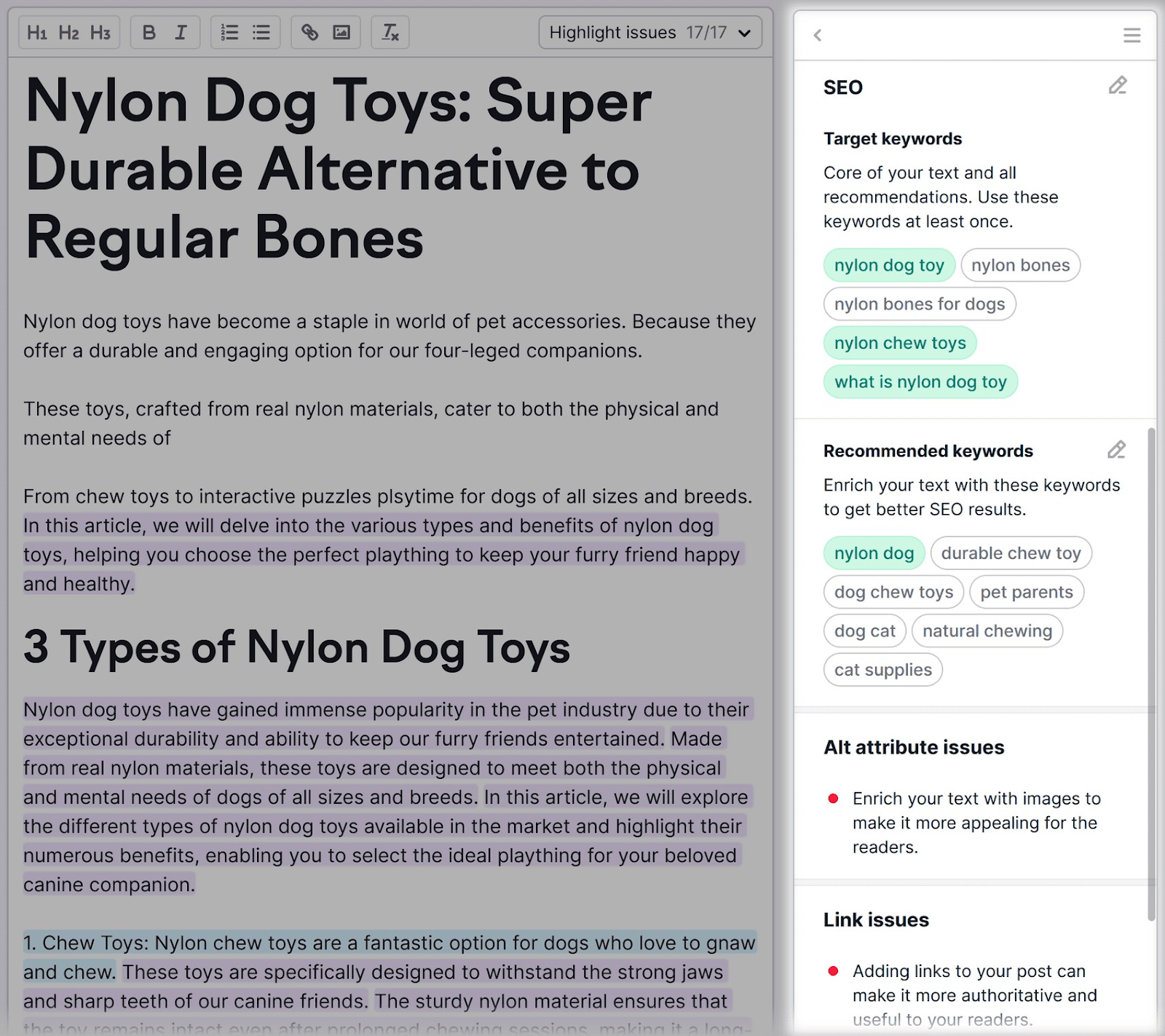
That way, you can easily identify where you can optimize your content to increase its chances of ranking.
6. Content Distribution
Content distribution happens when you promote your content on different platforms with the goal of reaching more people.
But posting on multiple platforms at just the right time, all at the same time can be difficult. Which is where content automation comes in.
Automation eliminates the time-consuming process of getting your content in front of the right audience at the right time.
Social media management tools can even use machine learning to recommend the best days and times to post on each channel for maximum engagement.
For example, Semrush Social’s Social Analytics tool tells you exactly when your followers are online on Facebook and Instagram.
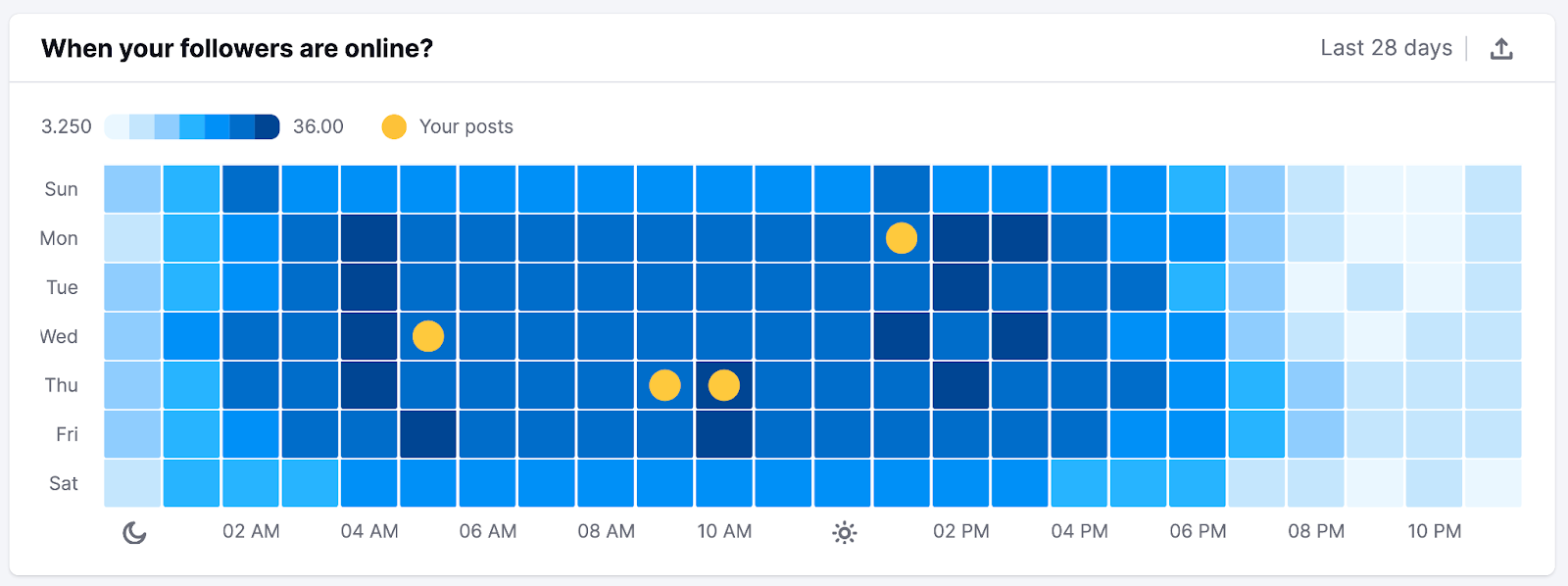
So that you know when the best time to post is.
Then, you can use Semrush Social’s post scheduler to schedule your post for those times. That way, there’s less chance of you forgetting to post at the right times.
Click on “Social Poster” in the sidebar.
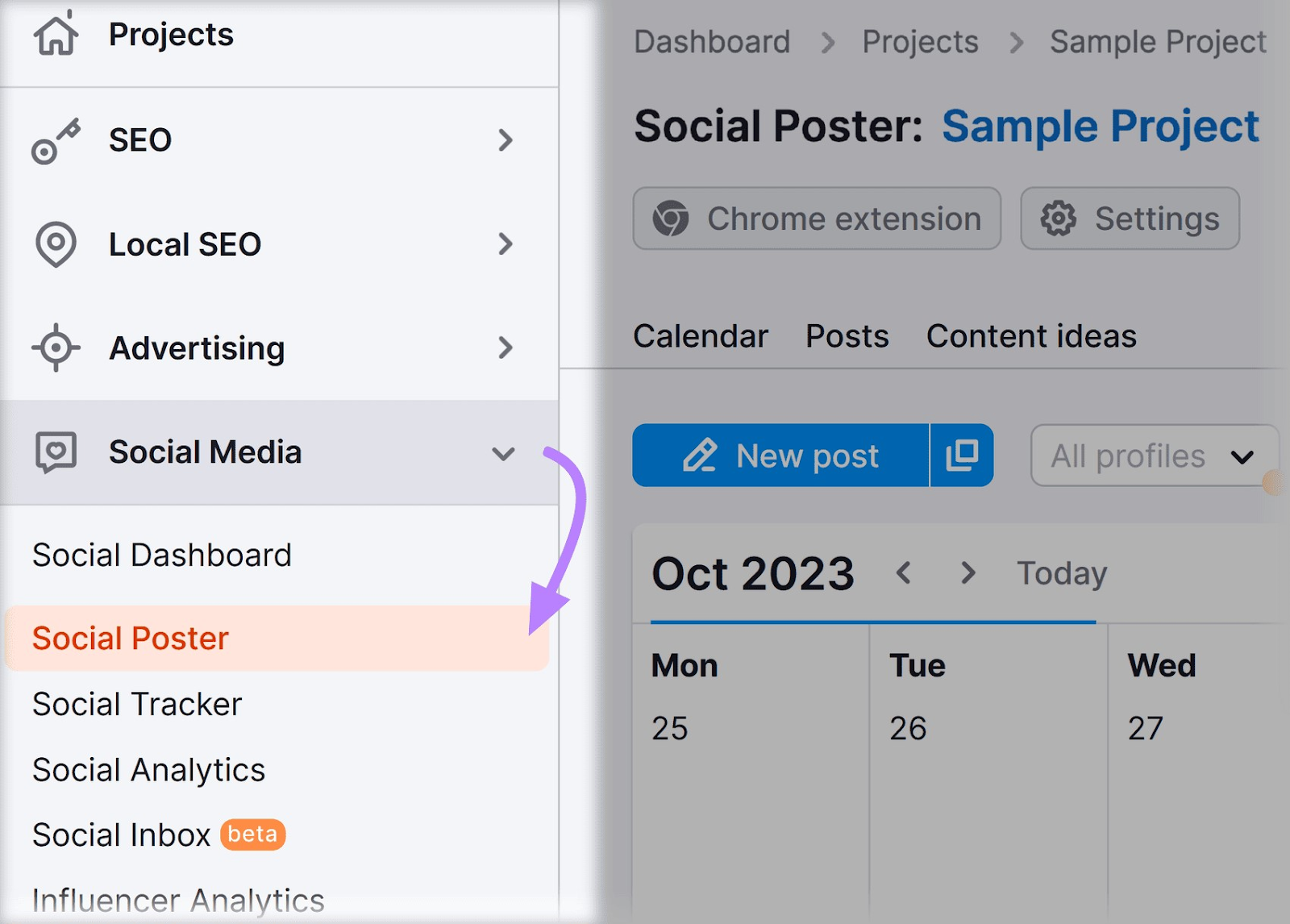
And connect your accounts to the tool if you haven’t already. By clicking “All profiles” > “Add profile” and following the prompts that appear.
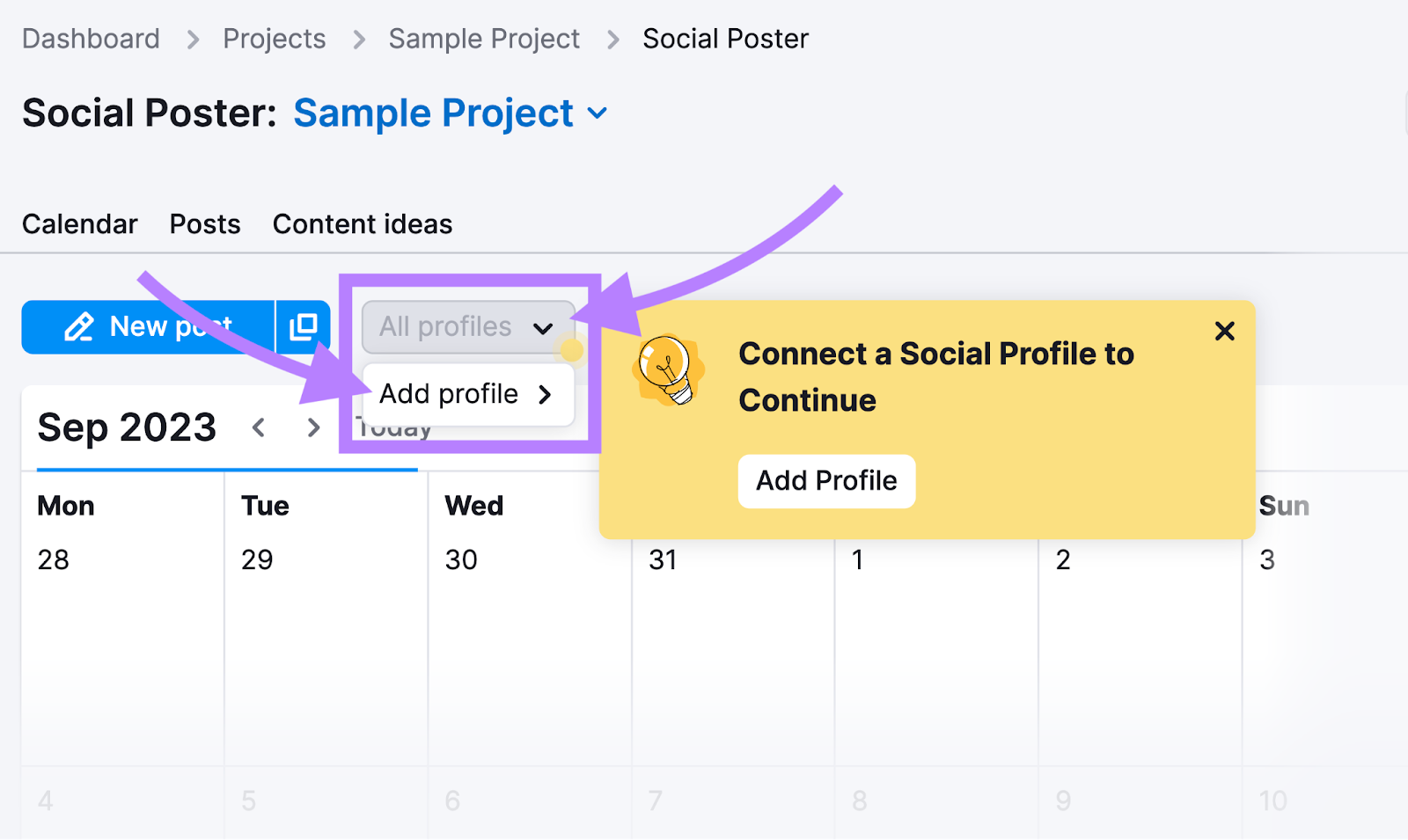
After you’ve connected your accounts, click on “New post.”
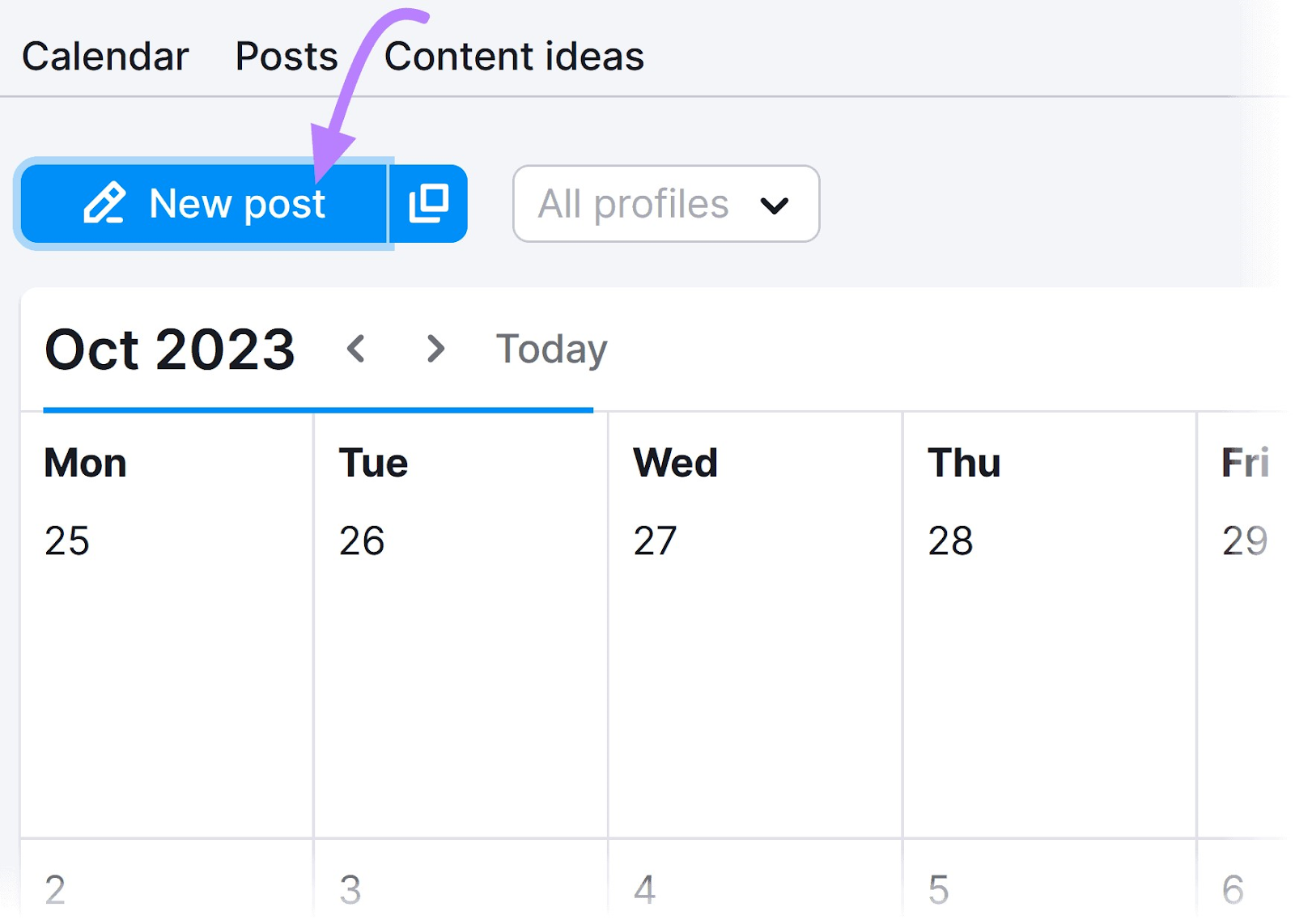
In the window that appears, select the accounts that you want to post to from the options at the top.
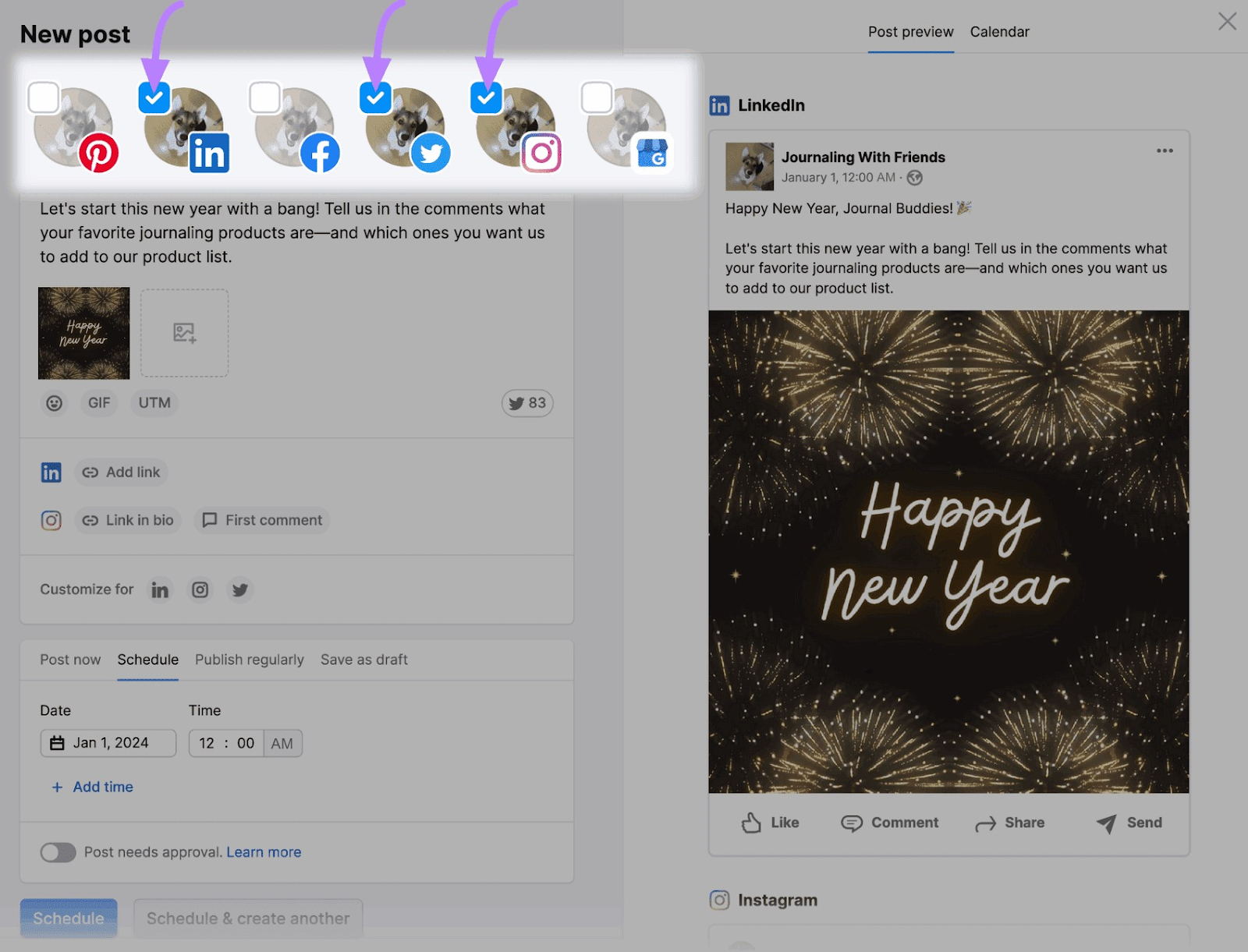
Create your post in the space provided. And check out the post preview.
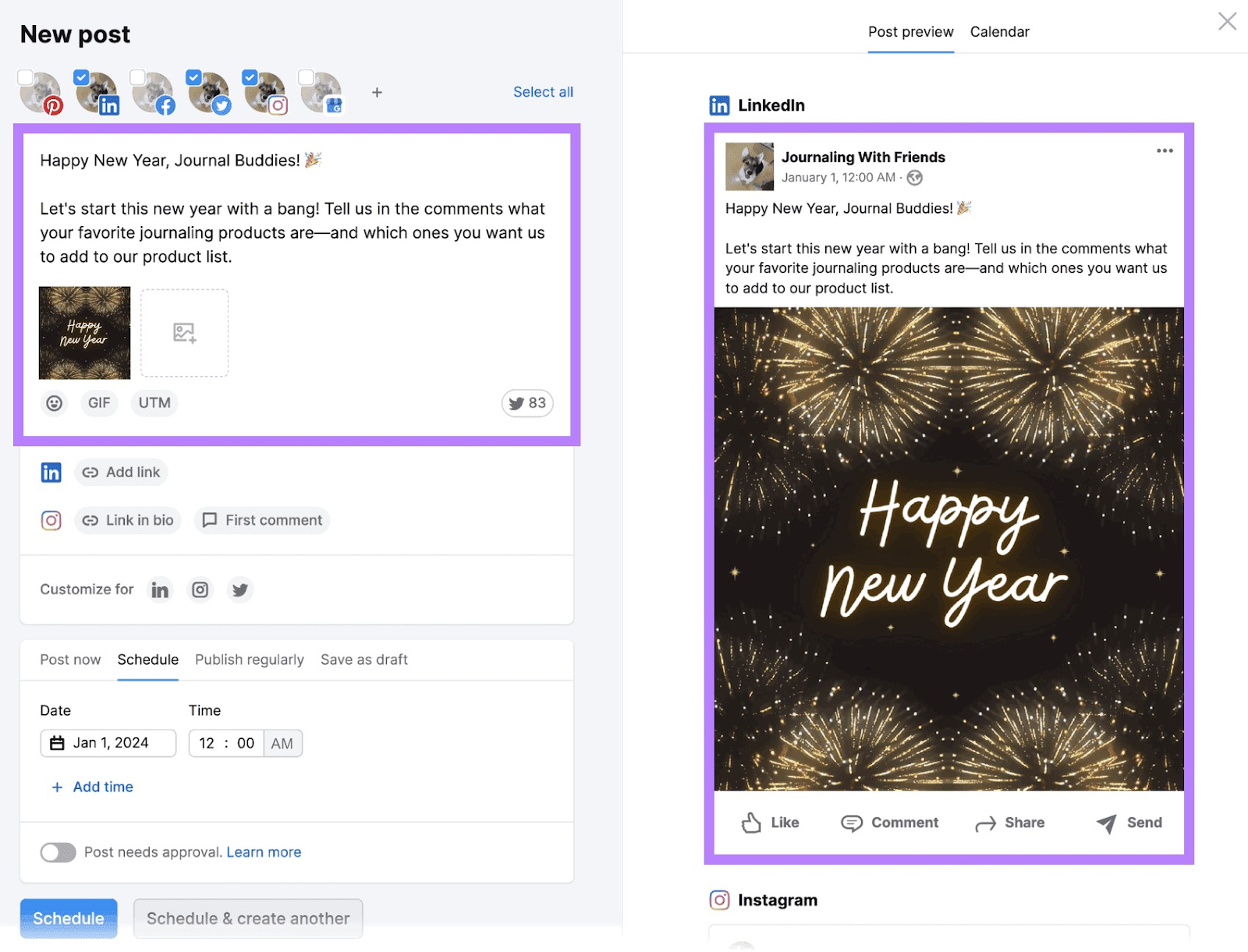
Now, it’s time to schedule your post. Click on the “Schedule” tab. And set the date and time that you want the tool to post your content.
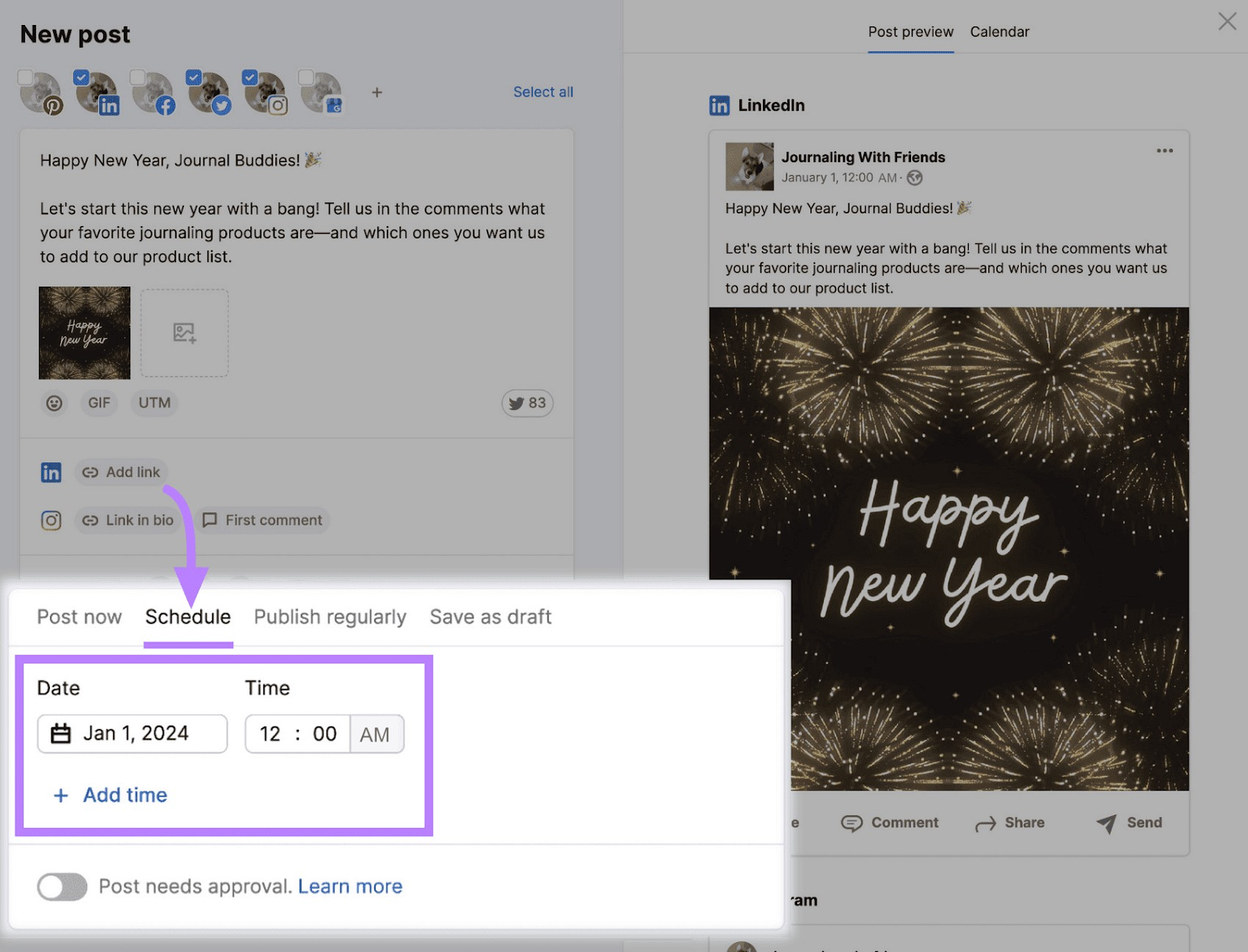
Click on “Schedule” and you’re done.
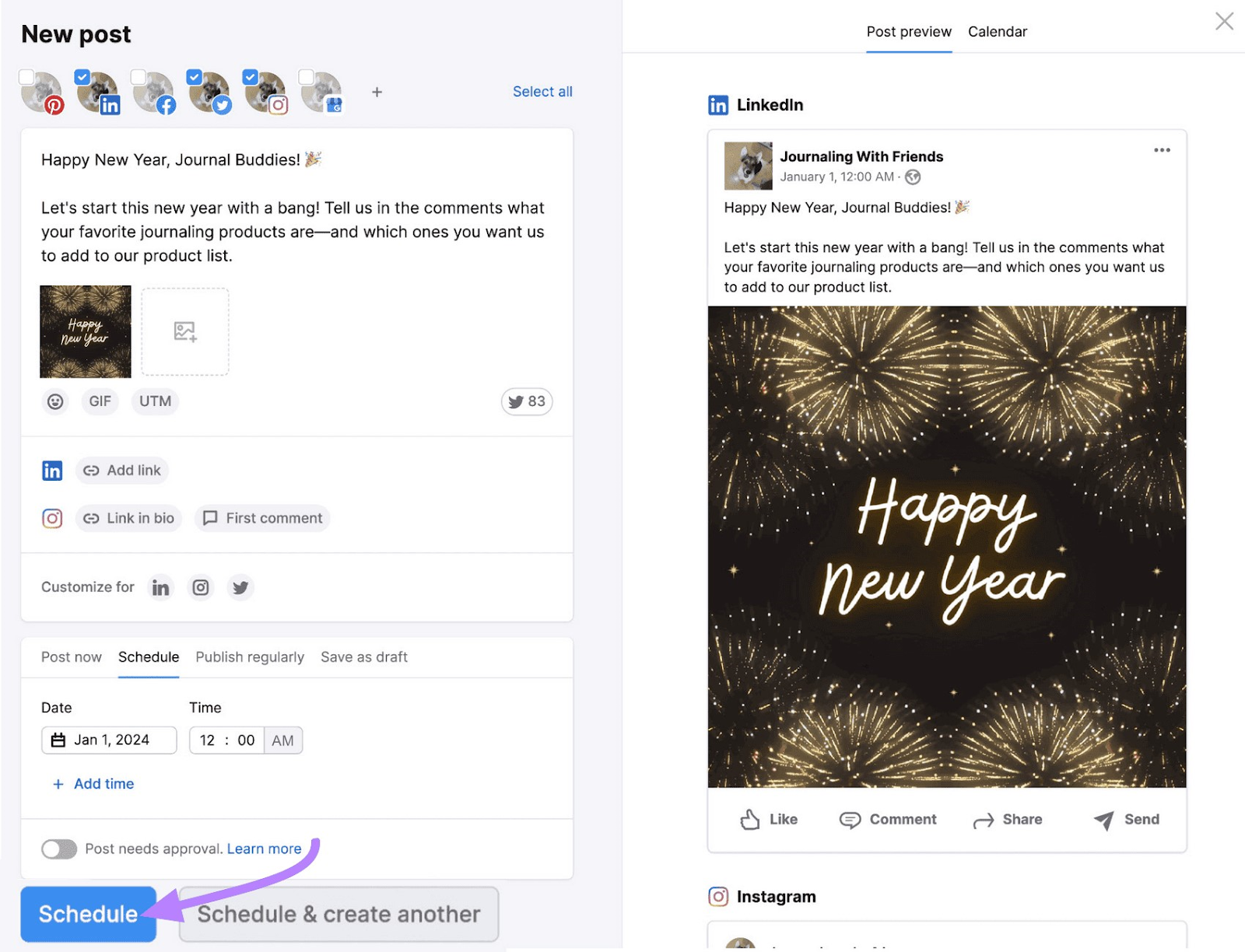
Now, your social post is all queued up. And will go live at the right time without you lifting a finger.
Another way to distribute content is through sending emails to your subscribers.
And you can automate your emails in the same way. Simply create your email content, link to the blog post that you want to promote, and then schedule the email with an automation tool like ActiveCampaign.
7. Content Analytics
Content analytics looks at how your content performs over time. So that you can quickly see if your content ranks for the right keywords. And pieces of content you need to update.
There are three tools we recommend for tracking your content performance.
Position Tracking
The Position Tracking tool scans search results for your target keywords on a regular basis. So that it can give you the following information:
- Your average position on the SERP
- Your exact position on the SERP on specific days
- How many of the tracked keywords you’re ranking for in the top 100
- Which keywords you’re ranking better for
- Which keywords you’ve lost positions for
- How you’re ranking compared to your competitors
The best part is, all you need to do is give the tool your domain and tell it which keywords you want to rank for. And it’ll do the rest for you.
Set up the tool by entering your domain. And then clicking “Set up tracking.”
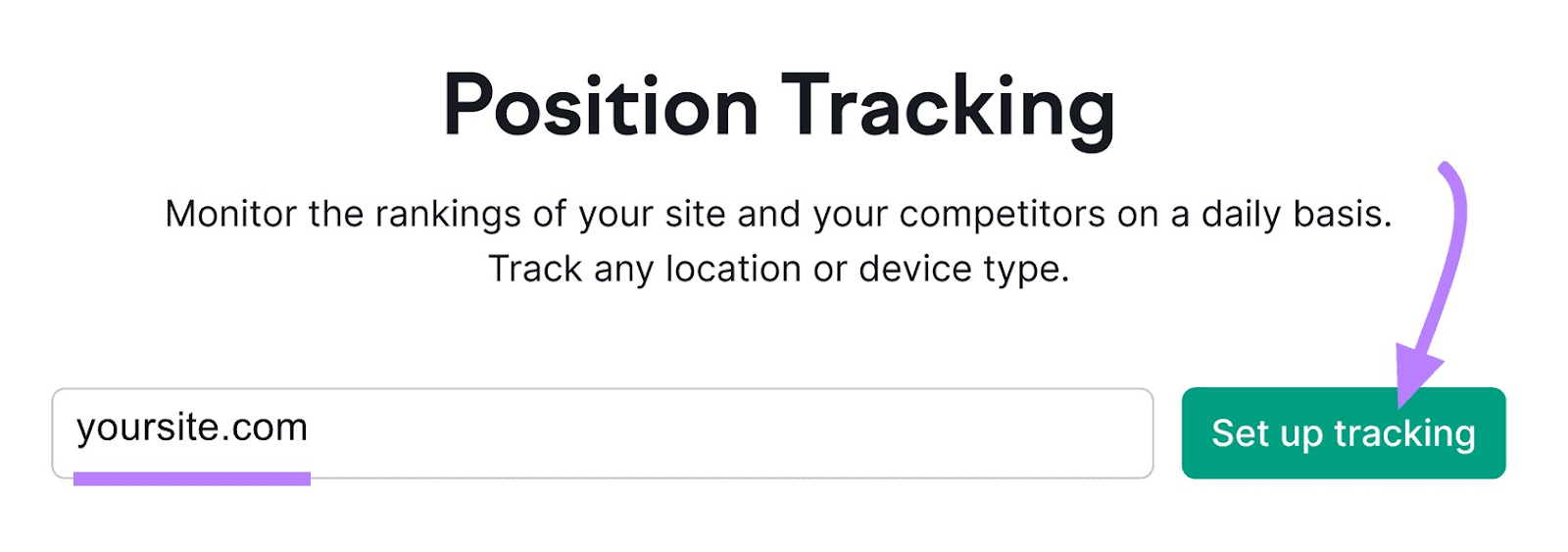
Then, select which search engine you want to target. And which device you want to track positions for.
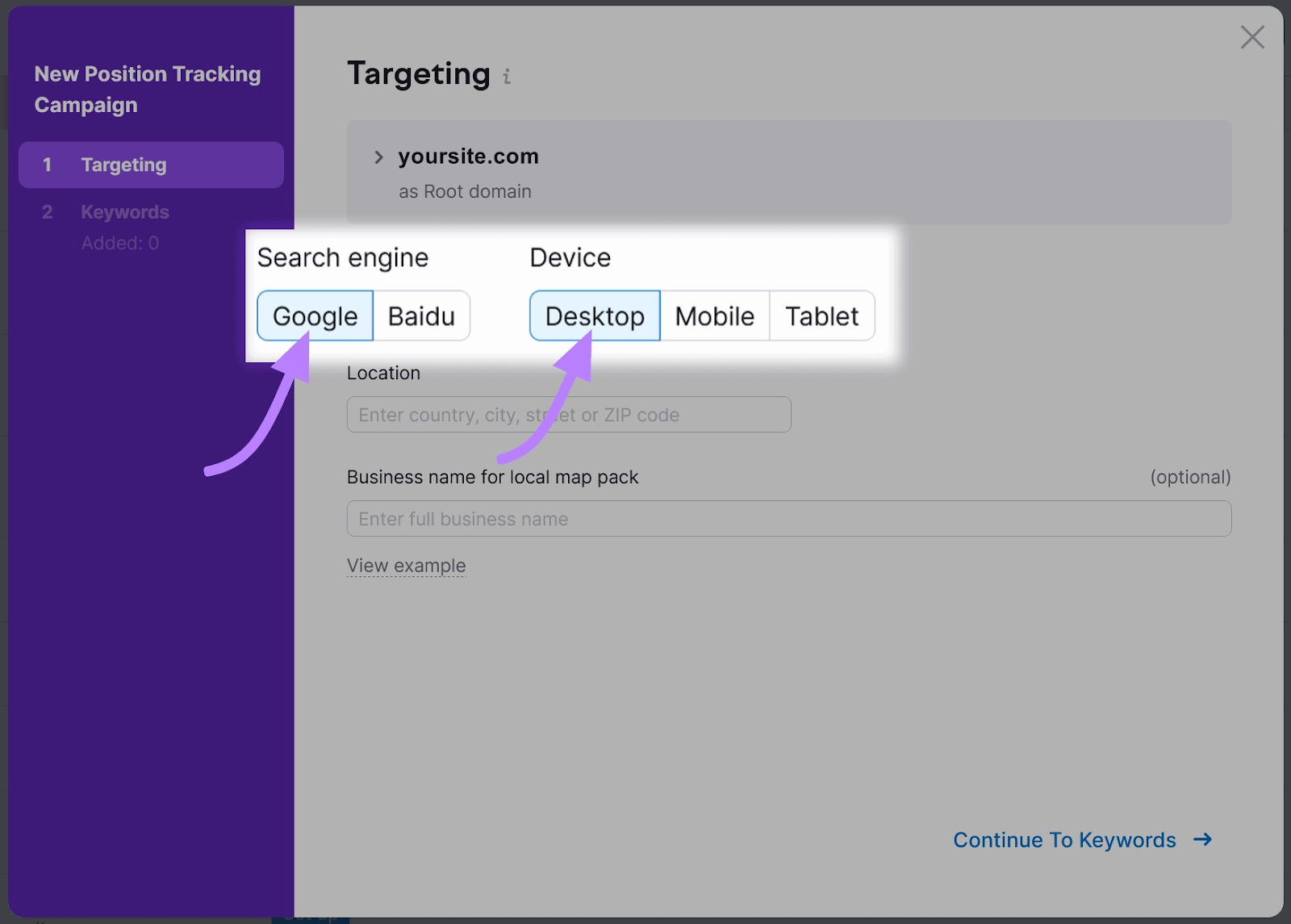
Then, enter the location and language of your target audience. If you own a local business, we highly recommend that you add your business name, as seen on Google’s map pack.
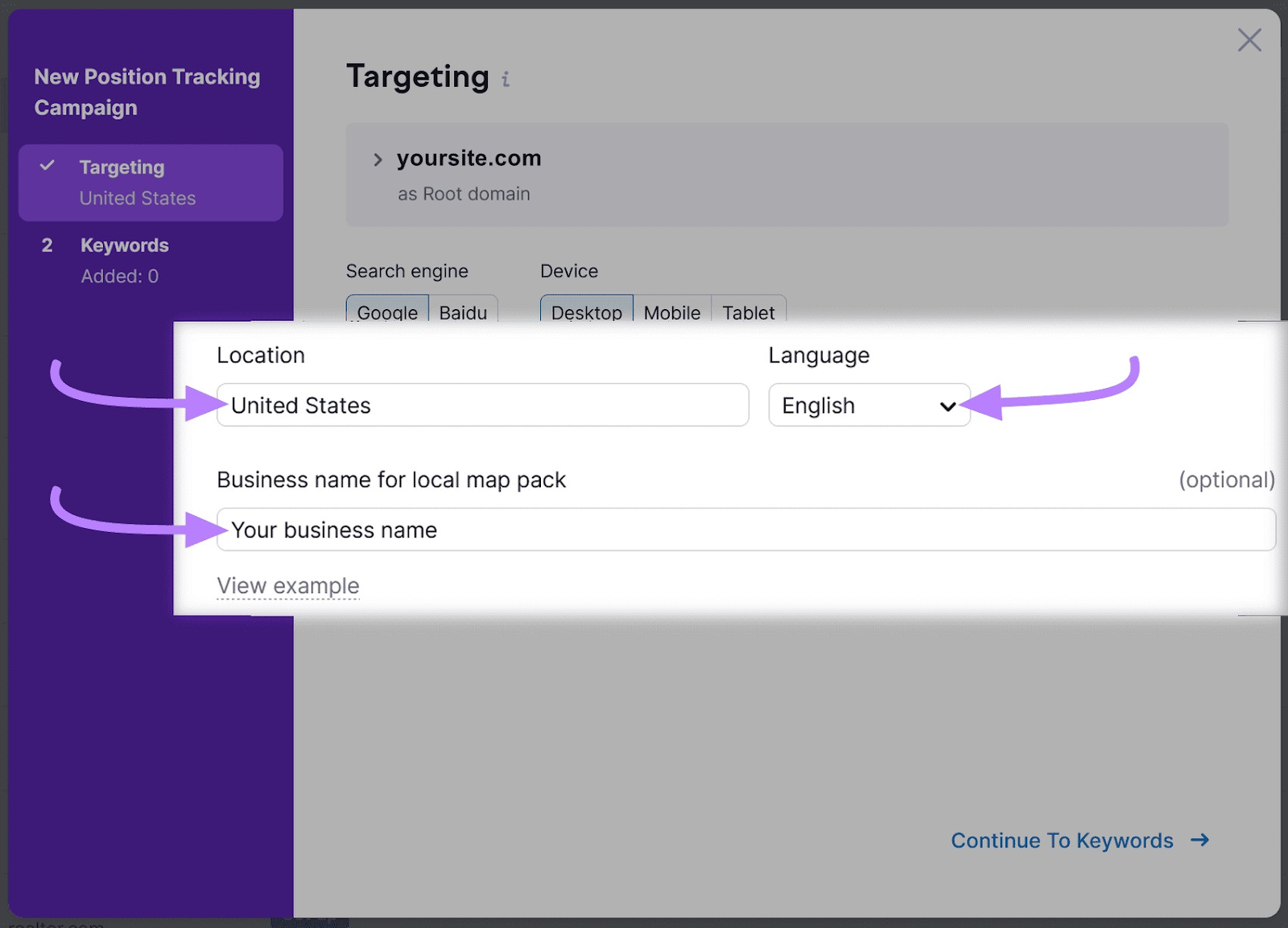
When you’re done, hit “Continue to Keywords.”
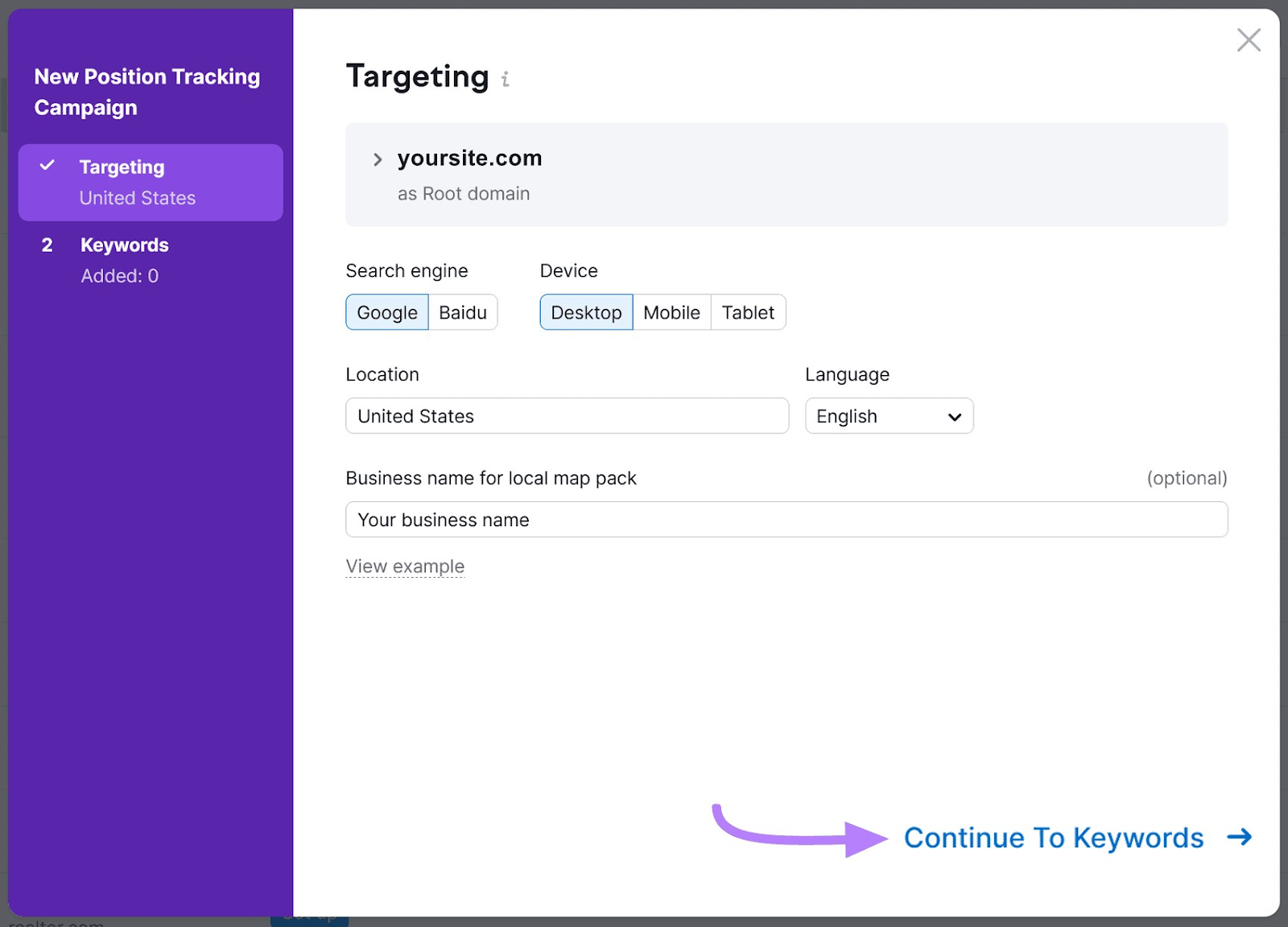
Now, it’s time to add your target keywords in. Either enter your keywords manually or click on the “Import from…” button to import keywords from a file, another campaign, or Google Analytics.
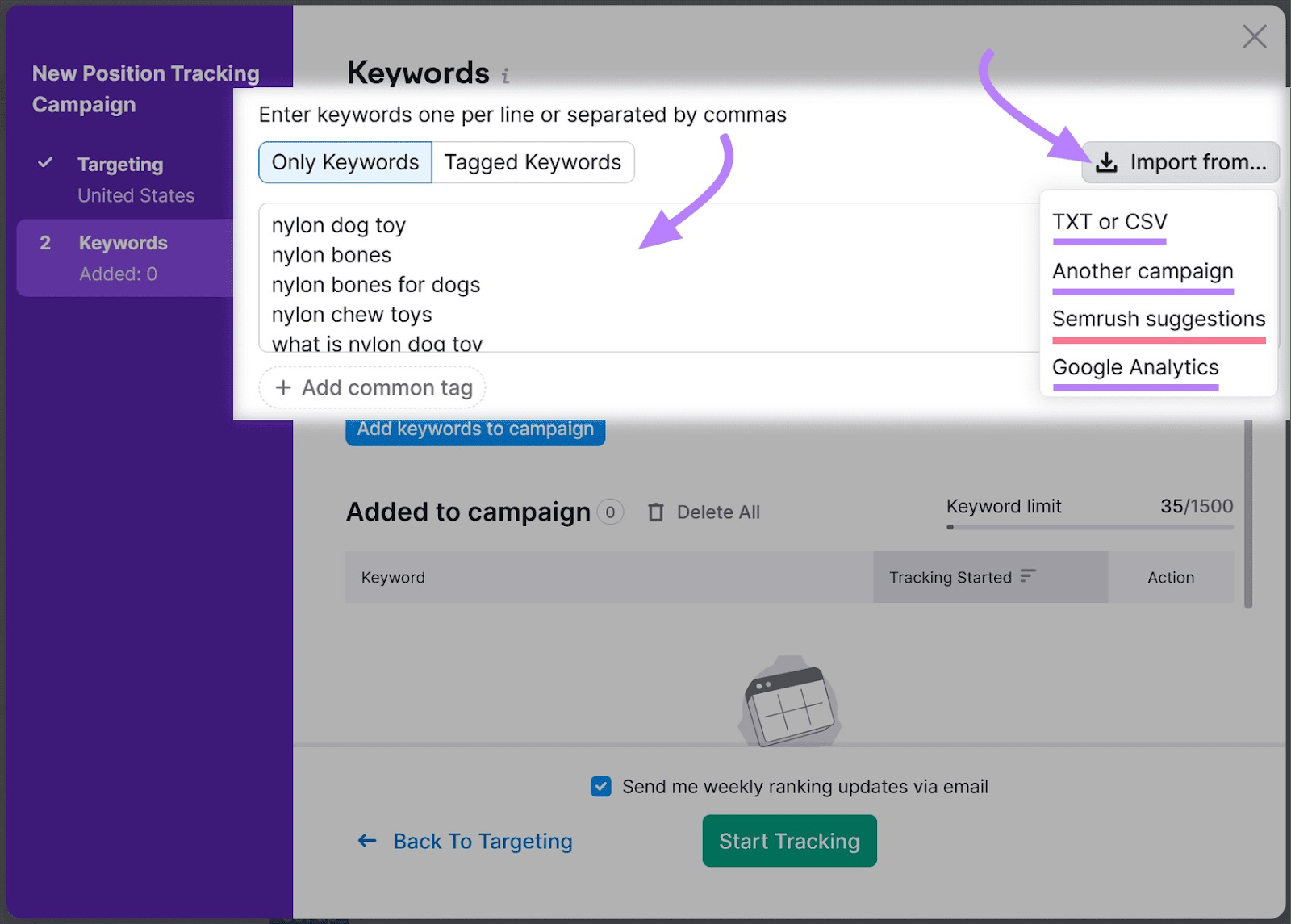
You can also choose “Semrush Suggestion” from the dropdown menu to auto-generate a list, in case you don’t have one yet.
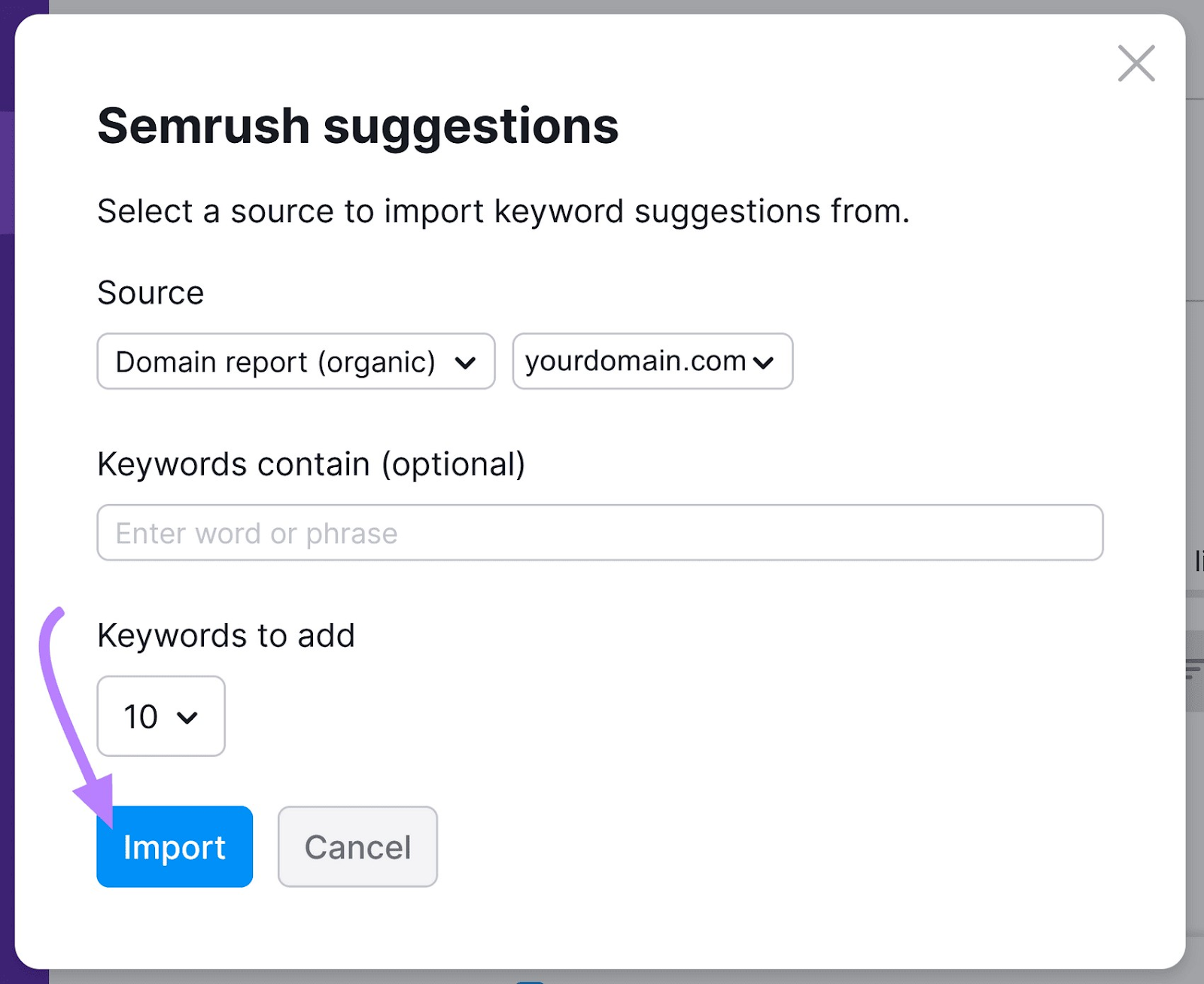
When you’ve added in your keywords, click on “Add keywords to campaign” and then “Start Tracking.”
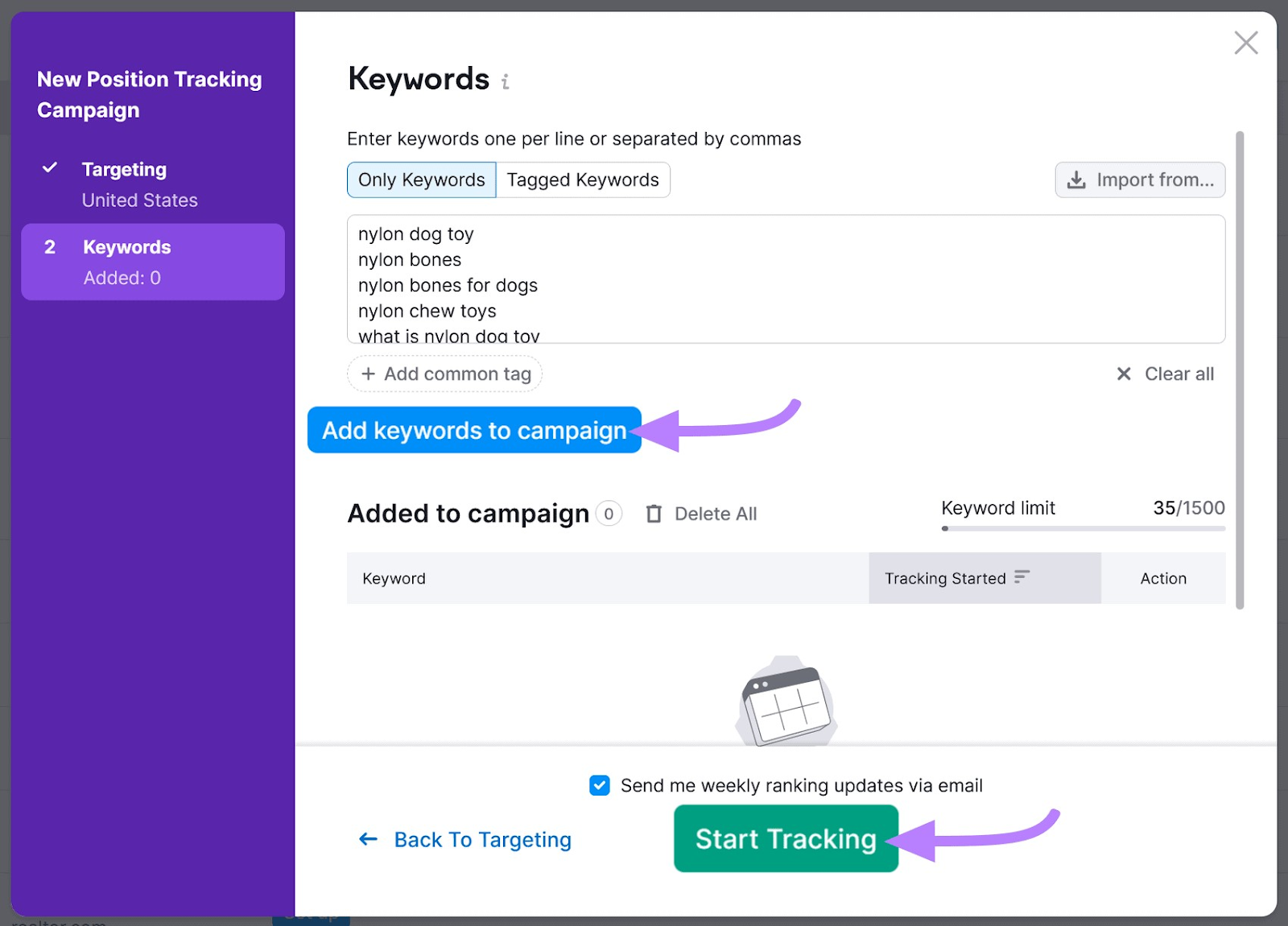
Pro tip: Make sure that you tick the checkbox beside “Send me weekly ranking updates via email.” That way, you can get emails about how you’re doing without having to go into the tool.
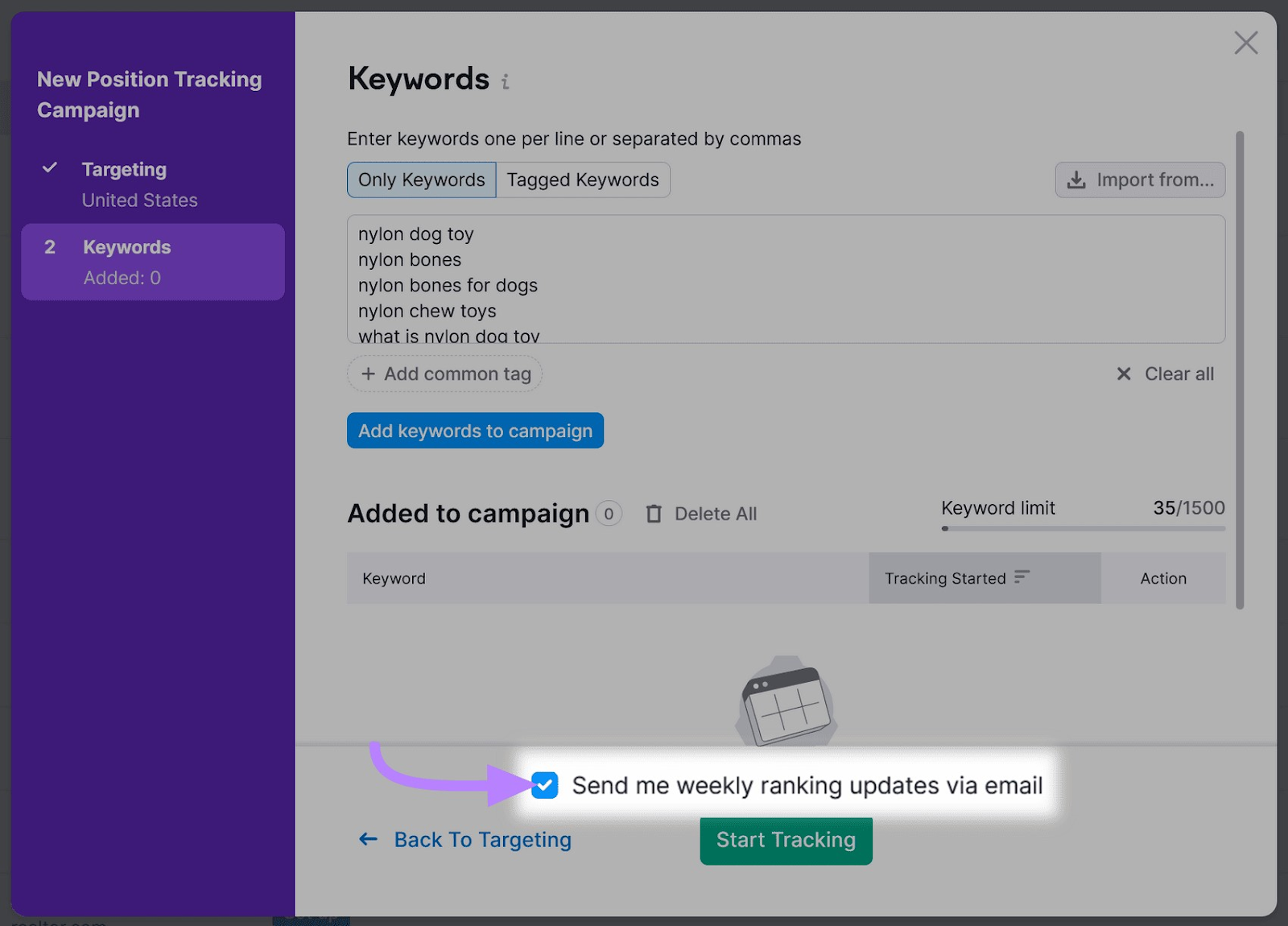
It will take the tool a couple of minutes to scan search results and create a report.
Then, you need to leave the tool to gather data to get a report that looks like this:
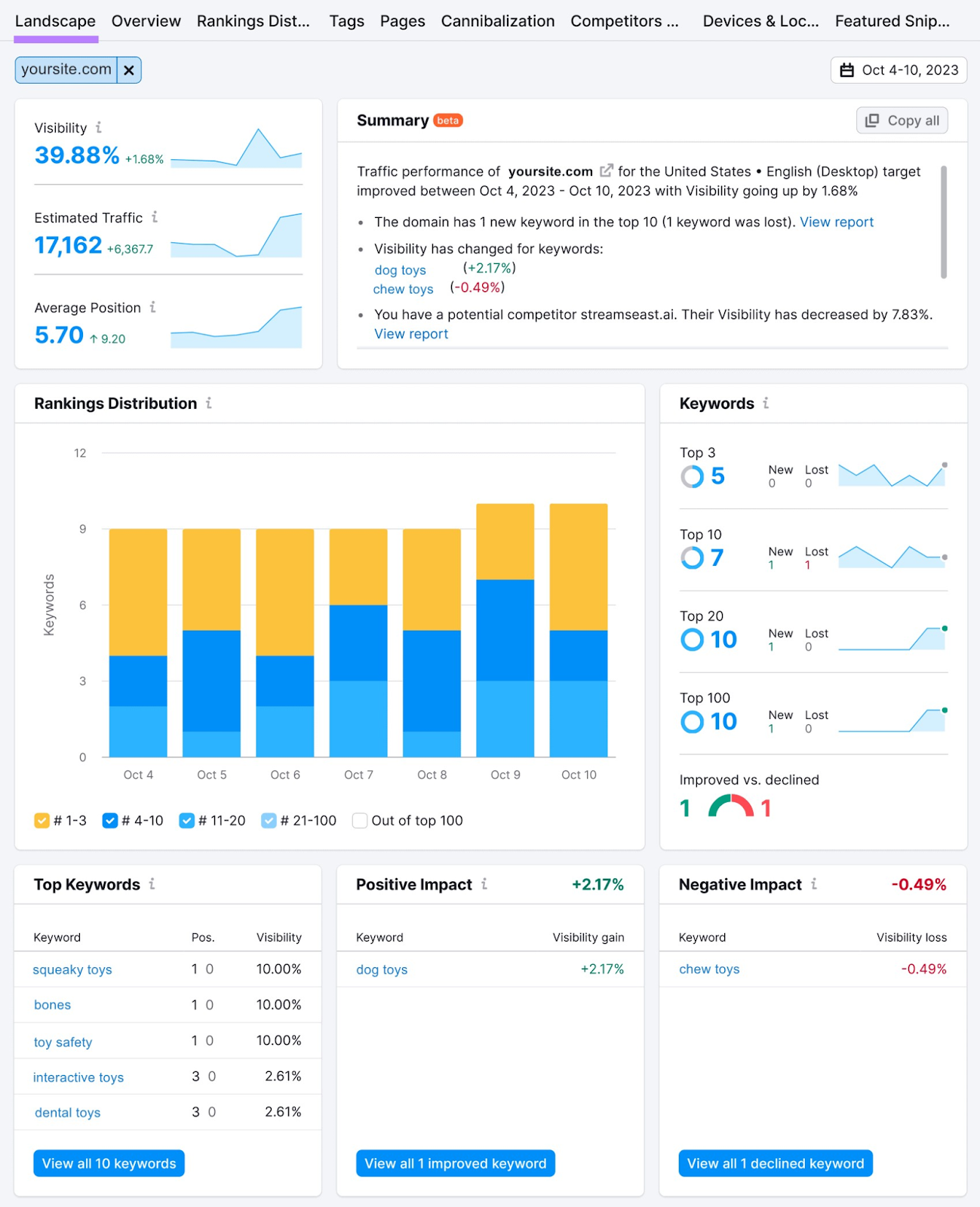
Use the information in the dashboard to find out which keywords are the most valuable to your brand. Which pieces of content need to be updated. And which ones your competitors are outranking you for.
Organic Traffic Insights
The Organic Traffic Insights combines Google Analytics, Google Search Console, and Semrush data to show you your top-performing pages. And which ones need some help.
It also tells you the overall state of your content—how much traffic you get, how engaged your visitors are, and how those metrics have changed over time.
To start tracking your organic traffic, go to the Organic Traffic Insights tool. And enter your domain and click “Get Insights.”

Then, connect your Google Analytics and Google Search Console accounts to the tool by clicking on “Connect Google Account” in the pop-up that appears.
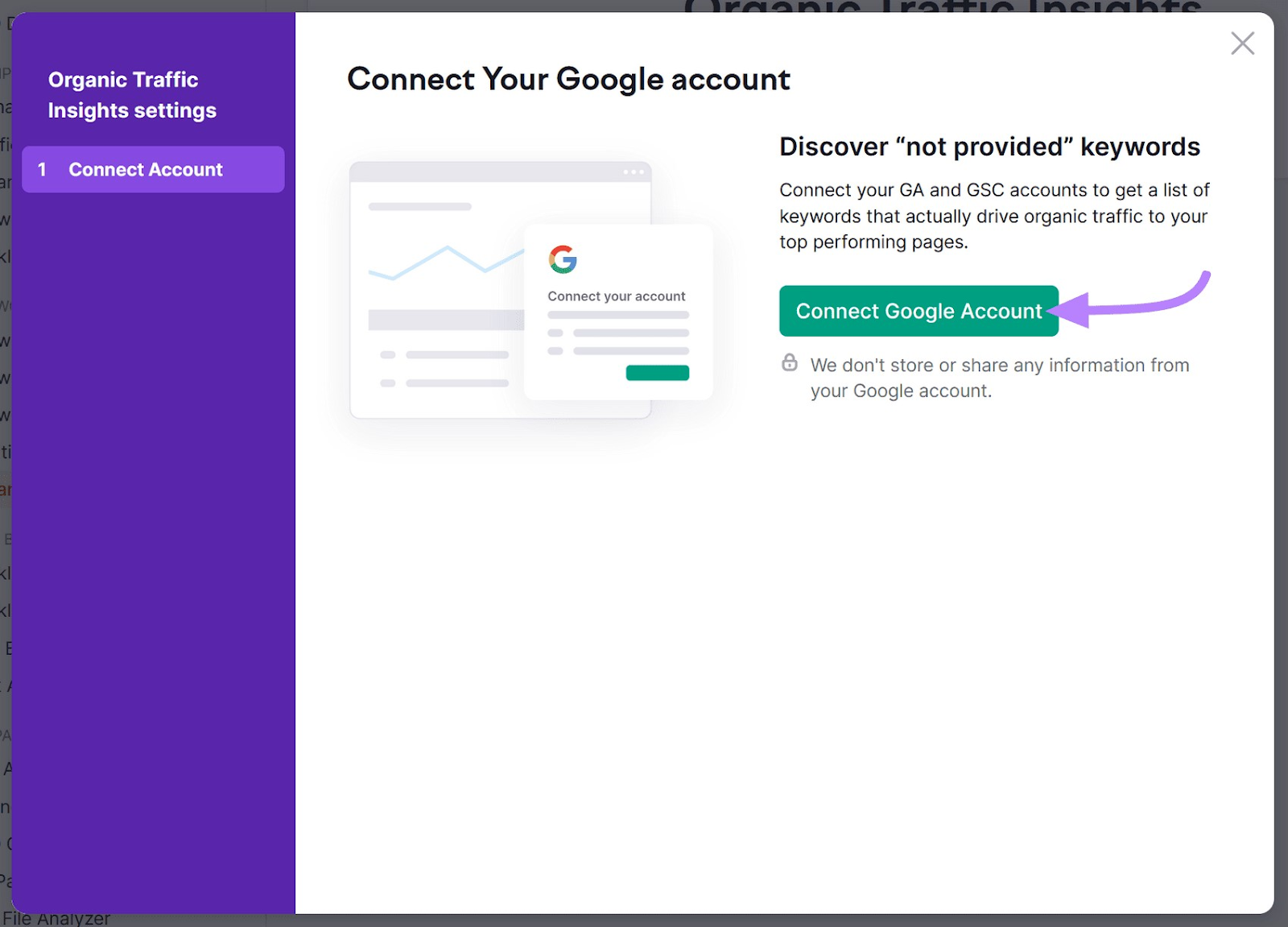
Sign in to the right Google Account. And then the correct accounts, properties, and data streams. Then click on “Locations and Device.”
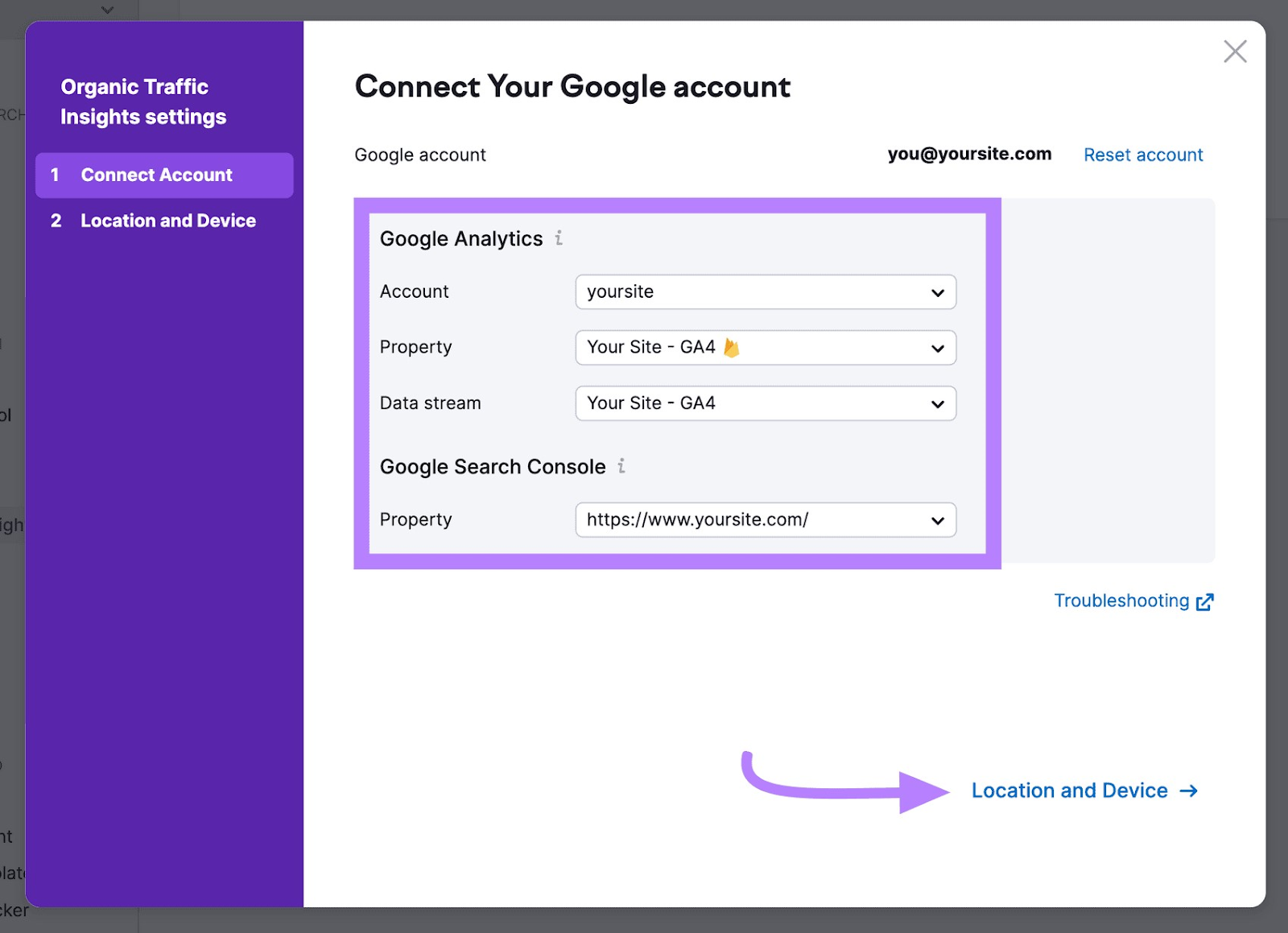
Lastly, choose your location. And the device that you want to track organic traffic for. And hit “Go to Organic Traffic Insights.”
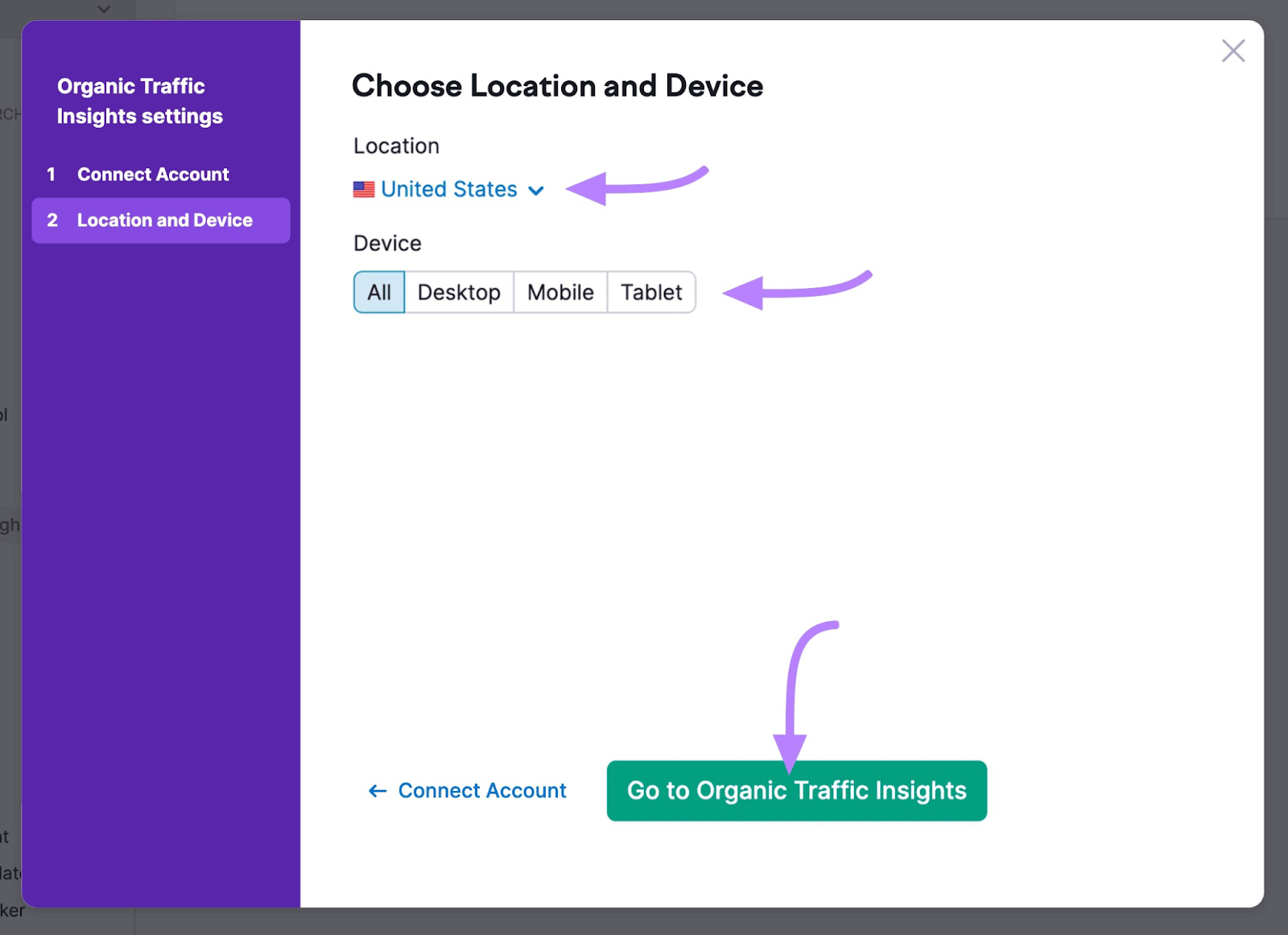
The tool will then show you the following data:
- How many users new users visited your site
- How many sessions were started
- How many engaged sessions your site had
- The average engagement time of each user
- Your average engagement rate
- How many conversions you have (if you set that up in Google Analytics)
- Your top-performing pages based on organic traffic
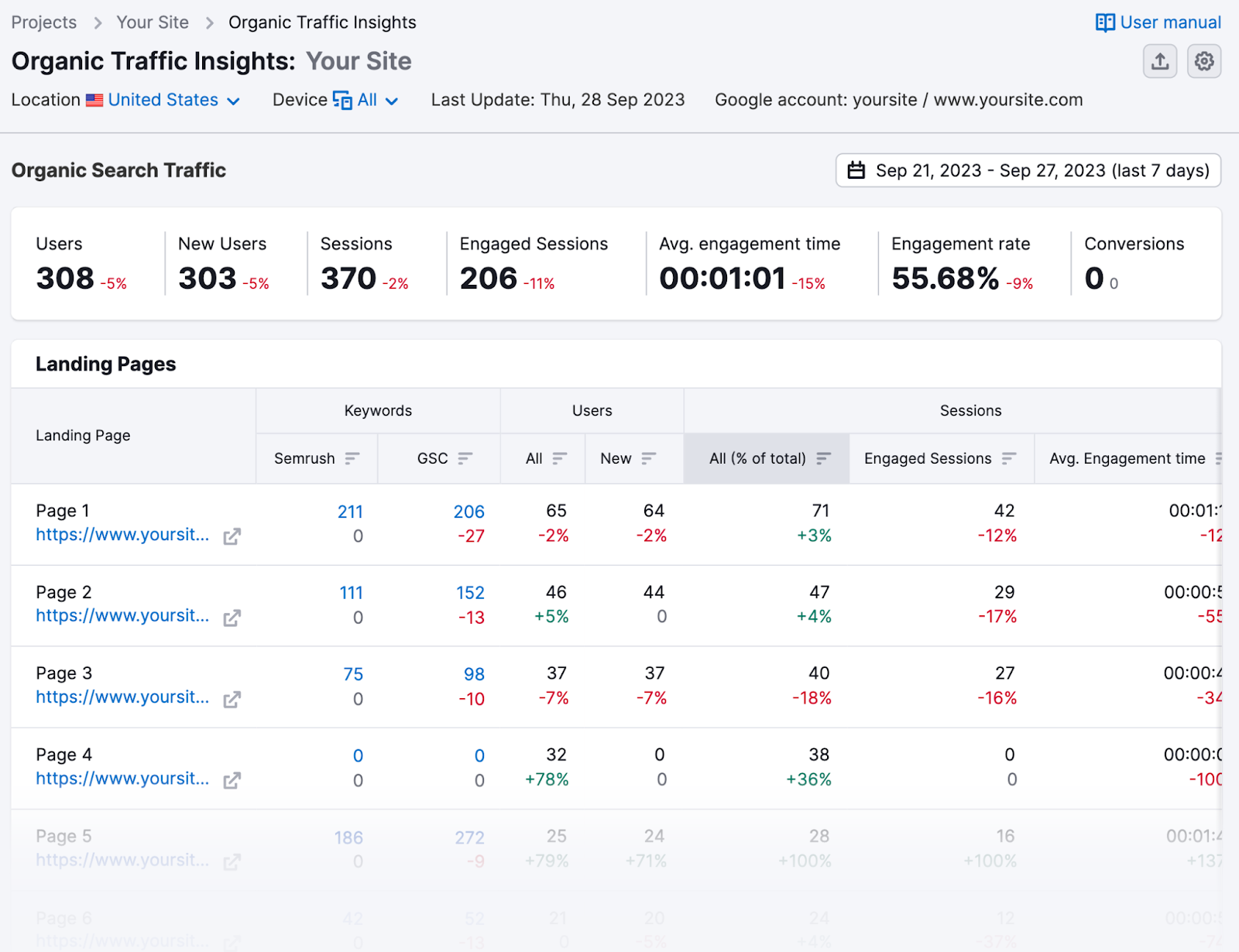
Clicking on a specific row page will bring you to a new dashboard. With information about that page specifically. Like what your top keywords are and where you are on the SERP for those keywords.
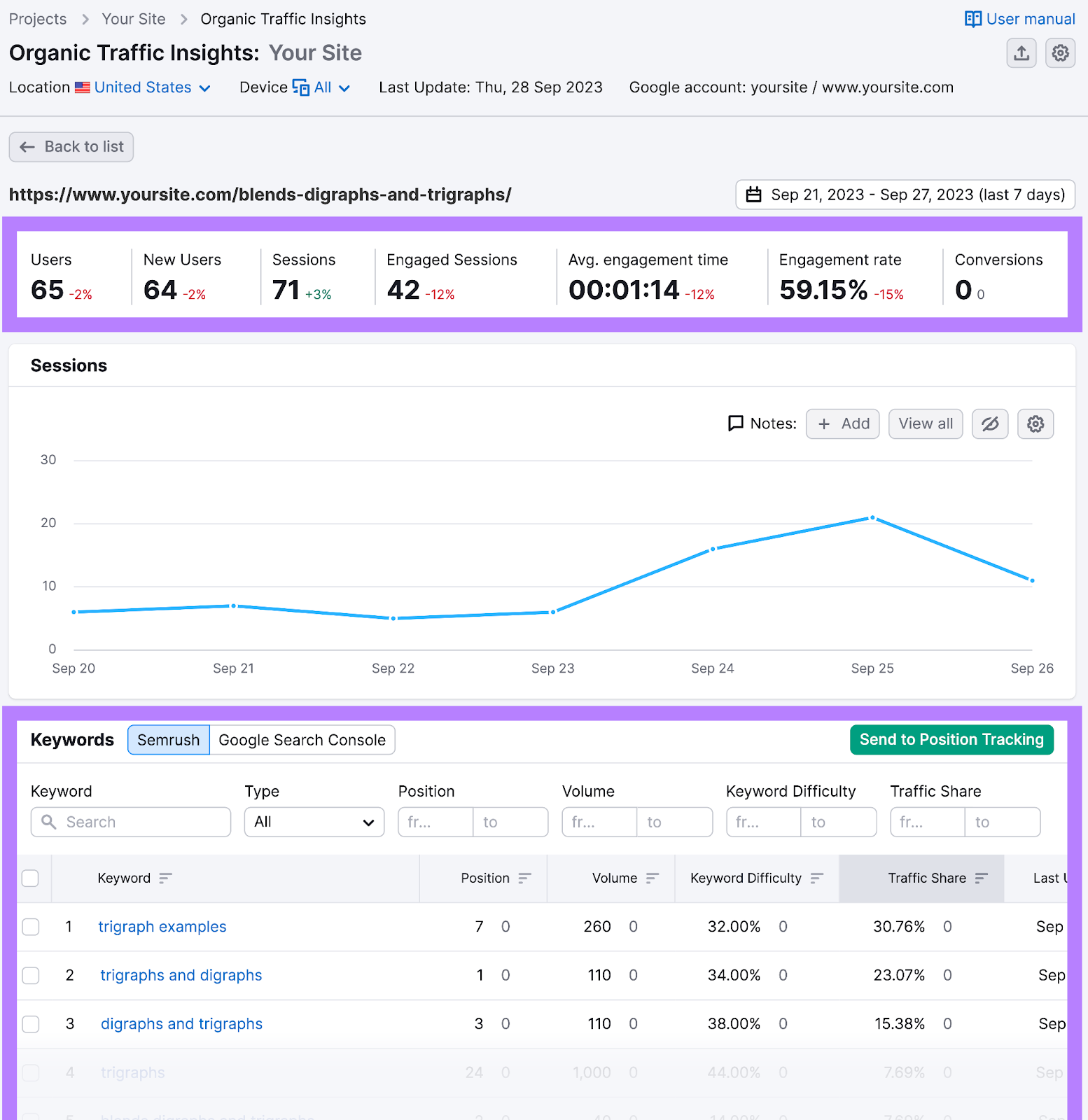
The tool will also show you the following:
- Which of your pages have performed well in the past but are no longer getting traffic
- Which of your pages are not performing well
We recommend that you update pages that have done well historically. They may have lost traffic because they are outdated.
And rewrite and re-optimize pages that have never performed well.
Site Audit
The Site Audit tool doesn’t just focus on content—it focuses on the overall performance of your website.
Get your report by going to the Site Audit tool, entering your domain, and clicking “Start Audit.”

Then, configure your settings, tick the checkbox beside “Send an email every time an audit is complete,” and click “Start Site Audit.”
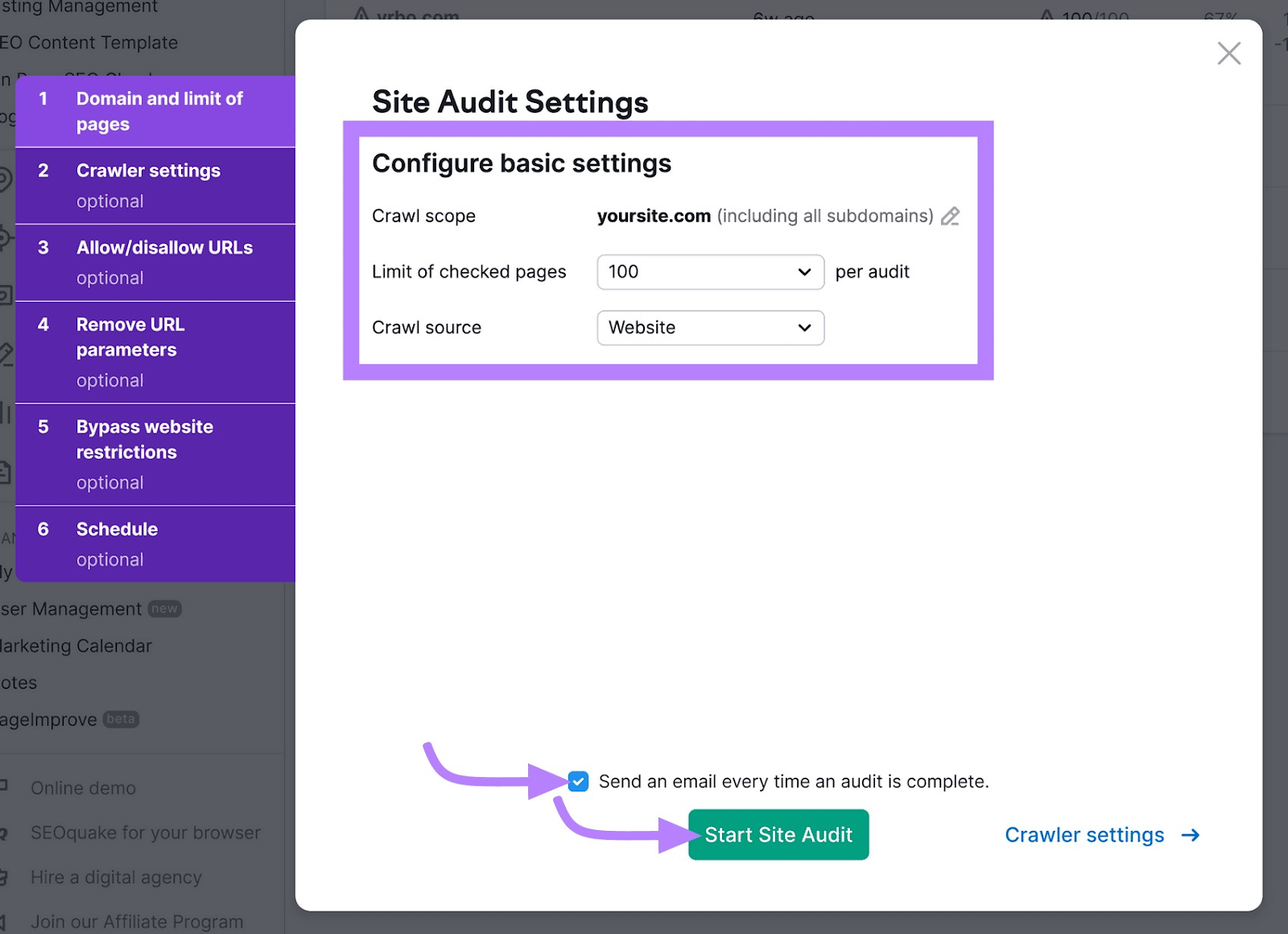
Now, you’ll get an email report every time the tool scans your website for errors.
The tool takes a little while to scan your website and gather data. But when it’s done, you get a dashboard with the following information:
- Site errors that you need to fix
- Your site health and how you compare to other sites in your industry
- The status of your robots.txt
- Your site’s top issues
- Thematic reports
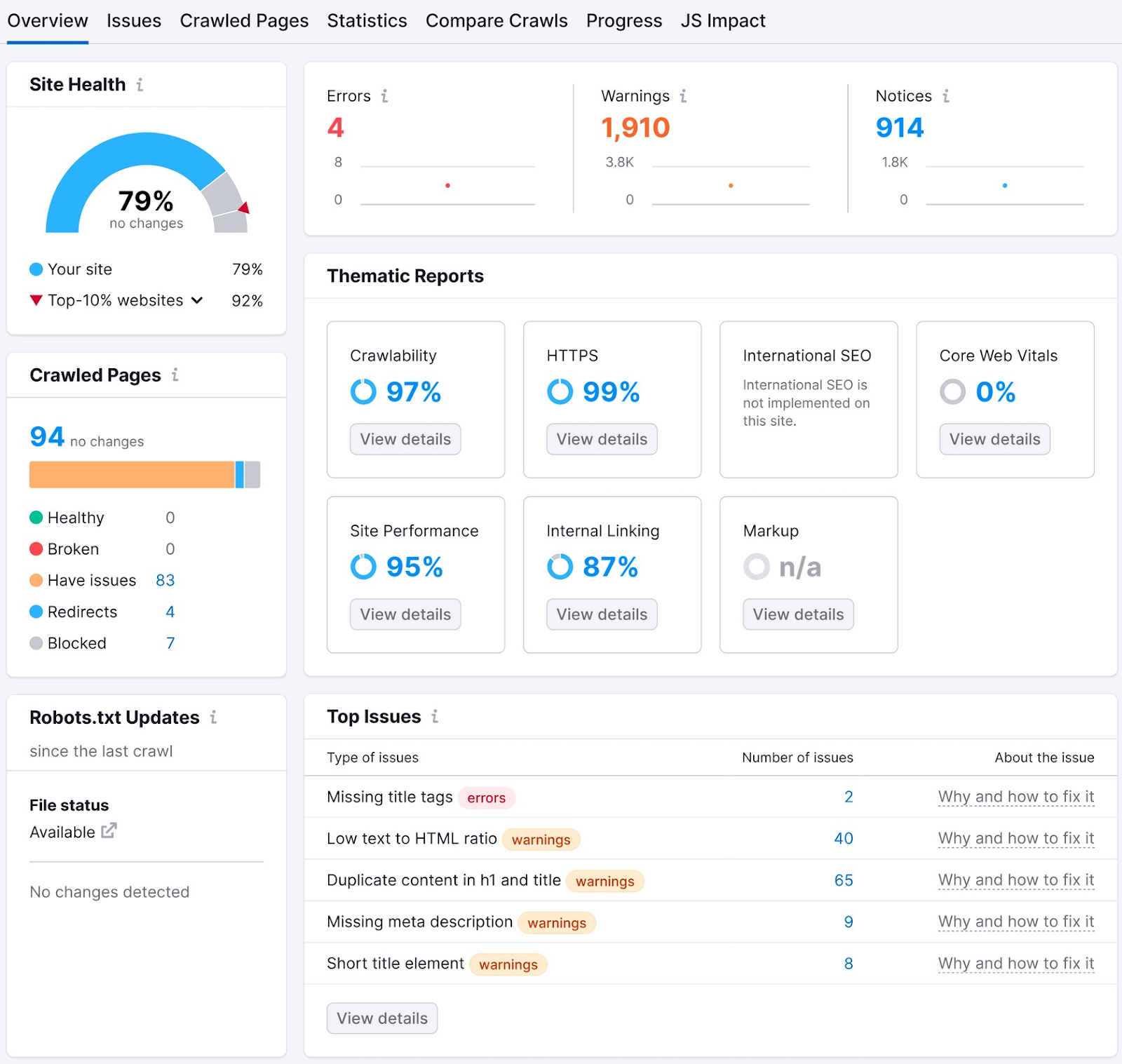
While the Site Audit tool checks more than just your content, you need a healthy website to rank on Google.
Which is why knowing how your website is doing is an important part of content automation.
We recommend auditing your site at least once a week. You can schedule site audits by clicking on the cog button in the top right corner of the report.
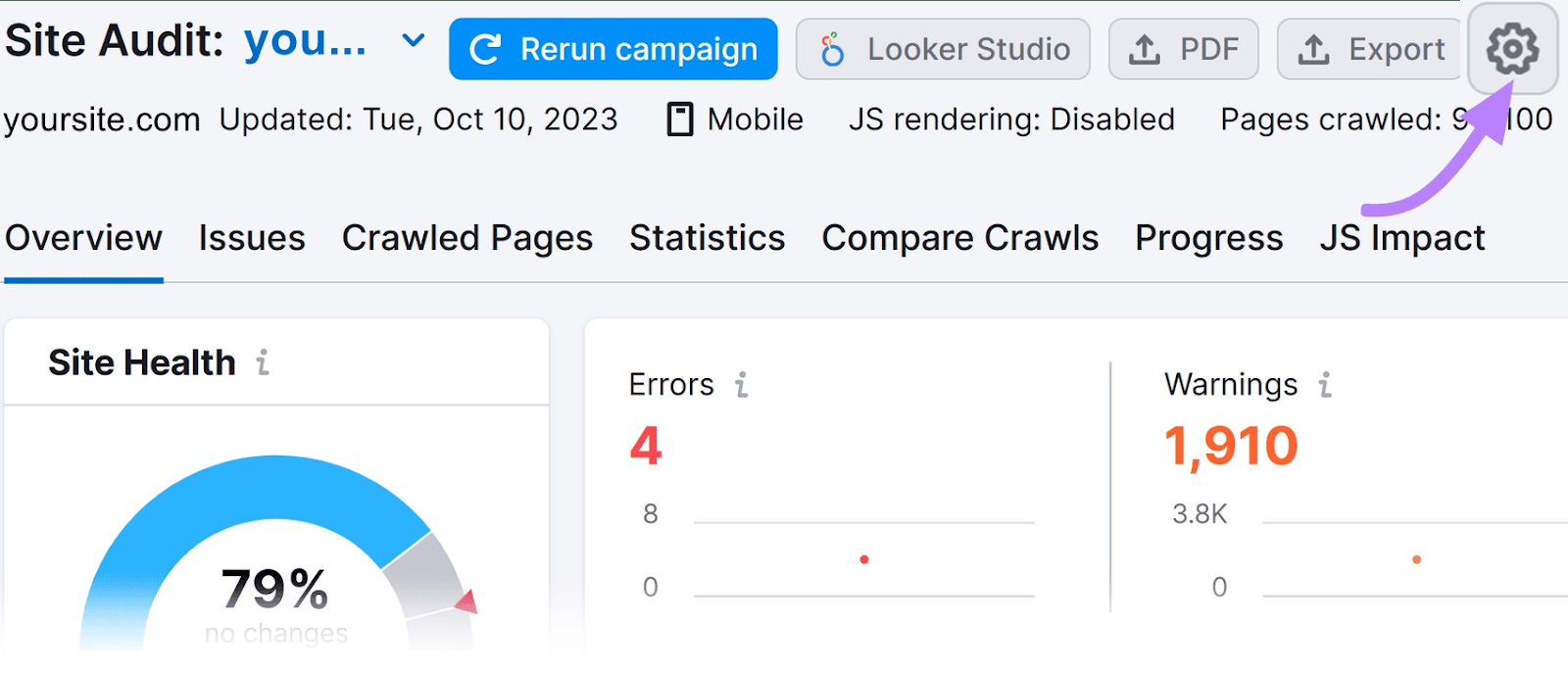
And scrolling down to click on “Schedule: Weekly, every Sunday.”
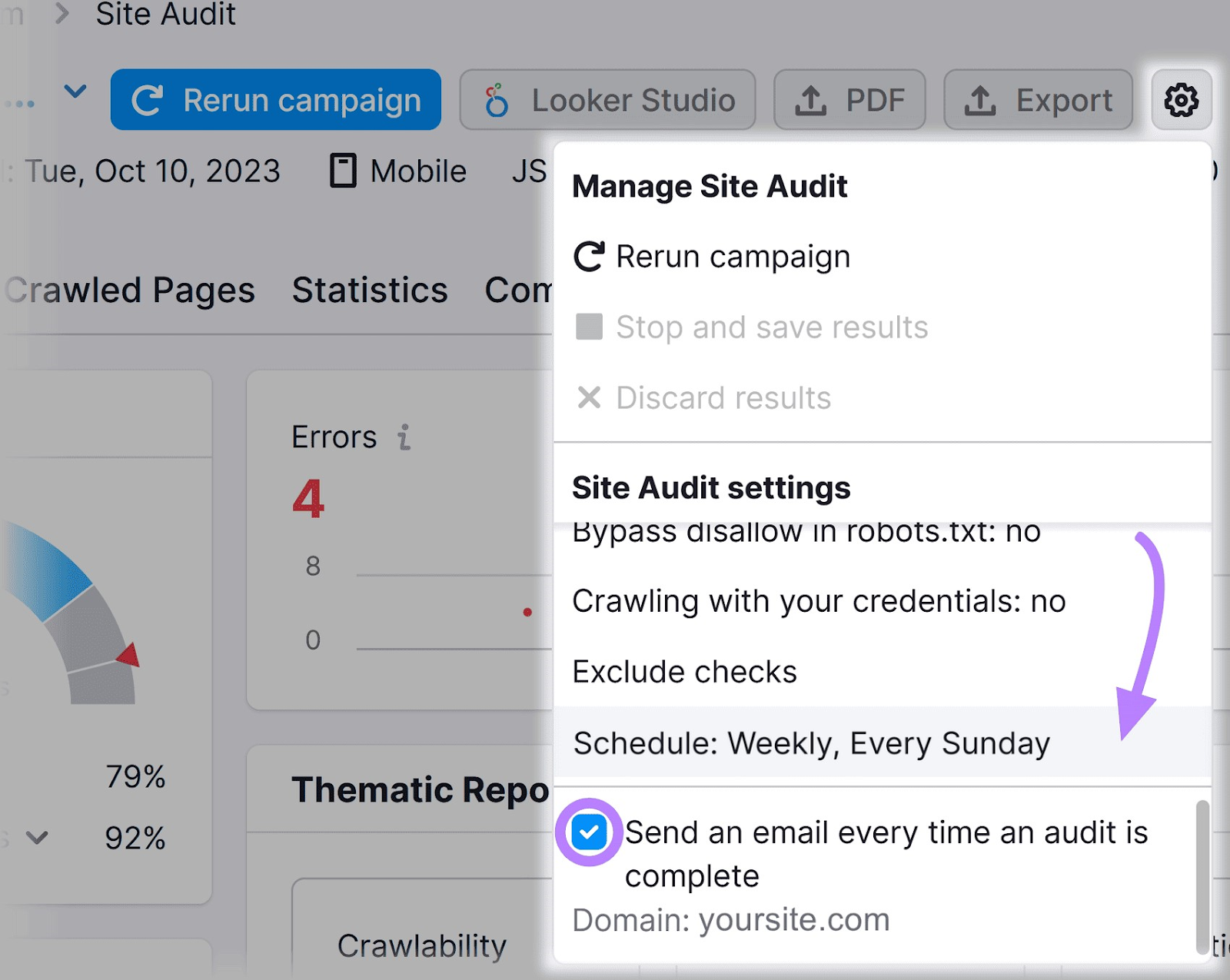
A pop-up will appear where you can choose which day you want to schedule the audits.
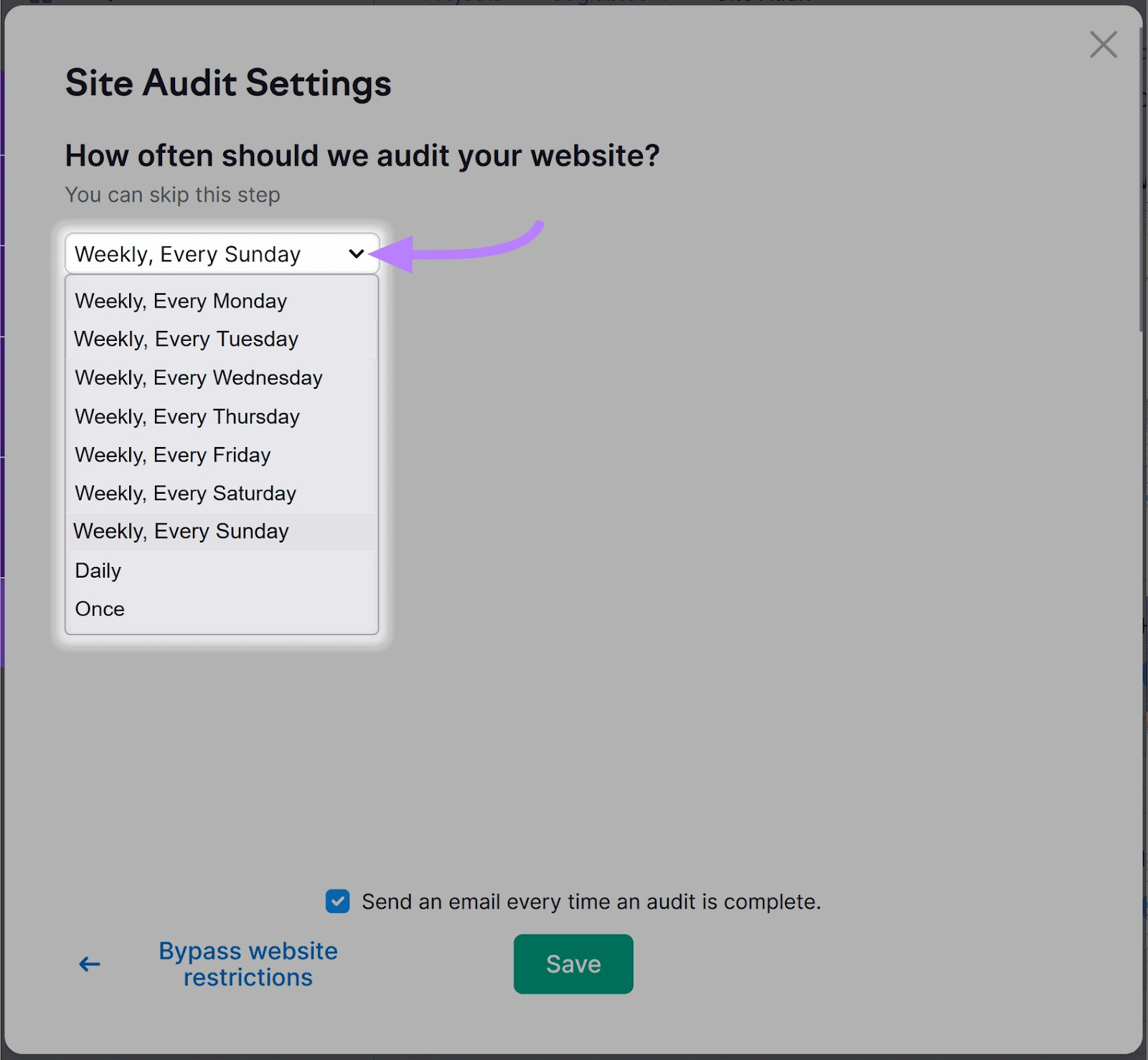
When you’ve chosen the day you want the tool to scan your site, click on the checkbox beside “Send an email every time an audit is complete.” And then click “Save.”
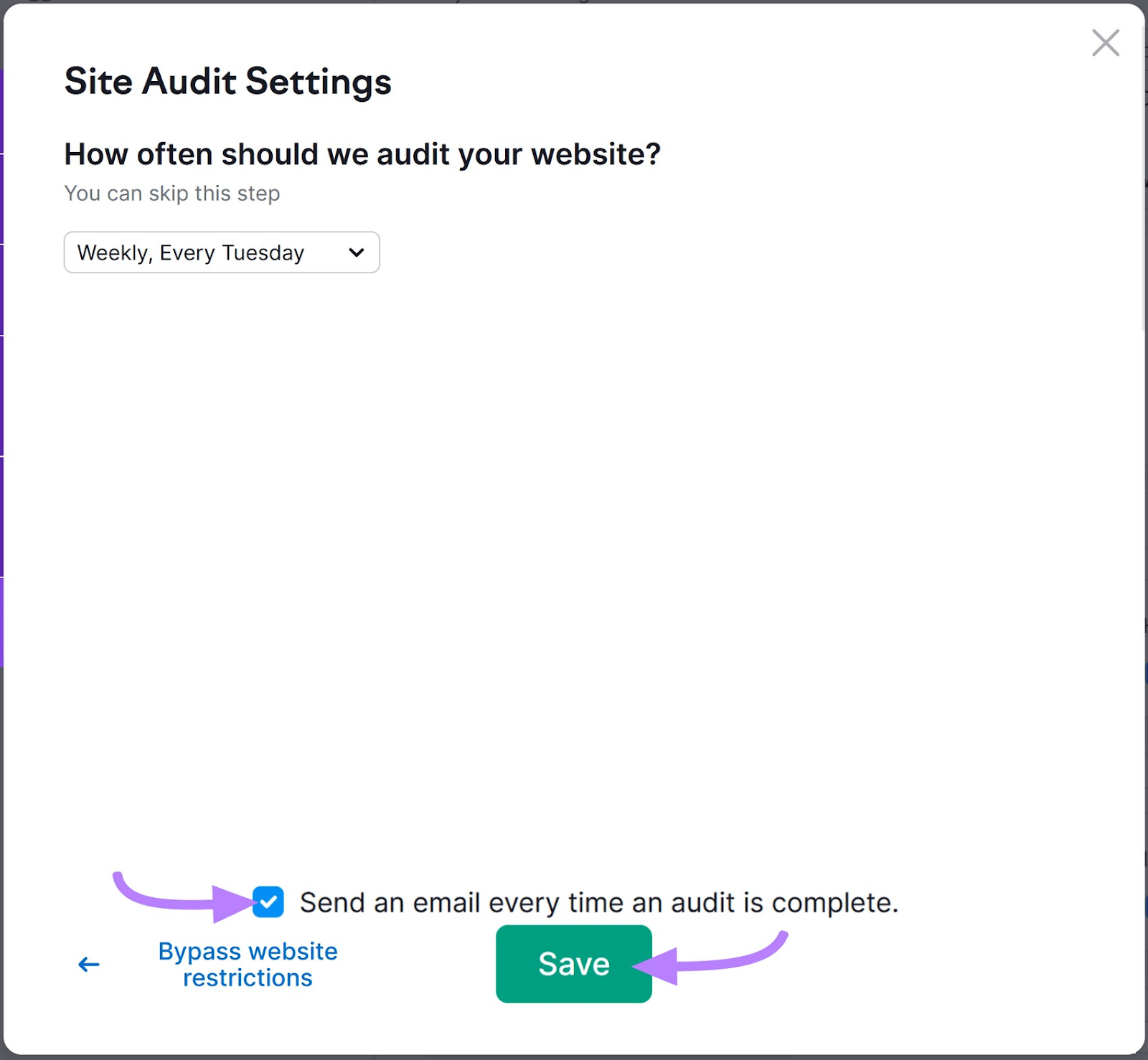
Now you’ll always know if your site is healthy.
Top 10 Content Automation Tools to Use in 2024
To help determine which tool(s) will benefit you the most, we’ve picked out a list of top options for each part of the content creation process.
1. Semrush: Best for Content Ideas, Optimization, and Analysis
Semrush is an all-in-one platform that will help you improve your online visibility and marketing performance.
The majority of the tools in Semrush help you automate tasks, from tracking rankings to auditing your site for technical issues. Here are some Semrush tools that will help you automate content creation and analysis:
Keyword Magic Tool & Keyword Overview
As discussed above, Semrush’s Keyword Overview tool automates keyword research by giving you keyword data for a specific keyword in a single dashboard.
In addition, the Keyword Magic Tool generates keyword lists that you can use to help your content climb the SERPs.
SEO Writing Assistant
Paste your text into the SEO Writing Assistant or use one of the integrations (Google Docs, Microsoft Word Add-On, or WordPress plugin) to get instant recommendations to improve and optimize your content in real-time.
The tool scans your content and identifies the following:
- Which keywords to include
- How to optimize images and links
- Which words, sentences, and paragraphs to change to improve readability
- Whether the tone of voice is consistent and relevant to your audience
- Whether your content is original and which parts contain plagiarism
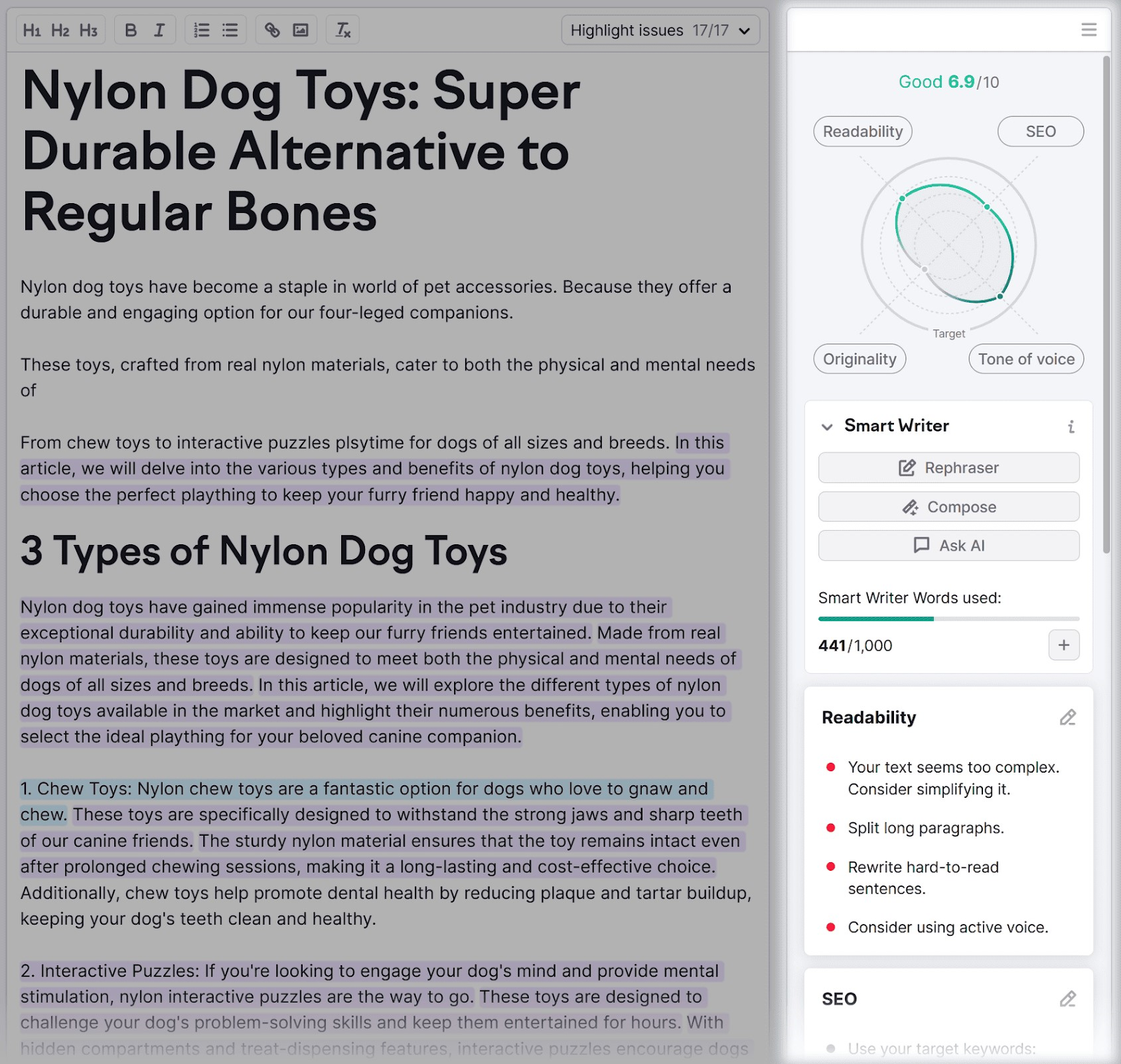
The SEO Writing Assistant makes recommendations based on top-performing content in Google search results.
Running a draft through the tool speeds up the editing process and helps you publish competitive content.
Position Tracking & Organic Traffic Insights
The Position Tracking and Organic Traffic Insights tools tell you how your content is doing. And where you can improve.
More specifically, the Position Tracking tool tells you which of your target keywords you’re ranking for.
And sends you reports every week so that you always know how you’re content is performing in search results.
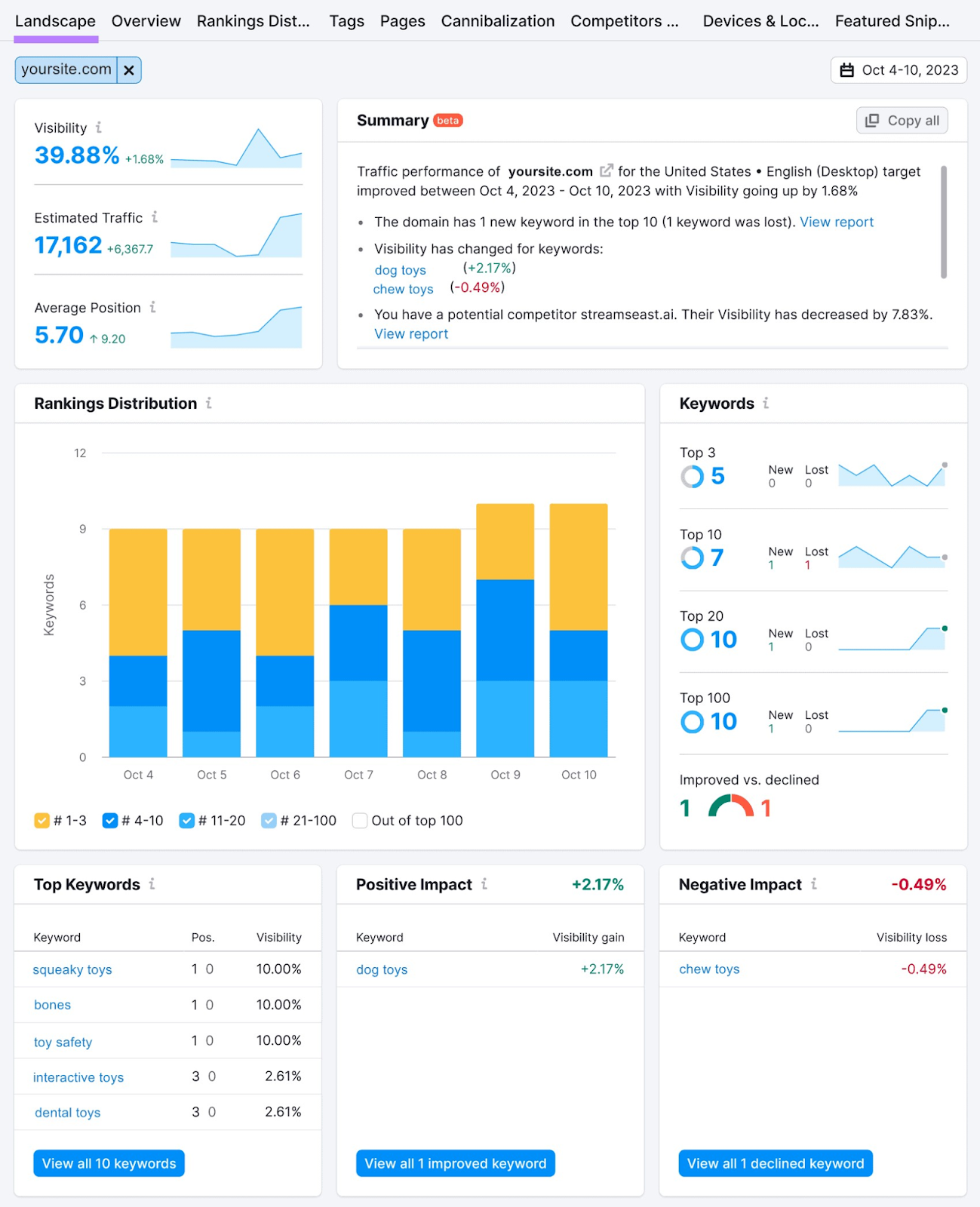
The Organic Traffic Insights tool, on the other hand, tells you which of your pages are performing well in terms of organic traffic.

That way, you always know which keywords and landing pages are contributing the most to your business growth.
Scroll up to learn how to use them.
Site Audit
Site Audit finds errors or warnings that are impeding website performance and shows. You can fix issues with crawlability, SEO, Core Web Vitals, and more.
Pricing
Basic Topic Research and SEO Writing Assistant features are free to all paid Semrush users.
Full access to the Content Marketing Toolkit, which includes additional features and tools to audit your site, is available starting from the Guru subscription.
You can take these features for a spin with a seven-day free trial.
2. ImpactHero: Best for Content Analysis
ImpactHero is great for auditing content and identifying which pieces of content need updating.
Once you add tracking code to your site’s pages using Google Tag Manager, ImpactHero can recommend ways to improve your content strategy at every stage.
First, analyze customers’ traffic sources to find your top-performing channels, along with the highest-performing content types and lengths:
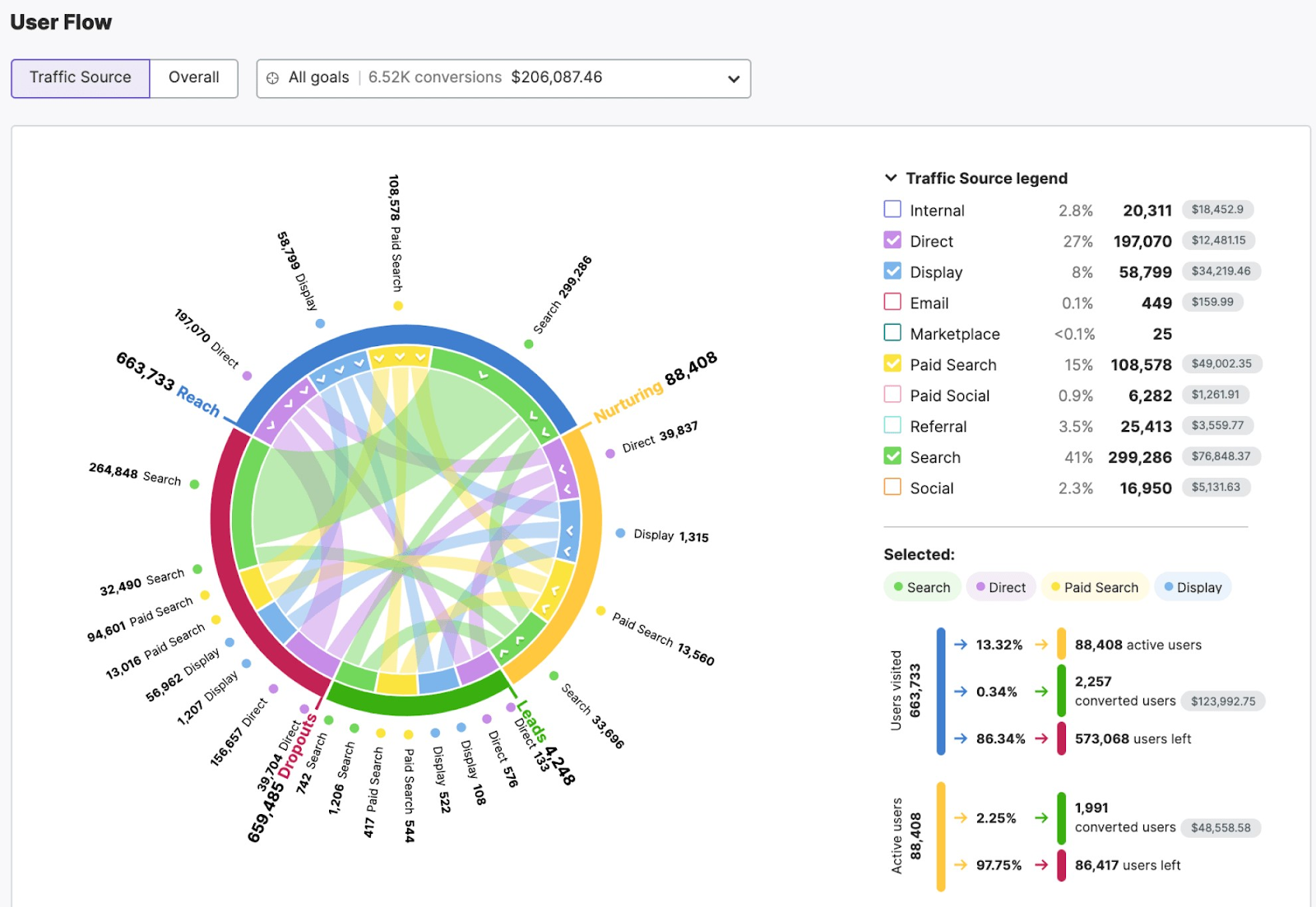
You can also use the Analytics Report to see which content performed best in terms of traffic, bounce rate, conversion rate, engagement, and lead generation.
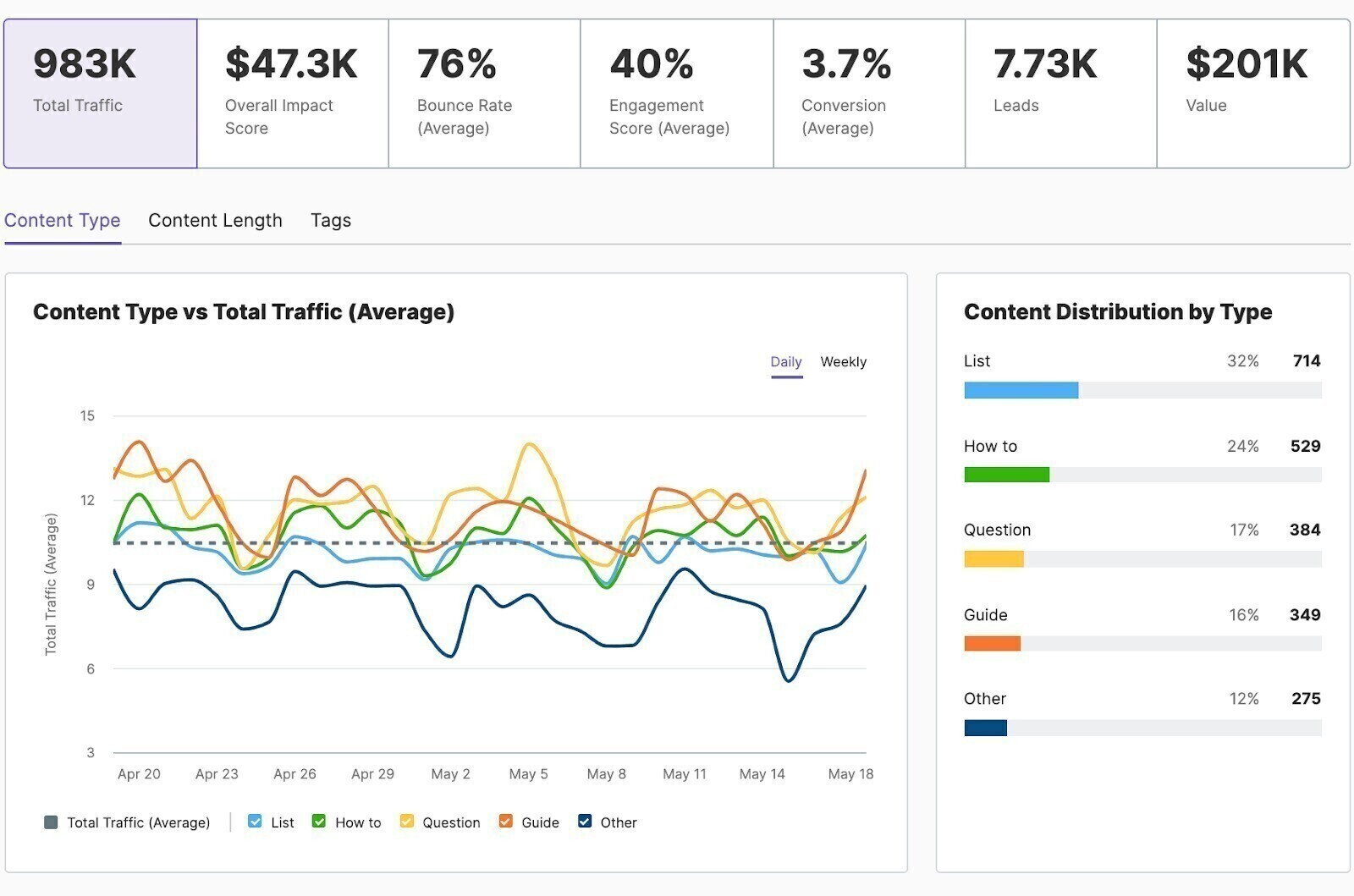
This tool, designed specifically for content marketing teams, can help you tailor content to the customer journey and improve weaknesses.
Pricing
Semrush users get a 21-day free trial of ImpactHero. They can then add it to a paid Semrush subscription for $200 per month.
3. Buzzsumo: Best for Social Media Content Ideas
BuzzSumo automates content research and ideation for social media by gathering the most popular topics for your keywords or industry.
Its most useful brainstorming feature is the Content Ideas Generator. Enter your keywords into the tool to get ideas from an archive of eight billion pieces of content.
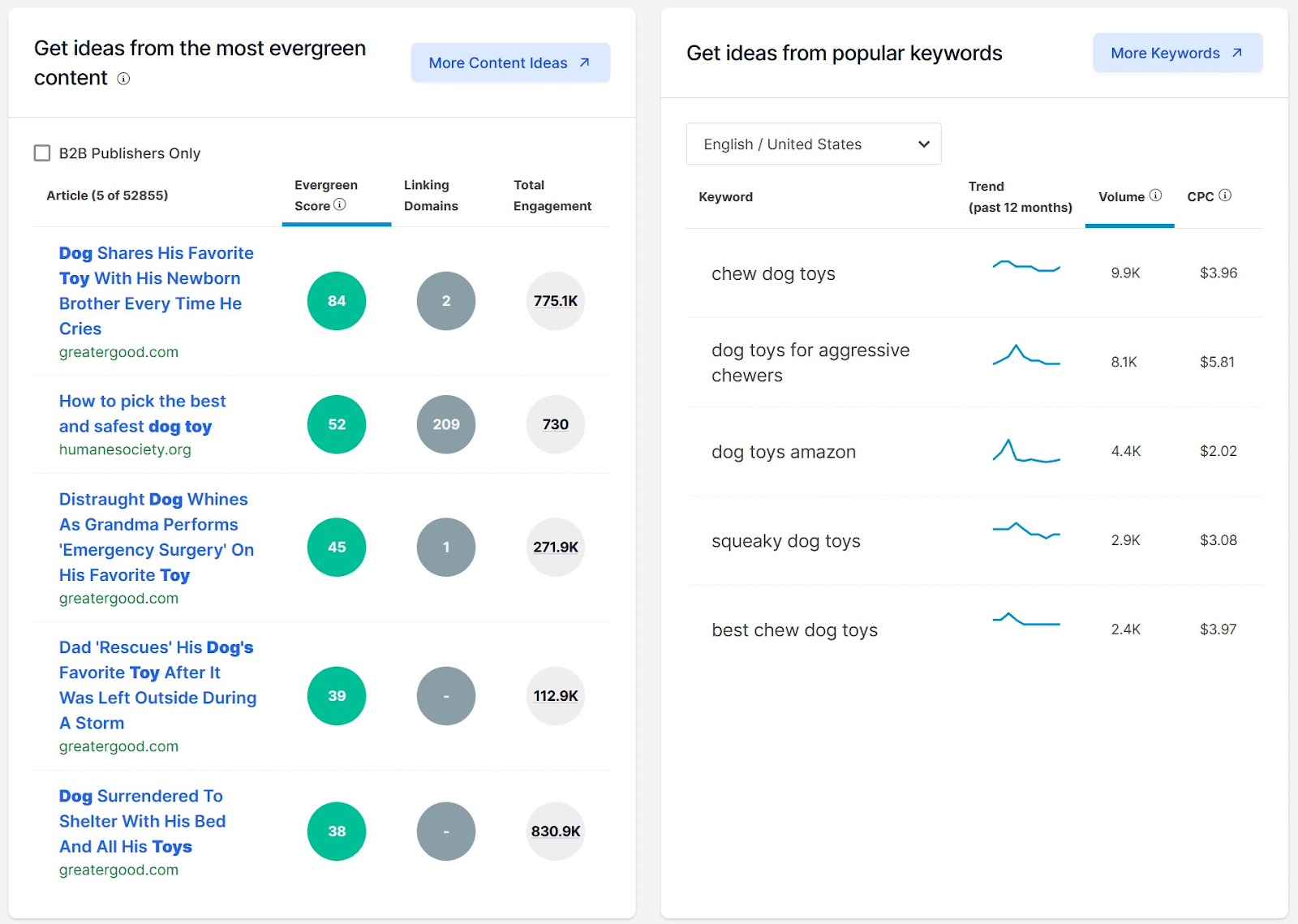
BuzzSumo shows you:
- Trending topics
- Top shared and linked content
- Popular keywords
- Audience questions
- Popular related topics
- Top-ranking content, including section headings
You can tailor a search to analyze data from 15 minutes ago to as far back as five years ago.
BuzzSumo also lets you create content briefs based on your search with a single click, so teams can quickly move from ideation to execution.
Beyond generating ideas, BuzzSumo also has features to automate performance measurement. Its monitoring tools let you track mentions and trends, create alerts for keywords, and follow content from key publications.
It also lets you access a huge database of influencers and journalists to streamline your public relations efforts and find the best people to promote your brand.
Pricing
BuzzSumo’s Content Idea Generator and Monitoring tools are available for solo users for $95 per month.
Plans for marketing teams start at $199 per month for five users. All users can take advantage of a 30-day free trial.
4. ChatGPT: Best for Inspiration
ChatGPT is an advanced AI chatbot that can chat with you in a conversational tone.
Which means you can give ChatGPT a prompt, and it will answer.
The best way to use ChatGPT is to get inspiration for content ideas. Or when you’re stuck with writer’s block.
For example, here’s how it responded to the prompt, “I need 10 great ideas for diy wedding decorations”:

And here’s how the tool answered the prompt, “My introduction for my article on cats is a little dry. Can you rephrase it for me to make it more fun, lively, and appealing to a younger audience? [insert introduction below]”:

While ChatGPT can do other things, it’s best to use it as an assistant or for inspiration. Since its responses aren’t always accurate.
Pricing
ChatGPT is free for all users. To access the tool when demand is high, get faster responses, and receive priority access to new features, ChatGPT Plus is available for $20 per month.
5. ContentShake AI: Best for Content Generation
ContentShake AI is a smart AI Writer that combines ChatGPT's capabilities with Semrush's powerful SEO data. You can automate the entire content production process:
- Find topics
- Write ready-to-rank content
- Optimize for engagement and SEO
- Publish in one click
Let’s continue with the above “pet toys” example. Here are the ideas ContentShake AI generated for “pet toys wholesale”:
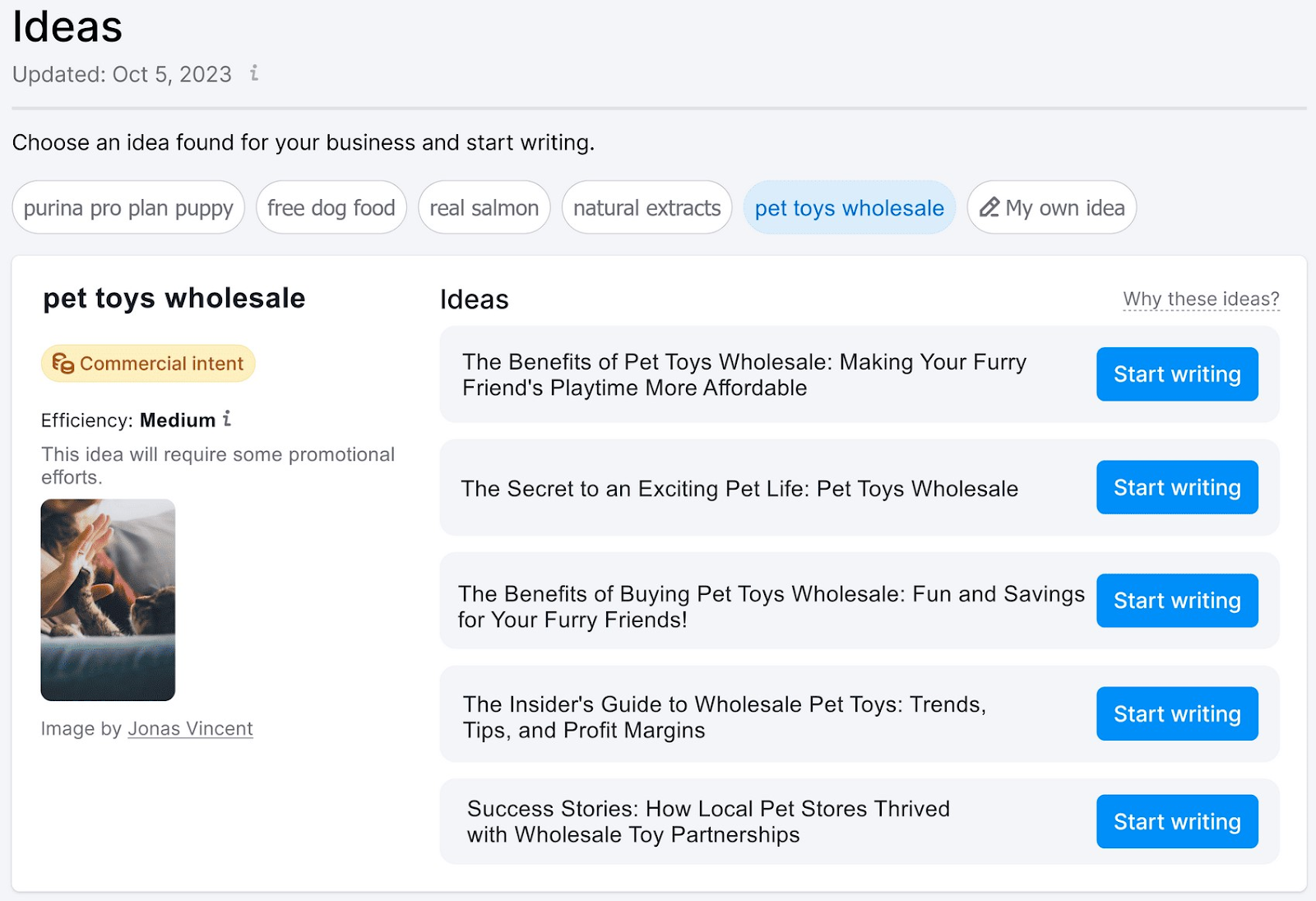
ContentShake AI then generates the article text:

It also generates article titles that you can compare with competitors:
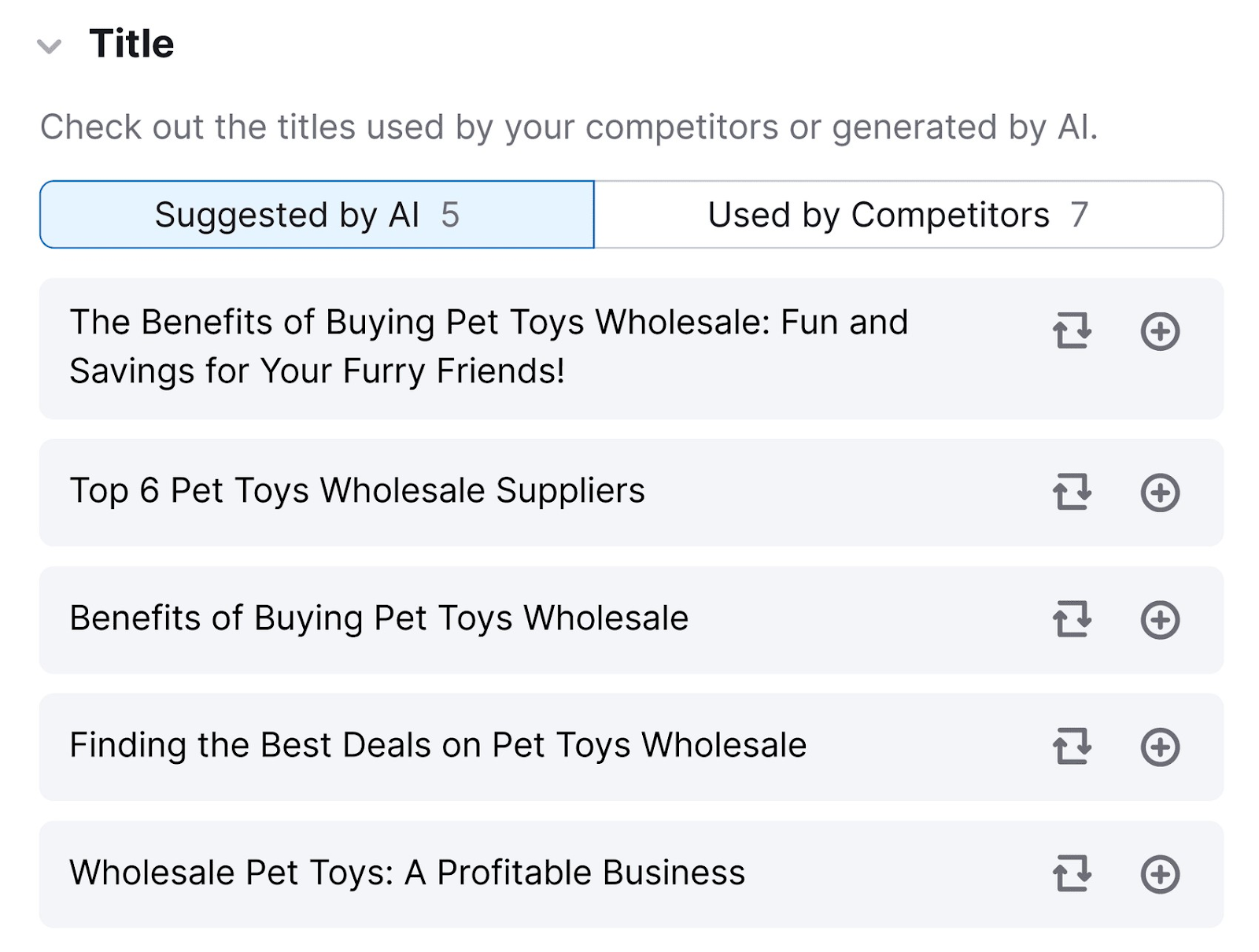
Along with introductions for the content:
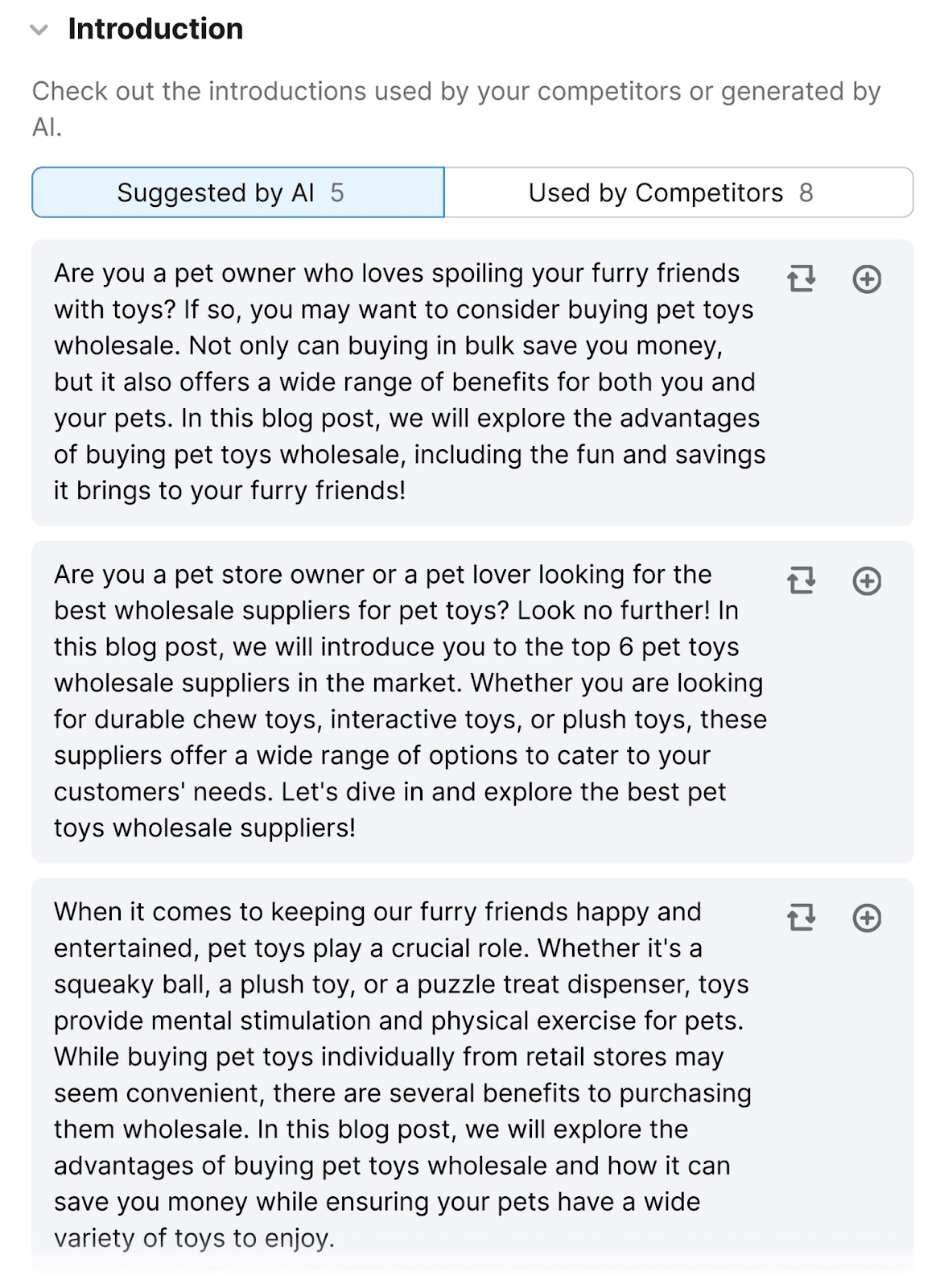
And finally a suggested structure of H2s and H3s:
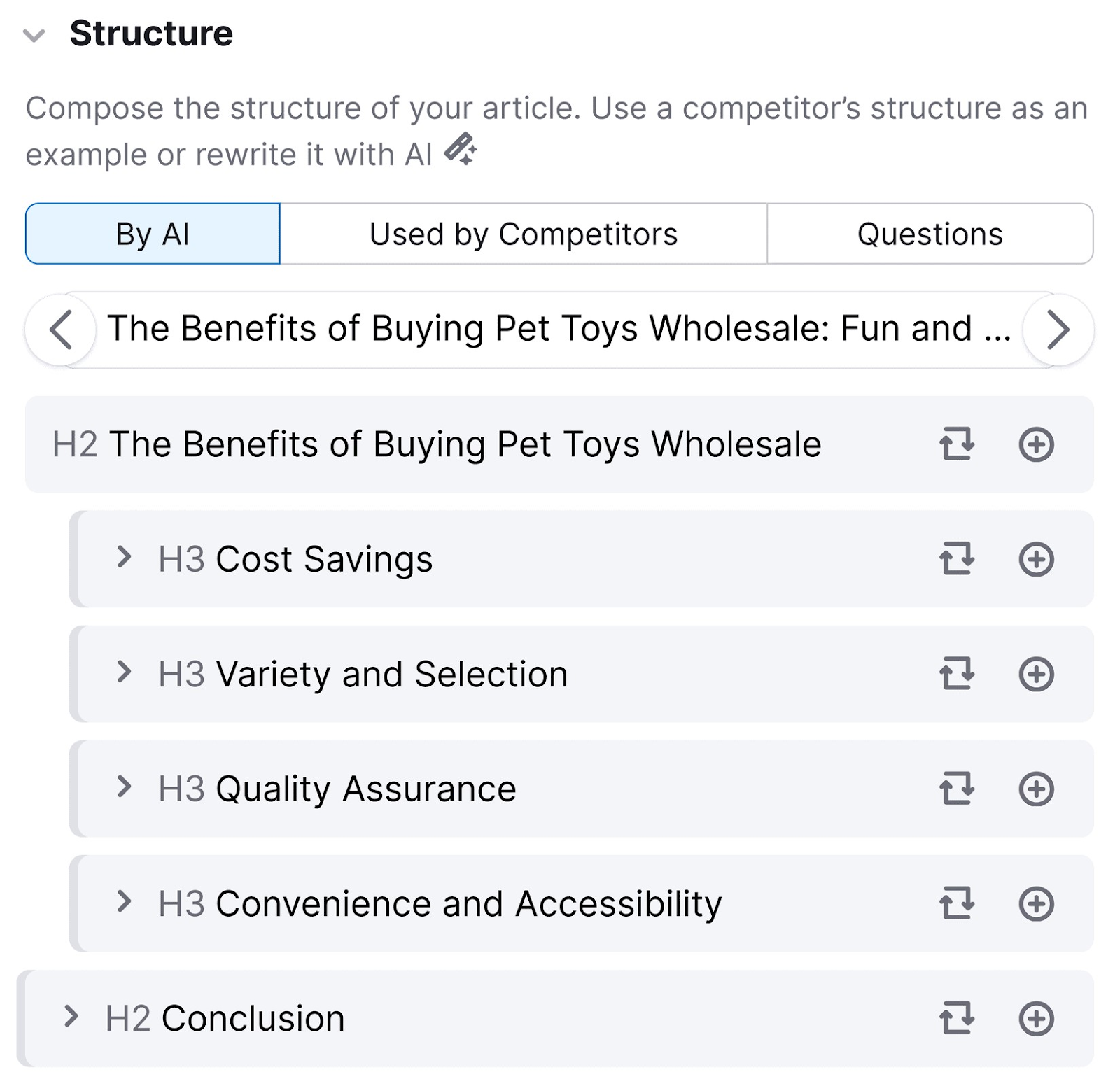
Once the structure is set, optimize the content for readability, tone of voice, and SEO. Ensure you include all target keywords:
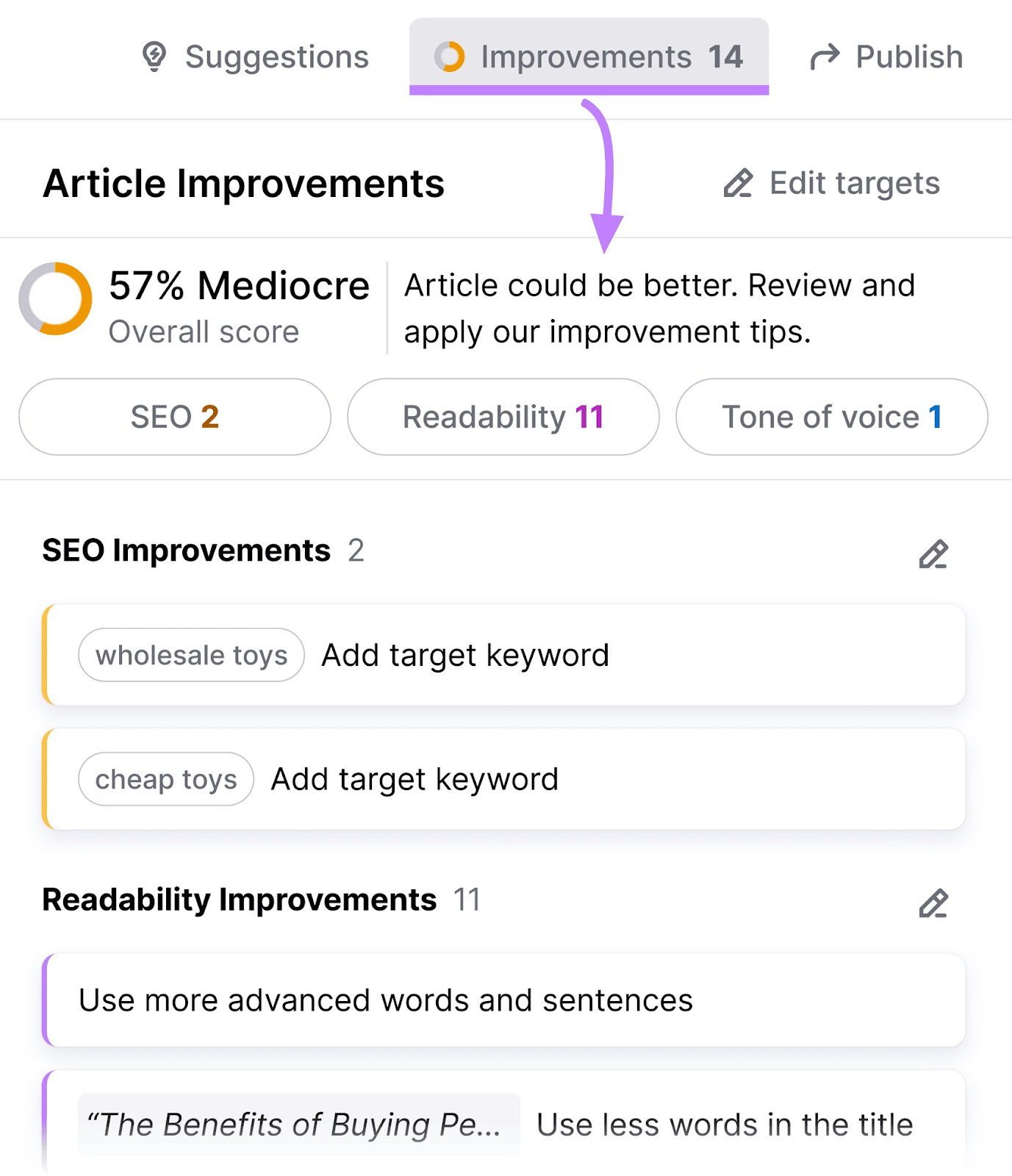
Overall, this tool makes the AI content generation process much easier and helps you rank high in search.
Pricing
You can get a 7-day free trial to test the tool.
A $60 monthly subscription allows you to compose and rewrite unlimited articles with SEO data, unlimited AI suggestions and one-click WordPress publishing.
6. Frase: Best for Content Briefs
Frase is a content optimization tool and AI writer that excels at creating briefs.
Putting together a high-quality content brief usually means hours of SERP research to identify the ideal content length, topics, keywords, and competitors. Frase automates this process to create SEO briefs in seconds.
The tool’s automated content briefs analyze the top 20 search results for your keyword. It also lets you choose which of the following sections to include in your brief:
- Guidelines (e.g., sources, average word count, header, links, and images)
- Related questions
- Top 20 search results
- Most important topics
- Topic clusters (overarching topics and subtopics)
- Relevant headers and subheaders
- Questions asked in competitor content
- Statistics and factual information
- External links
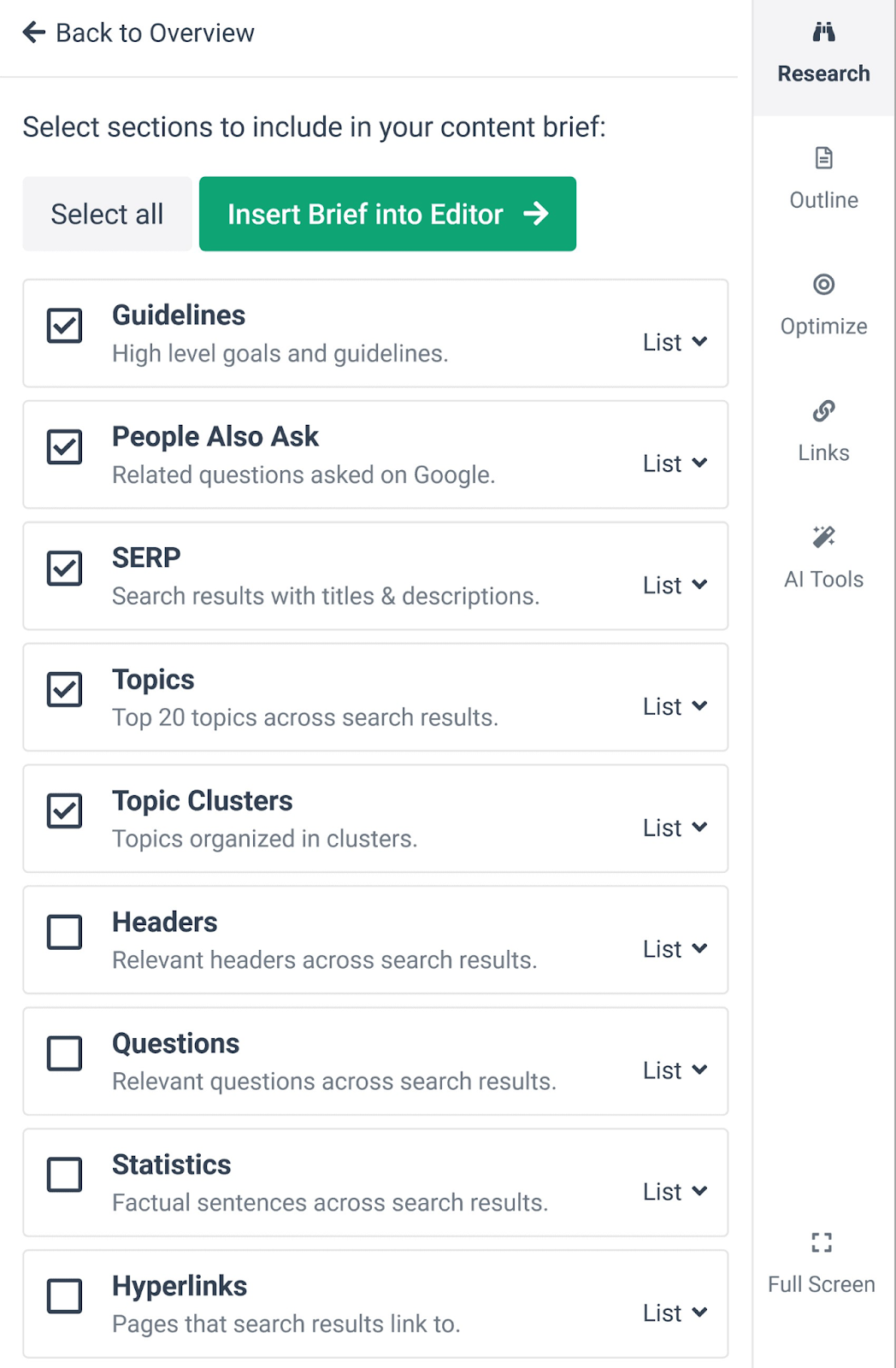
Clicking any of these options adds it to your brief so that you, your team, or freelancers have the information necessary to create content that meets intent.
Briefs are Frase’s standout feature, but not its only offering. Its AI toolkit can also do the following:
- Create new content
- Optimize existing content
- Find opportunities to improve content
For writers who want an all-in-one solution to automate the content creation process, it’s a worthy platform.
Pricing
Frase offers a five-day trial for $1. Once this has expired, you can upgrade to a Solo plan for $14.99 per month.
If you require more than one article a week, the Basic package lets you plan, write, and optimize 30 articles a month for $44.99 per month. Team users can plan, write, and optimize unlimited articles for $114.99 per month.
7. AI Social Content Generator: Best for Social Media Post Generation
The AI Social Content Generator generates entire social posts, including the image or video and caption, using AI.
Simply give the tool a topic for your posts and give the tool more information about your branding.
Then, hit “Generate Posts.”
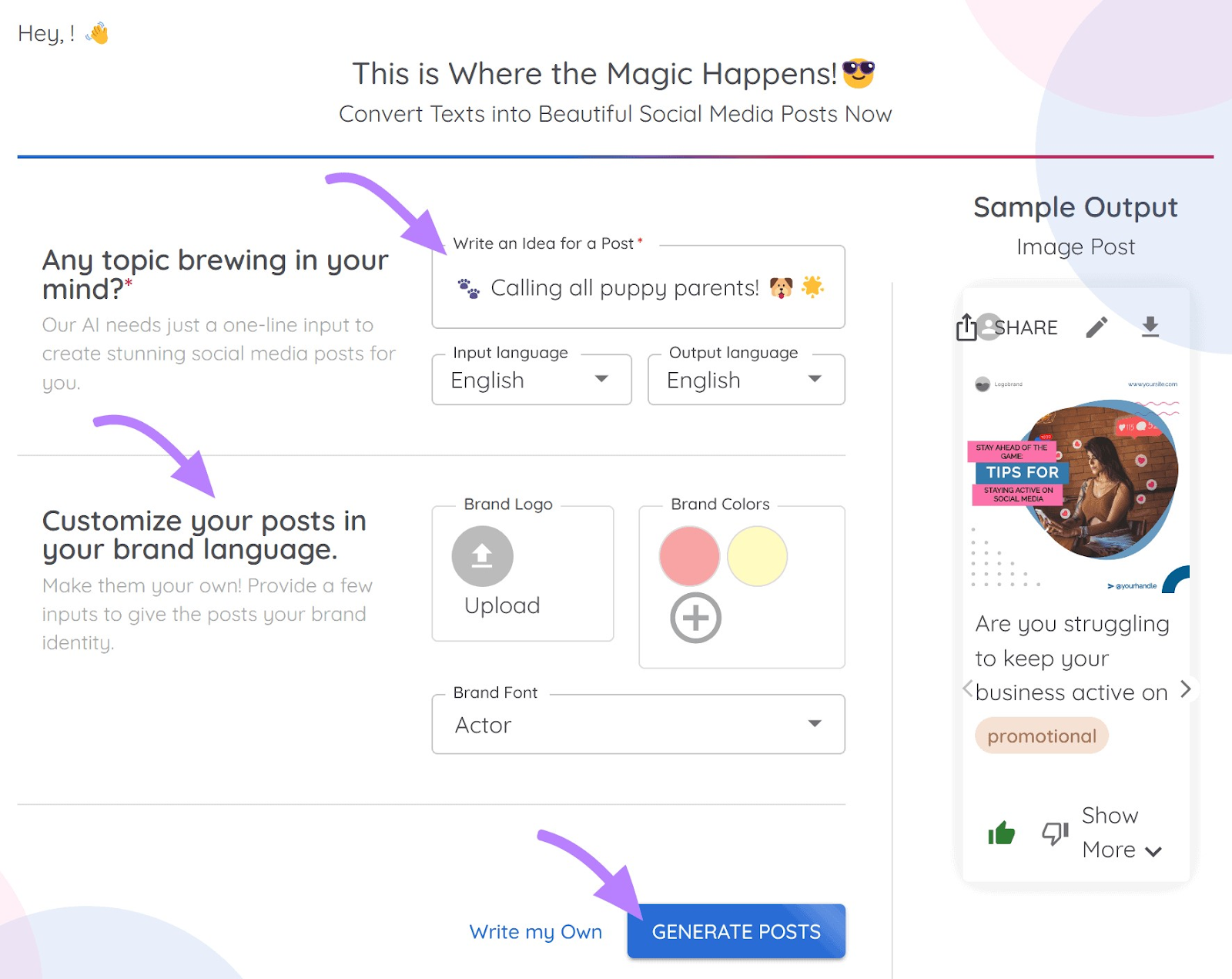
The tool will then generate two posts for you: One with a video and one with an image.
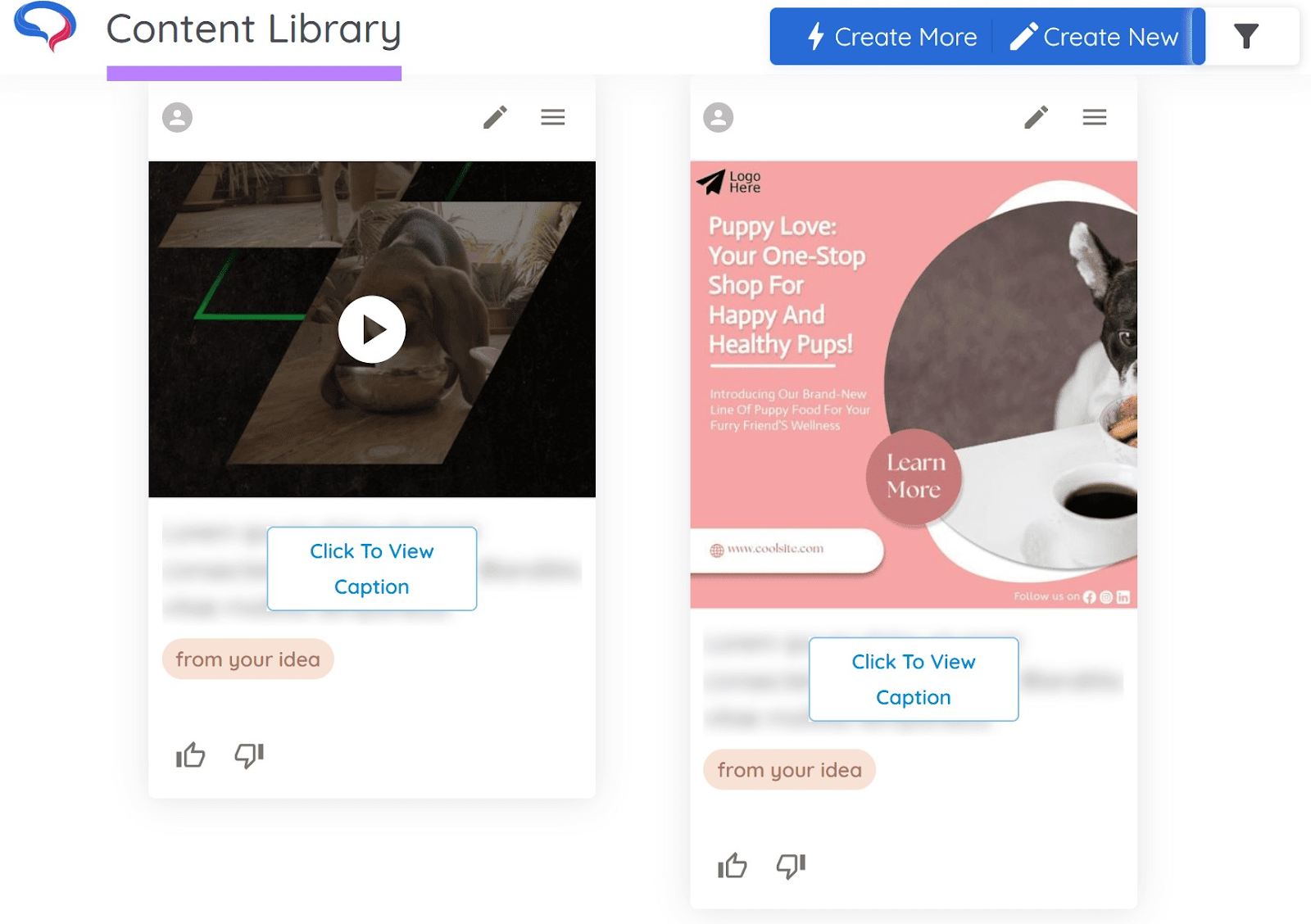
Click on one of the posts to edit it.
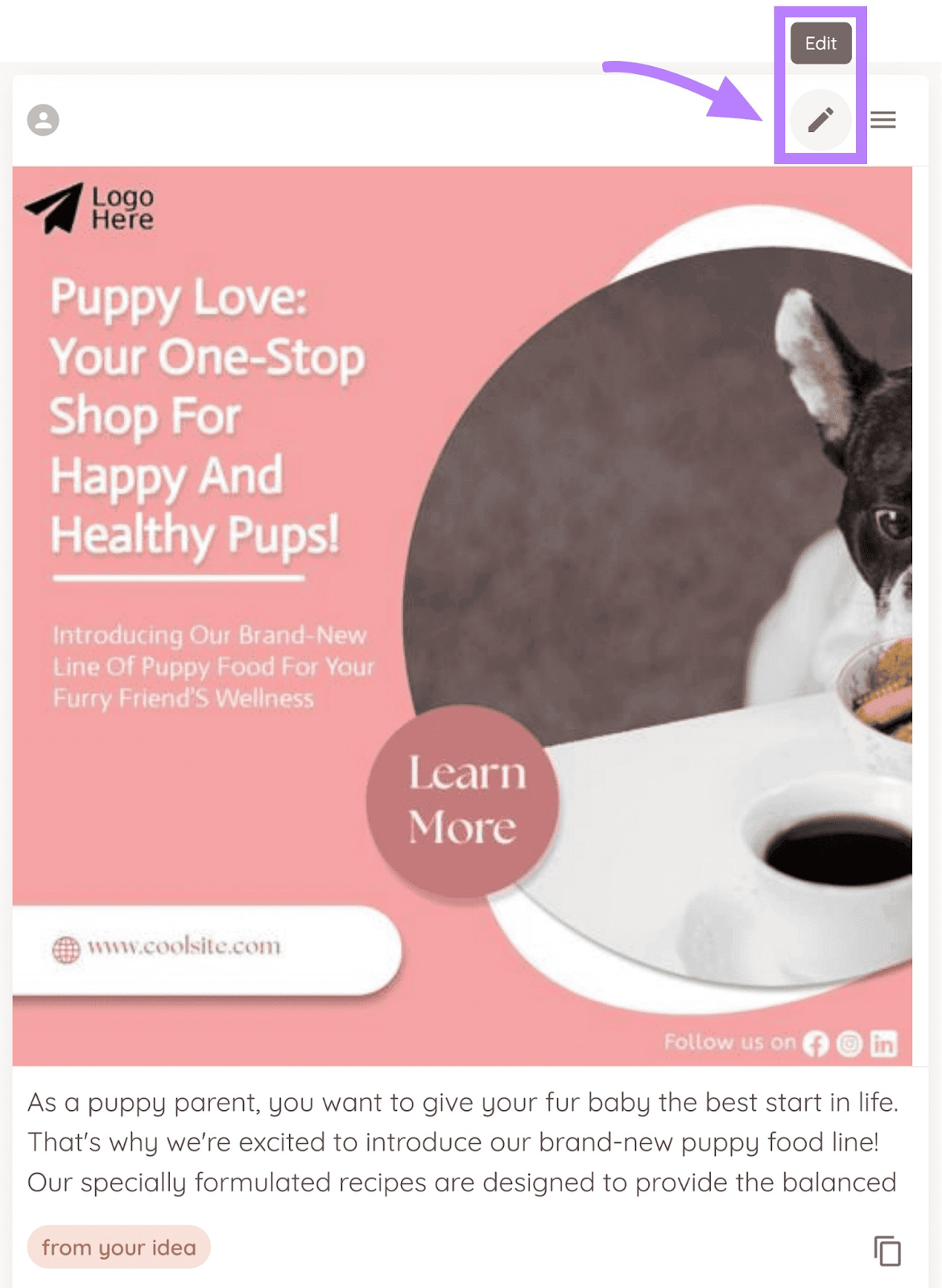
Or click on “Create More” to get more posts for the same topic.
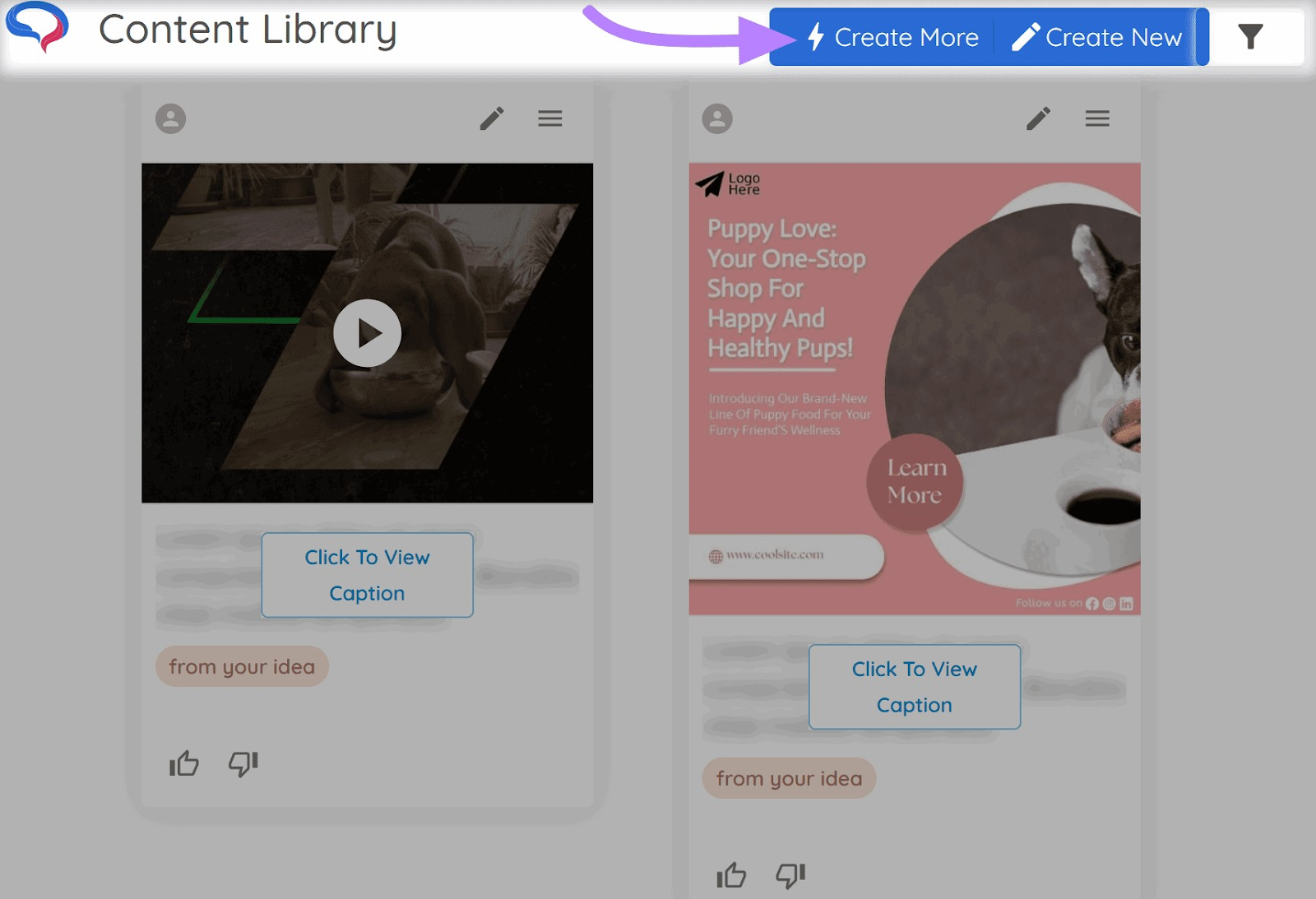
Then, do a competitor analysis to see what your competitors are doing on social media. And find out what works for them.
Click on the competitor analysis icon in the left-side menu. And enter your competitor’s social media handles in the spaces provided.
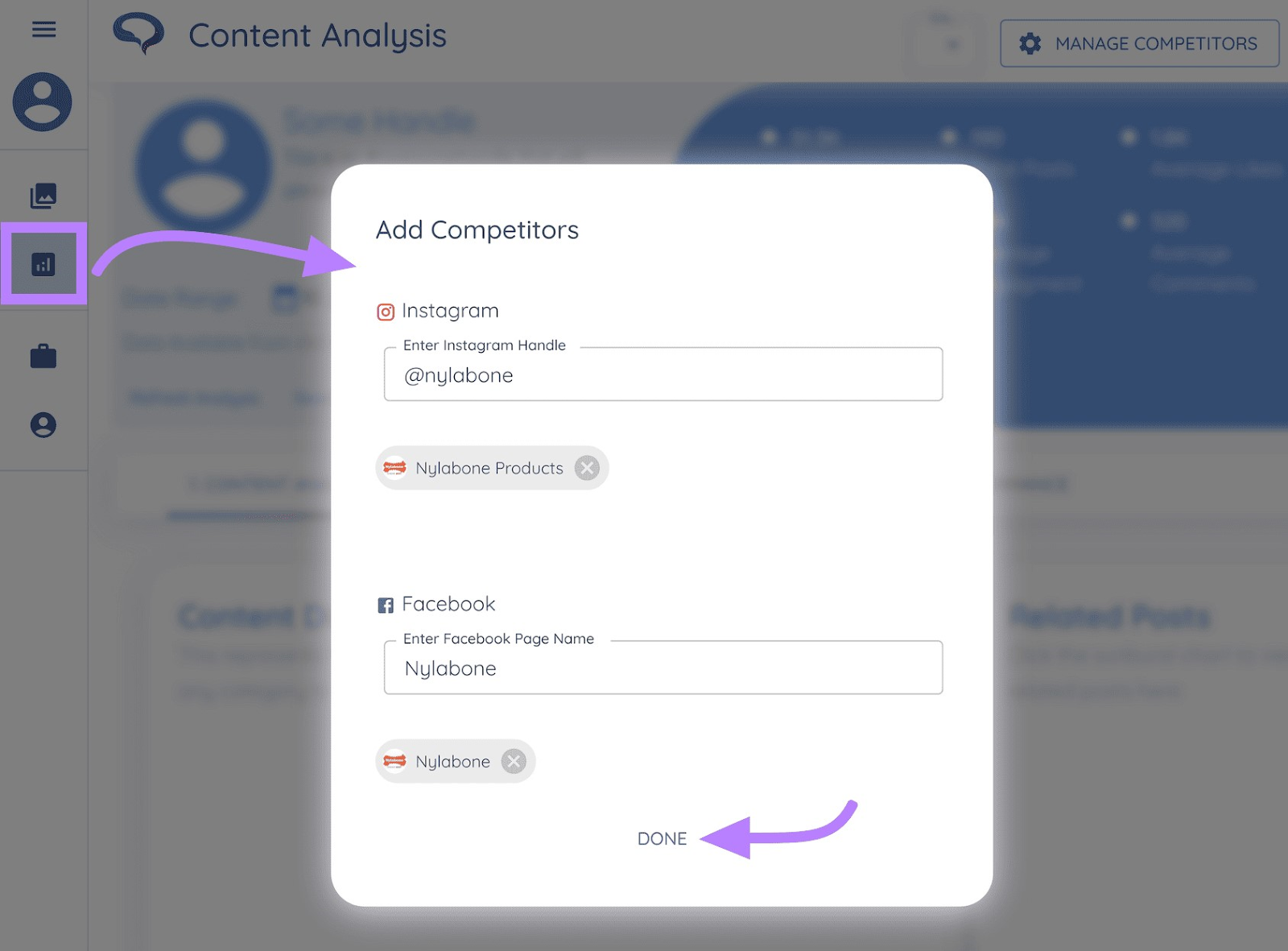
Give the tool a few minutes to gather data. And then check out the dashboard to see the following information:
- What the broad topics of their posts are
- Which of those topics their followers engage with the most
- What post types they use (single post, carousel, or video)
- Which post types their followers engage with the most
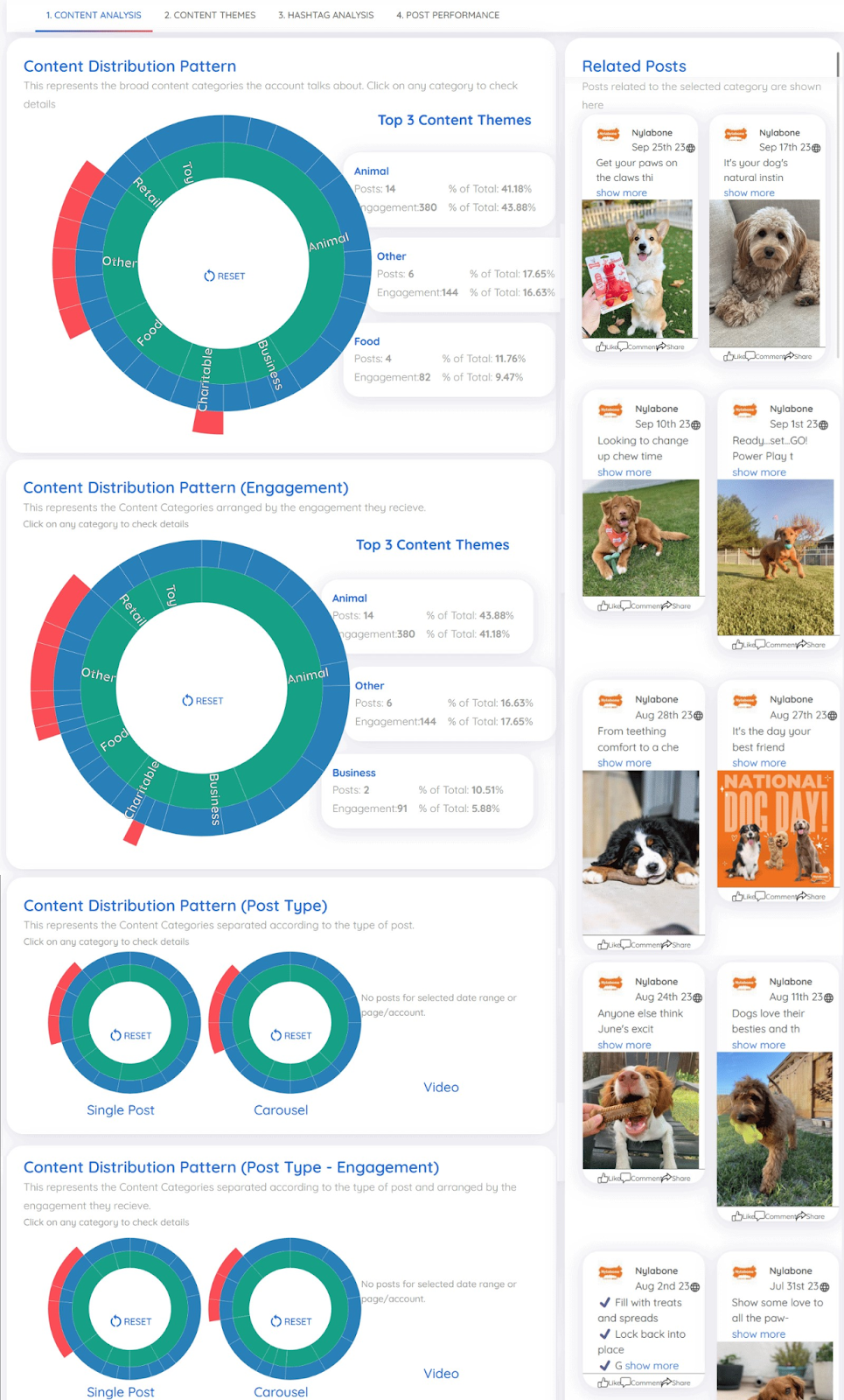
You can also go to the “Content Themes” tab to see more specific data about each post topic. And sample posts.
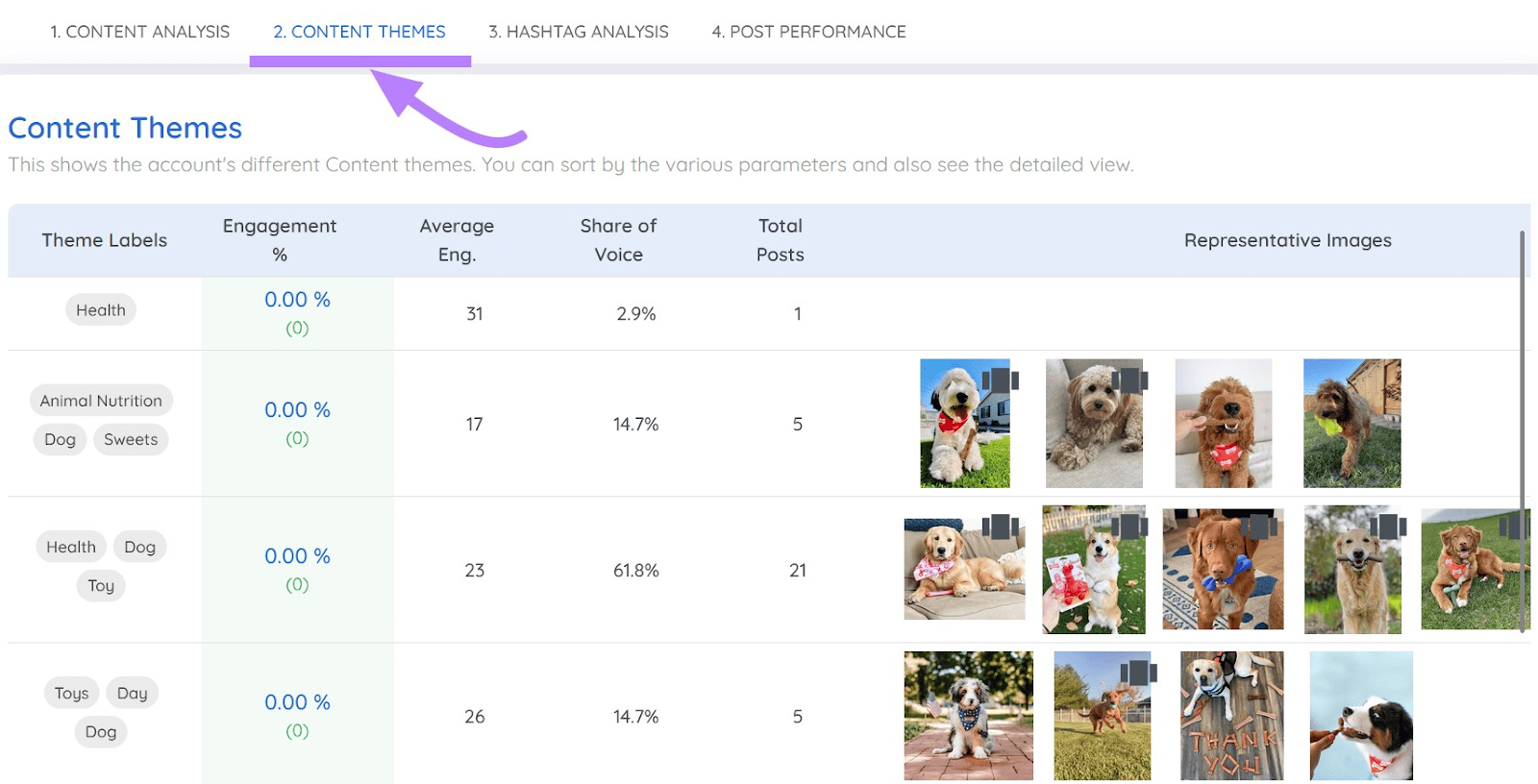
Or go to the “Hashtag Analysis” tab to see which hashtags your competitor uses the most.
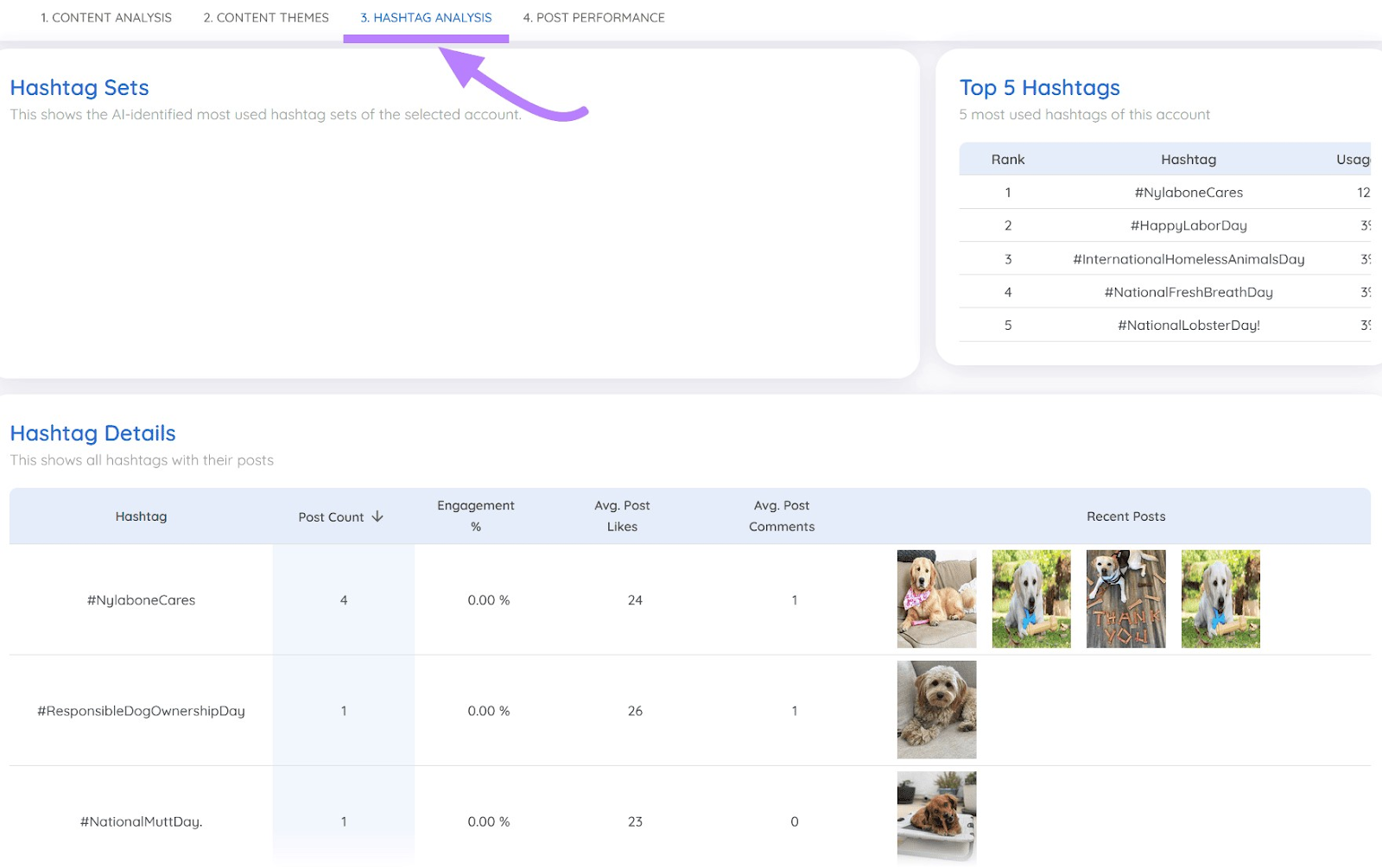
Definitely check out the AI Social Content Generator if you want a tool to create your posts for you.
Pricing
The AI Social Content Generator offers a free 7-day trial. And then costs $35 per month after that.
8. Missinglettr: Best for Social Media Campaign Automation
Missinglettr is an all-in-one social media platform that helps you automate social media campaigns.
It includes several features that simplify the process of creating and publishing social content. One of its most useful automation features is Drip Campaigns.
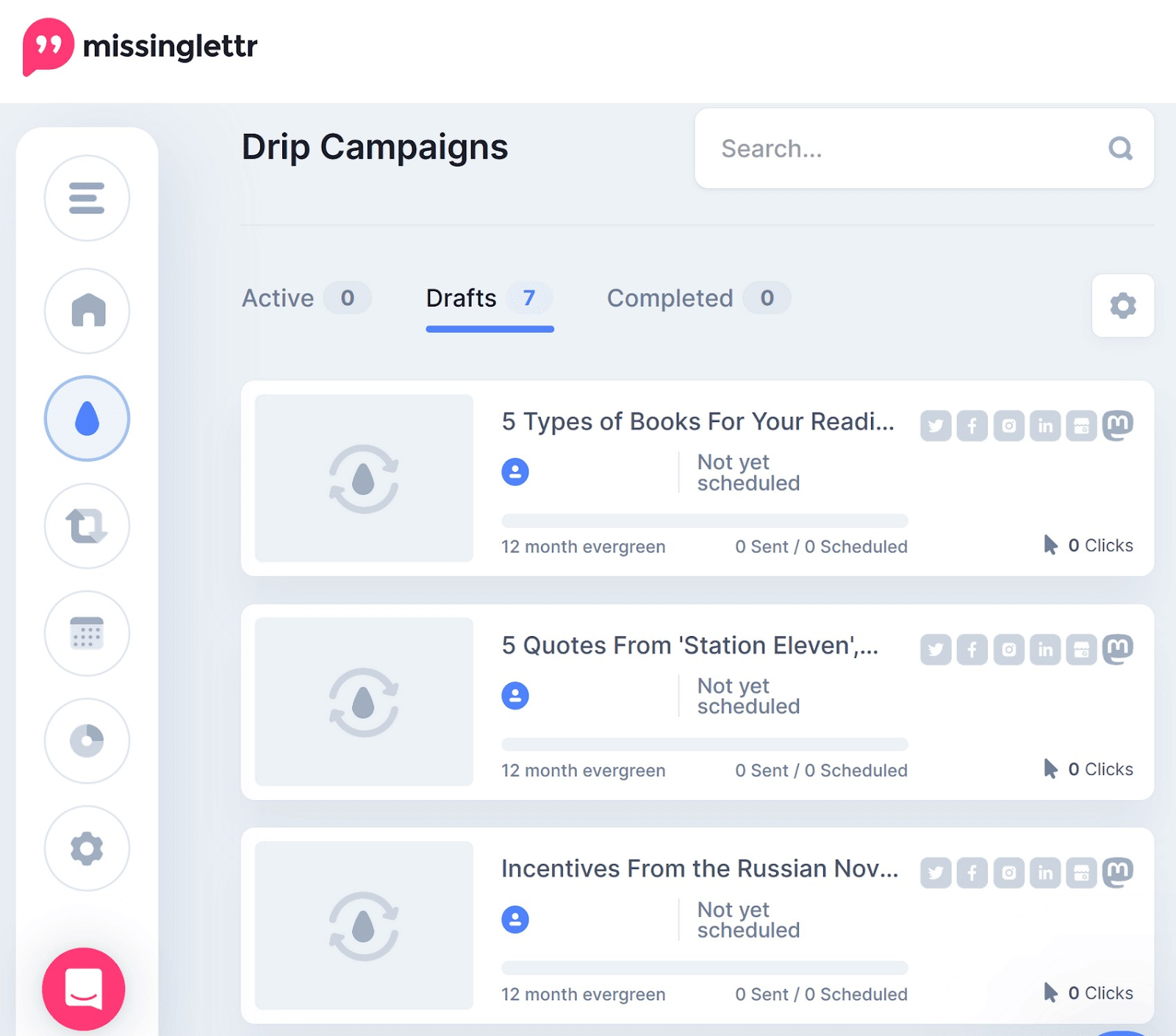
Enter your blog URL, and Misslettr’s AI technology scans the content, finds the right hashtags and images, and turns them into social media posts.
It then places these posts into a personalized social media calendar.
The tool can also automate drip campaigns to publish posts to your social channels at the best times. It also has an analytics dashboard where you can track the performance of your campaigns.
Pricing
Missinglettr has a free forever plan for one workspace, one social profile, and 50 scheduled posts. Solo plans accommodate three social profiles and 500 scheduled posts for $9 per month.
For teams, the Pro plan gives you three workspaces, nine social profiles, 3,000 posts, and unlimited users for $39 per month. You can try either of the paid versions for free with a 14-day free trial.
9. Grammarly: Best for Editing and Proofreading
Grammarly is a writing assistant that automates editing to improve the quality of your content.
Use its AI editor to scan text for grammatical errors, inconsistencies in tone, and plagiarism. Grammarly also makes recommendations for tweaking sentence structure so that your copy flows better:
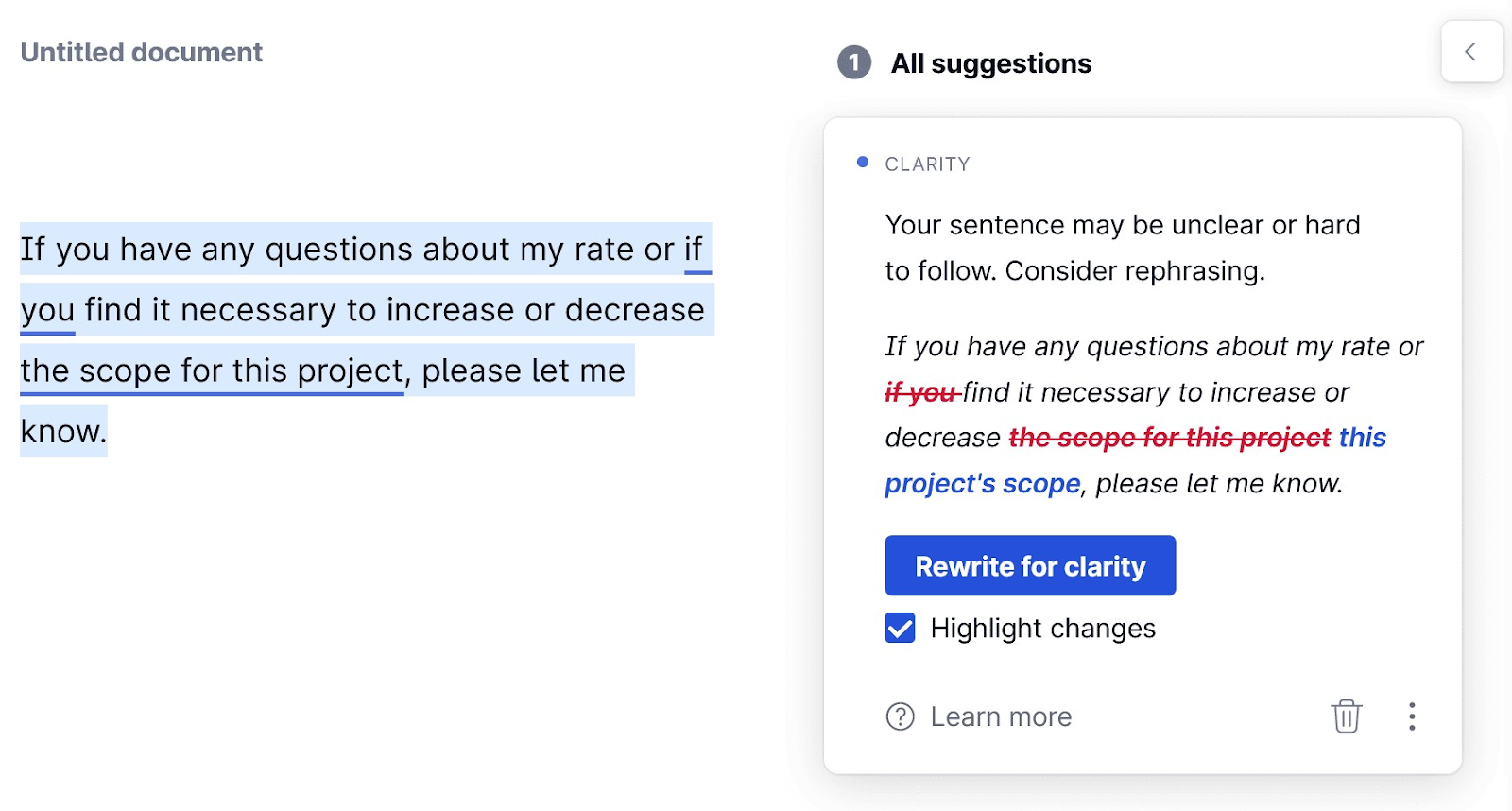
You can edit content by pasting text into the app or web platform, but the tool excels as a real-time editor.
Pricing
Grammarly is free to use for basic writing suggestions and tone detection with no restrictions on usage.
The premium plan that gives you access to vocabulary ideas, tone suggestions, and clarity starts at $12 per month. The Business plan for teams starts at $15 per member per month.
10. ActiveCampaign: Best for Email Distribution
ActiveCampaign is a digital marketing platform that automates common email interactions so you can get time back in your day.
These automations work through behavioral triggers.
For example, if you want to follow up with contacts who visit your landing page, you can set ActiveCampaign to send them an email an hour later asking if they want to learn more:
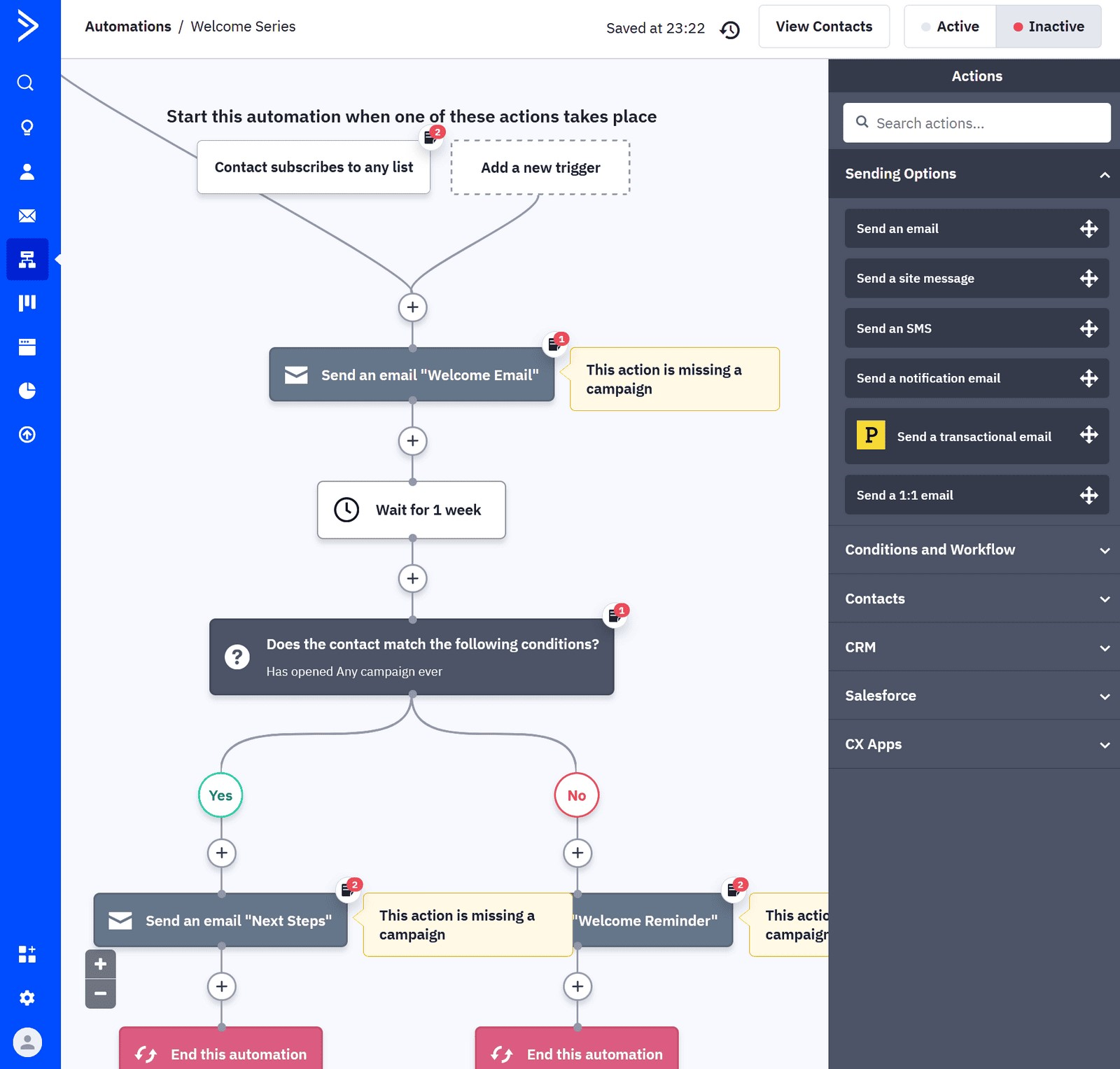
If a contact responds to your email, you can trigger a notification to the sales team to follow up. Which is a great way to increase engagement and boost conversions.
By pulling in data from your website, social channels, and ad campaigns, ActiveCampaign can also segment your audience to automatically highlight relevant content (e.g., introductory emails to new subscribers or special offers to existing customers).
This helps you create personal interactions at scale to create stronger customer experiences.
Pricing
ActiveCampaign’s email and marketing automation plans start at $29 per month for solo users. Its Plus plan for small teams is $49 per month.
For larger teams, a Professional plan is $149 per month. Enterprise companies that need ten or more users can get a customized plan.
To see if the platform is right for your business, you can try ActiveCampaign free for 14 days.
Streamline Your Workload with Semrush
Content automation makes the process of creating, optimizing, and distributing content so much easier—and faster.
Collaborate with the software you use. Let automation handle 80% of the work and dedicate 20% of your time to checking for errors, editing, and optimizing for the best results.
Figure out which tools your team needs to become more efficient and try them out. Here are our suggestions:
- Keyword Magic Tool: For keyword research
- Keyword Overview: For specific keyword data
- Keyword Manager: For idea generation and topic clustering
- ContentShake: For AI content creation and optimization
- SEO Writing Assistant: For content optimization
- Position Tracking: For tracking how well you rank for your target keywords
- Site Audit: For full website analytics and optimization
- ImapctHero: For content analysis
Sign up to Semrush to try out all the tools above for free!
